Paul van Yperen's Blog, page 251
December 3, 2018
Suzy Parker
American model and actress Suzy Parker (1932–2003) was known in the 1950s as the most photographed woman in the world and is now considered as the very first Supermodel. The red-headed beauty defined glamour in the 1950s and in 1956, at the height of her modelling career, became the first model to earn $100,000 per year. During the late 1950s and early 1960s, Parker also became the glamorous star of several Hollywood productions.

Italian postcard by Rotalfoto, Milano, no. 89.
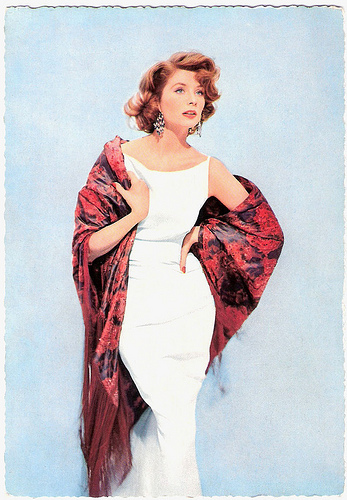
German postcard by Krüger, no. 902/10. Photo: Terb Agency.
The signature face of Chanel
In 1932, Suzy Parker was born Cecilia Ann Renee Parker in Long Island City, New York, to George and Elizabeth Parker. George disliked the name Cecilia and called her Susie, a name which Parker would retain throughout her life. A French Vogue photographer later changed the spelling to Suzy.
Parker's family moved to Highland Park, New Jersey, and then to Florida. When Parker was 15, sister Dorian (a.k.a. Leigh Parker), herself one of the top models of the era, introduced her to Eileen Ford. In the period just after World War II, models were becoming celebrities and Suzy would become even more famous than Dorian.
A photo of the 15-year-old appeared that year in Life magazine and one of her first magazine advertisements was for DeRosa Jewelry. While still in high school in Jacksonville, Fla., she modelled in the summers for Ford Models, and after graduation went to work full time for the agency. Although she still lived with her parents in Florida, she stayed in New York City with Dorian when she had modelling assignments there.
Dorian introduced Parker to her fashion-photographer friends, Irving Penn, Horst P. Horst, John Rawlings, and a young Richard Avedon. Parker became Avedon's muse and the so-called signature face of the Coco Chanel brand. Along with other models like Dovima and Lisa Fonssagrives, Parker signified a postwar world of stylish promise for all. She was the first model to earn $200 per hour and $100,000 per year (ca. 900,000 today). Vogue declared her one of the faces of the confident, post-war American woman.
She worked non-stop for labels as Revlon, Hertz, Westinghouse, Max Factor, Bliss, DuPont, Simplicity, Smirnoff, and Ronson shavers. Parker also was on the covers of about 70 magazines around the world, including Vogue, Elle, Life, Look, and Paris Match. In the mid-1950s she abandoned being a cover girl for a few years to be a photographer herself, apprenticing with Henri Cartier-Bresson in Paris and working for the French edition of Vogue.
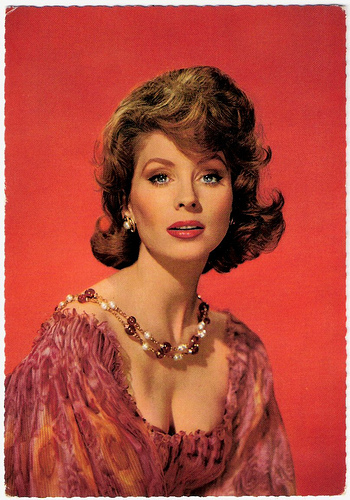
German postcard by Krüger, nr. 902/78.
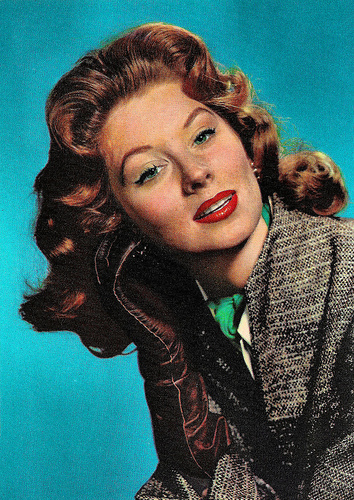
Italian postcard by Rotalfoto, Milano, no. N 131.
Icy sophistication as trademark
Suzy Parker's next step was a Hollywood career. Photographer Richard Avedon recommended her for a fashionable cameo in Funny Face (Stanley Donen, 1957), starring Audrey Hepburn and Fred Astaire.
Douglas Martin in the New York Times : "Parker's trademark in photographs and later on the movie screen was icy sophistication, often likened to that of Grace Kelly , but in person she exuded a girl-next-door prettiness and a sort of wacky loquaciousness. Audrey Hepburn 's role in Funny Face, as a fast-talking beatnik who somewhat unwillingly becomes a world-famous model, was inspired by her".
Suzy herself was on screen for just two minutes in a musical number described as 'Think Pink number'. But director Stanley Donen then gave her a leading role in his comedy Kiss Them for Me (Stanley Donen, 1957), opposite Cary Grant and Jayne Mansfield . However, the film was a disappointment and Parker's acting got negative reviews.
Parker got better reviews for her next appearances in the dramas Ten North Frederick (Philip Dunne, 1958) with Gary Cooper, and The Best of Everything (Jean Negulesco, 1959). During the shooting of the British war film A Circle of Deception (Jack Lee, 1960), she met future husband Bradford Dillman. Her later films include Flight from Ashiya (Michael Anderson, 1964) with Yul Brynner , and Chamber of Horrors (Hy Averback, 1966).
She also played dramatic roles in TV shows such as Burke's Law (1963) plus appearances as herself on a number of quiz shows such as I've Got a Secret. Her most famous television appearance was in a 1963 episode of Twilight Zone in which she played six different parts. Parker's last role was in a 1970 episode of Night Gallery.
She did, in a way, make one other film 'appearance' in The Beatles ' documentary film Let It Be (Michael Lindsay-Hogg, 1970), in which the band performed their song Suzy Parker. The song, one of the few credited as written by all four Beatles, was part of their Academy Award-winning score for the original songs they performed in the film.
Suzy Parker was married three times. In 1950, she married her high-school sweetheart, Ronald Staton, and divorced him in 1953. In 1955, Parker married French journalist Pierre de la Salle with whom she had a daughter, Georgia. They divorced in 1961. In 1963 she became Suzy Parker Dillman after marrying Bradfor Dillman.
After a car accident in 1964, Parker mostly retired from modelling and focused on her family. She had three more children with Bradford Dillman: daughter Dinah (born 1965) and sons Charlie (1967) and Christopher (1969). The family lived in Bel Air, Los Angeles, until Dinah was bitten by a rattlesnake in the yard and almost died. They then moved to Montecito in the Santa Barbara area, where Suzy Parker remained until her death in 2003. She was 69.
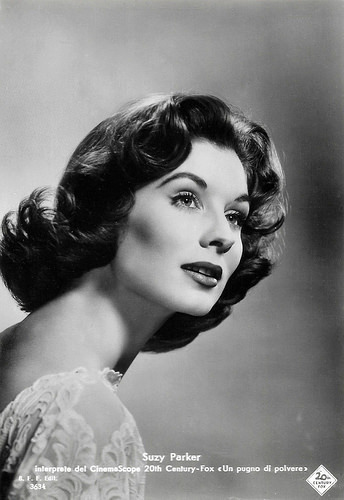
Italian postcard by B.F.F. Edit. (Ballerini & Fratini, Firenze), no. 3634. Photo: 20th Century Fox. Publicity still for Ten North Frederick (Philip Dunne, 1958).
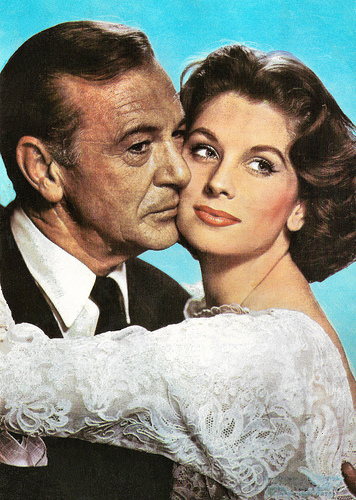
Romanian postcard by Casa Filmului ACIN. Photo: publicity still for Ten North Frederick (Philip Dunne, 1958) with Gary Cooper.
Sources: Douglas Martin (New York Times), Wikipedia and .

Italian postcard by Rotalfoto, Milano, no. 89.

German postcard by Krüger, no. 902/10. Photo: Terb Agency.
The signature face of Chanel
In 1932, Suzy Parker was born Cecilia Ann Renee Parker in Long Island City, New York, to George and Elizabeth Parker. George disliked the name Cecilia and called her Susie, a name which Parker would retain throughout her life. A French Vogue photographer later changed the spelling to Suzy.
Parker's family moved to Highland Park, New Jersey, and then to Florida. When Parker was 15, sister Dorian (a.k.a. Leigh Parker), herself one of the top models of the era, introduced her to Eileen Ford. In the period just after World War II, models were becoming celebrities and Suzy would become even more famous than Dorian.
A photo of the 15-year-old appeared that year in Life magazine and one of her first magazine advertisements was for DeRosa Jewelry. While still in high school in Jacksonville, Fla., she modelled in the summers for Ford Models, and after graduation went to work full time for the agency. Although she still lived with her parents in Florida, she stayed in New York City with Dorian when she had modelling assignments there.
Dorian introduced Parker to her fashion-photographer friends, Irving Penn, Horst P. Horst, John Rawlings, and a young Richard Avedon. Parker became Avedon's muse and the so-called signature face of the Coco Chanel brand. Along with other models like Dovima and Lisa Fonssagrives, Parker signified a postwar world of stylish promise for all. She was the first model to earn $200 per hour and $100,000 per year (ca. 900,000 today). Vogue declared her one of the faces of the confident, post-war American woman.
She worked non-stop for labels as Revlon, Hertz, Westinghouse, Max Factor, Bliss, DuPont, Simplicity, Smirnoff, and Ronson shavers. Parker also was on the covers of about 70 magazines around the world, including Vogue, Elle, Life, Look, and Paris Match. In the mid-1950s she abandoned being a cover girl for a few years to be a photographer herself, apprenticing with Henri Cartier-Bresson in Paris and working for the French edition of Vogue.

German postcard by Krüger, nr. 902/78.

Italian postcard by Rotalfoto, Milano, no. N 131.
Icy sophistication as trademark
Suzy Parker's next step was a Hollywood career. Photographer Richard Avedon recommended her for a fashionable cameo in Funny Face (Stanley Donen, 1957), starring Audrey Hepburn and Fred Astaire.
Douglas Martin in the New York Times : "Parker's trademark in photographs and later on the movie screen was icy sophistication, often likened to that of Grace Kelly , but in person she exuded a girl-next-door prettiness and a sort of wacky loquaciousness. Audrey Hepburn 's role in Funny Face, as a fast-talking beatnik who somewhat unwillingly becomes a world-famous model, was inspired by her".
Suzy herself was on screen for just two minutes in a musical number described as 'Think Pink number'. But director Stanley Donen then gave her a leading role in his comedy Kiss Them for Me (Stanley Donen, 1957), opposite Cary Grant and Jayne Mansfield . However, the film was a disappointment and Parker's acting got negative reviews.
Parker got better reviews for her next appearances in the dramas Ten North Frederick (Philip Dunne, 1958) with Gary Cooper, and The Best of Everything (Jean Negulesco, 1959). During the shooting of the British war film A Circle of Deception (Jack Lee, 1960), she met future husband Bradford Dillman. Her later films include Flight from Ashiya (Michael Anderson, 1964) with Yul Brynner , and Chamber of Horrors (Hy Averback, 1966).
She also played dramatic roles in TV shows such as Burke's Law (1963) plus appearances as herself on a number of quiz shows such as I've Got a Secret. Her most famous television appearance was in a 1963 episode of Twilight Zone in which she played six different parts. Parker's last role was in a 1970 episode of Night Gallery.
She did, in a way, make one other film 'appearance' in The Beatles ' documentary film Let It Be (Michael Lindsay-Hogg, 1970), in which the band performed their song Suzy Parker. The song, one of the few credited as written by all four Beatles, was part of their Academy Award-winning score for the original songs they performed in the film.
Suzy Parker was married three times. In 1950, she married her high-school sweetheart, Ronald Staton, and divorced him in 1953. In 1955, Parker married French journalist Pierre de la Salle with whom she had a daughter, Georgia. They divorced in 1961. In 1963 she became Suzy Parker Dillman after marrying Bradfor Dillman.
After a car accident in 1964, Parker mostly retired from modelling and focused on her family. She had three more children with Bradford Dillman: daughter Dinah (born 1965) and sons Charlie (1967) and Christopher (1969). The family lived in Bel Air, Los Angeles, until Dinah was bitten by a rattlesnake in the yard and almost died. They then moved to Montecito in the Santa Barbara area, where Suzy Parker remained until her death in 2003. She was 69.

Italian postcard by B.F.F. Edit. (Ballerini & Fratini, Firenze), no. 3634. Photo: 20th Century Fox. Publicity still for Ten North Frederick (Philip Dunne, 1958).

Romanian postcard by Casa Filmului ACIN. Photo: publicity still for Ten North Frederick (Philip Dunne, 1958) with Gary Cooper.
Sources: Douglas Martin (New York Times), Wikipedia and .
Published on December 03, 2018 22:00
December 2, 2018
Hoot Gibson
Hoot Gibson (1892-1962) was a rodeo champion and pioneering cowboy star of silent Westerns. With his easy combination of light, breezy, boyish charm comedy and riding abilities, Hoot filled a gap between the austere William S. Hart and the flamboyant Tom Mix and appealed both to adults (especially women) and kids. During the 1920s, he was one of the most popular children's matinee heroes, ranking second only to Mix, and one of Universal's top paid stars. In his real life, however, he had an expensive love for fast cars, motorcycles and airplanes and lead a rather painful rags-to-riches-and-back-to-rags career.
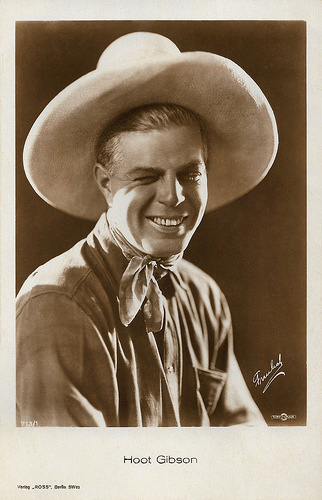
German postcard by Ross Verlag, no. 713/1, 1925-1926. Photo: Roman Freulich / Unifilman (Universal).
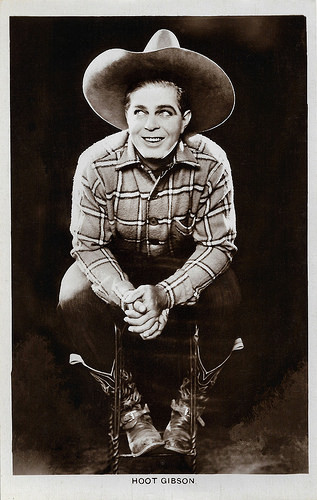
British postcard in the Picturegoer Series, London, no. 66a.
Horse Crazy
Hoot Gibson was born Edmund Richard Gibson in 1892, in Tekamah, Nebraska. As a child he grew up 'horse crazy' and received his first pony at the age of two and a half. His family moved to California when he was seven.
At age 13, the adventurous youth ran away from home and joined a circus for a time. At B-Westerns.com, Hoot later recalled: "First job I got was on the Postal Telegraph. I was then 15. I rode that for about three months and liked it fairly well. I got a job at the Owl Drug Co., delivering drugs and packages to the different homes throughout southern California or that part of Los Angeles. That is where I got the name of Hoot. It came from Owl and later the boys started calling me Hoot Owl, then it got down to Hoot and Hoot has stuck with me ever since."
Later work included punching cows in both Wyoming and Colorado. While working as a horse wrangler, Hoot developed a strong, active interest in the rodeo scene. In 1907 he signed a four-year contract with the Dick Stanley-Bud Atkinson Wild West Show, which toured throughout the US and later Australia. By 1910 Hoot started his film career with the Selig Polyscope Co. as one of the industry's first stuntmen. He was paid $2.50 for performing stunts, training horses and doubling for Selig stars.
Film director Francis Boggs was looking for experienced cowboys and stunt doubles to appear in his Western short Pride of the Range (Francis Boggs, 1910) starring Tom Mix. Gibson and pal Art Acord did riding and stunting jobs for the film. Gibson made a second film for Boggs, The New Superintendent (Francis Boggs, 1911) with Herbert Rawlinson. Hoot lost a solid Hollywood contact in Boggs, however, when the director and his working partner, producer William Nicholas Selig, were both shot in October, 1911, by a mentally disturbed employee. Selig was injured, but Boggs was killed.
Gibson also found stunt work in such prolific Western shorts as The Two Brothers (David Wark Griffith, 1910), starring Henry Walthall, and His Only Son (Jack Conway, 1912). Acting for Gibson was then a minor sideline, and he continued to forge a name for himself on the rodeo circuit with his pal Art Acord. In 1912, at age 20, he won the title 'All-Around Champion Cowboy' at the famed annual Pendleton (Oregon) Round-Up. He also won the steer-roping World Championship at the Calgary Stampede.
While on the circuit, he met fellow rodeo rider Rose August 'Helen' Wenger. They eventually married and she took on the marquee name of Helen Gibson. She even found film stunt work herself and eventually was chosen to replace Helen Holmes as star of the popular film serial The Hazards of Helen (J. Gunnis Davis a.o., 1914) during mid-filming. Hoot himself had the job doubling Helen Holmes and doing the stunts from horses to trains in the Universal cliffhanger.
Hoot picked up new connections in the film industry with Western star Harry Carey and director John Ford. With Ford, Gibson developed a lasting friendship and working relationship. Gibson gained some momentum as a secondary player in a few of their films, including Cheyenne's Pal (1917), Straight Shooting (1917), The Secret Man (1917) and A Marked Man (1917).
With the American entry into World War I, however, Gibson's film career was put on hold. He joined the US Army, eventually attaining the the rank of sergeant while serving with the Tank Corps, and was honourably discharged in 1919. He returned immediately to Universal and was able to restart his career.
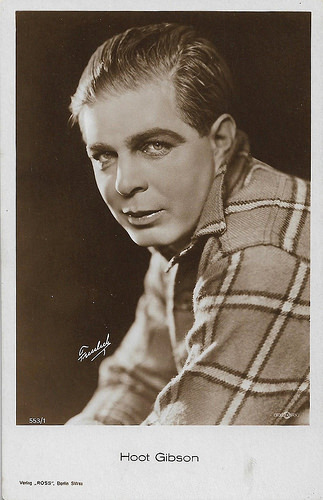
German postcard by Ross Verlag, no. 553/1, 1919-1924. Photo: Unfilman / Roman Freulich.
A certain boyish charm
At Universal, Hoot Gibson quickly worked his way up to co-star status in a series of short Westerns, often directed by John Ford. The two-reelers usually co-starred either Pete Morrison or Hoot's wife Helen, or sometimes both. Films such as The Fighting Brothers (John Ford, 1919), The Black Horse Bandit (Harry Harvey, 1919), Rustlers (John Ford, 1919), Gun Law (John Ford, 1919), The Gun Packer (John Ford, 1919) and By Indian Post (John Ford, 1919) eventually led to his solo starring success.
During this prolific period, he was also directed by George Holt in The Trail of the Holdup Man (1919), Phil Rosen in The Sheriff's Oath (1920) and Lee Kohlmar in The Wild Wild West (1921). Around this time, Hoot and Helen divorced. In the early 1920s, Hoot went on to marry another Helen, vaudeville actress Helen Johnson. They had one child, Lois Charlotte Gibson, born in 1923. The couple divorced in 1927.
By 1921, the demand for cowboy pictures was so great, Gibson began receiving offers for leading roles. Superstardom came with the Western Action (John Ford, 1921), which was taken from The Three Godfathers story. It starred Hoot, Francis Ford and J. Farrell MacDonald as a trio of outlaws on the lam who find a baby. Action propelled Gibson to fame and fortune and he remained at Universal for the next 10 years.
Boyd Magers and Bill Russell at B-Westerns.com : "What made Gibson so popular over the years? He was not what one might call handsome, being a little on the homely side, nor did he cut a dashing figure on horseback, although he could ride like a demon. Neither was he a polished scrapper of the Bob Steele school of fisticuffs, but could mix it up with the best of them. He mostly never wore a gun in the standard cowboy hero way, instead shoved it in his belt or boot. So what made this cowboy hero one of the greats? You could call it character, a certain boyish charm, or simply a naturalness that appealed to the western fan. He had a contagious smile, and while most heroes had a sidekick who provided the comedy routine, Hoot was his own best sidekick."
During his Universal years, Gibson starred in such classics as the exciting The Ridin' Kid from Powder River (Edward Sedgwick, 1924), the humorous Chip of the Flying U (Lynn Reynolds, 1926) and the more serious and dramatic The Flaming Frontier (Edward Sedgwick, 1926) with Dustin Farnum, he would occasionally step out of his Western roles for a non-Western feature. By 1925 Hoot Gibson was making approximately $14,500 a week and spending it about as fast as he was making it.
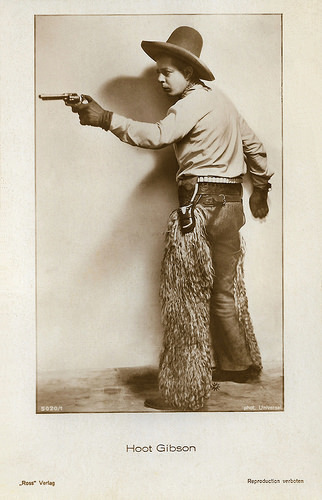
German postcard by Ross Verlag, no. 5020/1, 1930-1931. Photo: Universal. Publicity still for The Galloping Kid (Nat Ross, 1922).
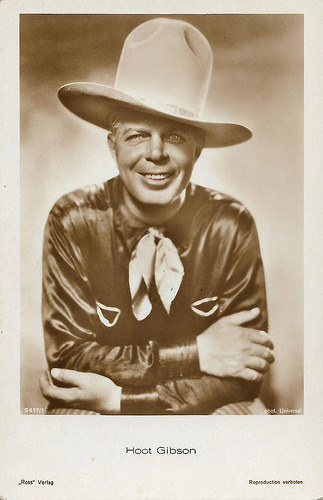
German postcard by Ross Verlag, no. 5417/2, 1930-1931. Photo: Universal.
Airplanes as a large, expensive passion
Hoot Gibson successfully made the transition to talkies and, in 1930, married popular Jazz-era actress Sally Eilers, a third party to his previous divorce. The couple made three features together: The Long, Long Trail (Arthur Rosson, 1929), Trigger Tricks (B. Reeves Eason, 1930) and Clearing the Range (Otto Brower, 1931). When she found celluloid success on her own with the Oscar-winning Bad Girl (Frank Borzage, 1931), Sally decided to split from Hoot professionally and personally. They divorced in 1933.
Hoot lost his Universal contract in 1930, which signified the start of his decline. During the early 1930s, he secured contracts with the Poverty Row outfits Allied Pictures and First Division Pictures, but the quality of his films suffered. Hoot had already begun to feature race cars and airplanes in his films such as The Flyin' Cowboy (B. Reeves Eason, 1928) and The Winged Horseman (B. Reeves Eason, Arthur Rosson, 1929).
Gary Brumburgh at IMDb: "Airplanes in particular became a large, expensive passion of his. In 1933 he crashed his biplane during a National Air Race in Los Angeles, which had pitted him against another cowboy star, Ken Maynard. Fortunately, he survived his injuries."
With the advent of talking films, singing cowboys such as Gene Autry and Roy Rogers were becoming the new rage, and both Hoot and Tom Mix felt the kick. Yet he managed a couple of comebacks by pairing up with others stars. He joined old silent film teammate Harry Carey and 'Guinn Big Boy Williams' in the 'Three Mesquiteers' Western Powdersmoke Range (Wallace Fox, 1935), and was billed second to Ray Corrigan in the Republic serial The Painted Stallion (Alan James, Ray Taylor, William Witney, 1937).
Gary Brumburgh: "Hoot left films and toured with the Robbins Brothers and Russell Brothers circuses during 1938 and 1939 before retiring from show business altogether. His multiple divorces and reckless spending habits had taken their toll on his finances. For a time he found work in real estate before Monogram Pictures offered the stocky-framed actor a chance to return in 1943. Hoot teamed up with cowboy star Ken Maynard in the popular 'Trail Blazers' series, and the duo were later joined by Bob Steele. Chief Thundercloud replaced a difficult Maynard on a couple of the films, but by the end of the series Gibson and Steele were riding alone together."
The nearly dozen films in the series began with Wild Horse Stampede (Alan James, 1943) and ended with Trigger Law (Vernon Keays, 1944), the latter being his last hurrah in films. Hoot then returned to real estate. By the time he appeared as a surprise guest on the popular sitcom I Married Joan (1952) starring Joan Davis, his Western features of the 1930s and 1940s, as well as those of Maynard, Steele and others were a large staple of films seen by a TV audience that couldn't get enough Western fare.
He did a favour for old friend John Ford by appearing in a cameo role in the director's The Horse Soldiers (John Ford, 1959), starring John Wayne and William Holden. His last film spotting was a guest cameo in the 'Rat Pack' film Ocean's Eleven (Lewis Milestone, 1960).
Hoot married a fourth and final time in 1942, to 22 year old yodeler and actress Dorothea Dunstan. This marriage took hold and lasted for 20 years until his death. By the 1960s Gibson was on the verge of financial collapse after a series of bad investments.
Gary Brumburgh: "Diagnosed with cancer in 1960, rising medical costs forced him to find any and all work available. He was relegated at one point to becoming a greeter at a Las Vegas casino and, for a period, worked at carnivals. It was an unhappy end for a cowboy who brought so much excitement and entertainment to children and adults alike."
In 1962, Hoot Gibson died of cancer at the Motion Picture Country Home in Woodland Hills, California, just a couple of weeks after his 70th birthday. He was interred in the Inglewood Park Cemetery in Inglewood, California.
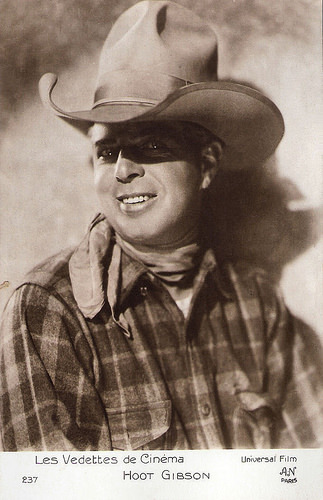
French postcard by in the Les Vedette de Cinéma series by A.N., Paris, no. 237. Photo: Universal Film.
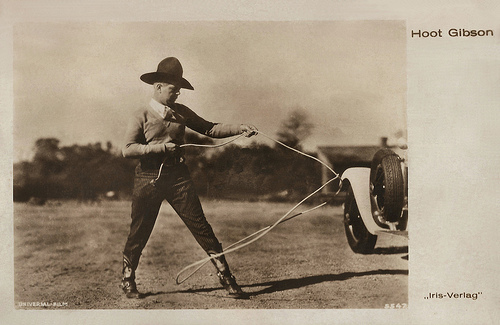
Austrian postcard by Iris-Verlag, no. 5547. Photo: Universal-Film.
Sources: (IMDb), Boyd Magers and Bill Russell (B-Westerns), Wikipedia and .

German postcard by Ross Verlag, no. 713/1, 1925-1926. Photo: Roman Freulich / Unifilman (Universal).

British postcard in the Picturegoer Series, London, no. 66a.
Horse Crazy
Hoot Gibson was born Edmund Richard Gibson in 1892, in Tekamah, Nebraska. As a child he grew up 'horse crazy' and received his first pony at the age of two and a half. His family moved to California when he was seven.
At age 13, the adventurous youth ran away from home and joined a circus for a time. At B-Westerns.com, Hoot later recalled: "First job I got was on the Postal Telegraph. I was then 15. I rode that for about three months and liked it fairly well. I got a job at the Owl Drug Co., delivering drugs and packages to the different homes throughout southern California or that part of Los Angeles. That is where I got the name of Hoot. It came from Owl and later the boys started calling me Hoot Owl, then it got down to Hoot and Hoot has stuck with me ever since."
Later work included punching cows in both Wyoming and Colorado. While working as a horse wrangler, Hoot developed a strong, active interest in the rodeo scene. In 1907 he signed a four-year contract with the Dick Stanley-Bud Atkinson Wild West Show, which toured throughout the US and later Australia. By 1910 Hoot started his film career with the Selig Polyscope Co. as one of the industry's first stuntmen. He was paid $2.50 for performing stunts, training horses and doubling for Selig stars.
Film director Francis Boggs was looking for experienced cowboys and stunt doubles to appear in his Western short Pride of the Range (Francis Boggs, 1910) starring Tom Mix. Gibson and pal Art Acord did riding and stunting jobs for the film. Gibson made a second film for Boggs, The New Superintendent (Francis Boggs, 1911) with Herbert Rawlinson. Hoot lost a solid Hollywood contact in Boggs, however, when the director and his working partner, producer William Nicholas Selig, were both shot in October, 1911, by a mentally disturbed employee. Selig was injured, but Boggs was killed.
Gibson also found stunt work in such prolific Western shorts as The Two Brothers (David Wark Griffith, 1910), starring Henry Walthall, and His Only Son (Jack Conway, 1912). Acting for Gibson was then a minor sideline, and he continued to forge a name for himself on the rodeo circuit with his pal Art Acord. In 1912, at age 20, he won the title 'All-Around Champion Cowboy' at the famed annual Pendleton (Oregon) Round-Up. He also won the steer-roping World Championship at the Calgary Stampede.
While on the circuit, he met fellow rodeo rider Rose August 'Helen' Wenger. They eventually married and she took on the marquee name of Helen Gibson. She even found film stunt work herself and eventually was chosen to replace Helen Holmes as star of the popular film serial The Hazards of Helen (J. Gunnis Davis a.o., 1914) during mid-filming. Hoot himself had the job doubling Helen Holmes and doing the stunts from horses to trains in the Universal cliffhanger.
Hoot picked up new connections in the film industry with Western star Harry Carey and director John Ford. With Ford, Gibson developed a lasting friendship and working relationship. Gibson gained some momentum as a secondary player in a few of their films, including Cheyenne's Pal (1917), Straight Shooting (1917), The Secret Man (1917) and A Marked Man (1917).
With the American entry into World War I, however, Gibson's film career was put on hold. He joined the US Army, eventually attaining the the rank of sergeant while serving with the Tank Corps, and was honourably discharged in 1919. He returned immediately to Universal and was able to restart his career.

German postcard by Ross Verlag, no. 553/1, 1919-1924. Photo: Unfilman / Roman Freulich.
A certain boyish charm
At Universal, Hoot Gibson quickly worked his way up to co-star status in a series of short Westerns, often directed by John Ford. The two-reelers usually co-starred either Pete Morrison or Hoot's wife Helen, or sometimes both. Films such as The Fighting Brothers (John Ford, 1919), The Black Horse Bandit (Harry Harvey, 1919), Rustlers (John Ford, 1919), Gun Law (John Ford, 1919), The Gun Packer (John Ford, 1919) and By Indian Post (John Ford, 1919) eventually led to his solo starring success.
During this prolific period, he was also directed by George Holt in The Trail of the Holdup Man (1919), Phil Rosen in The Sheriff's Oath (1920) and Lee Kohlmar in The Wild Wild West (1921). Around this time, Hoot and Helen divorced. In the early 1920s, Hoot went on to marry another Helen, vaudeville actress Helen Johnson. They had one child, Lois Charlotte Gibson, born in 1923. The couple divorced in 1927.
By 1921, the demand for cowboy pictures was so great, Gibson began receiving offers for leading roles. Superstardom came with the Western Action (John Ford, 1921), which was taken from The Three Godfathers story. It starred Hoot, Francis Ford and J. Farrell MacDonald as a trio of outlaws on the lam who find a baby. Action propelled Gibson to fame and fortune and he remained at Universal for the next 10 years.
Boyd Magers and Bill Russell at B-Westerns.com : "What made Gibson so popular over the years? He was not what one might call handsome, being a little on the homely side, nor did he cut a dashing figure on horseback, although he could ride like a demon. Neither was he a polished scrapper of the Bob Steele school of fisticuffs, but could mix it up with the best of them. He mostly never wore a gun in the standard cowboy hero way, instead shoved it in his belt or boot. So what made this cowboy hero one of the greats? You could call it character, a certain boyish charm, or simply a naturalness that appealed to the western fan. He had a contagious smile, and while most heroes had a sidekick who provided the comedy routine, Hoot was his own best sidekick."
During his Universal years, Gibson starred in such classics as the exciting The Ridin' Kid from Powder River (Edward Sedgwick, 1924), the humorous Chip of the Flying U (Lynn Reynolds, 1926) and the more serious and dramatic The Flaming Frontier (Edward Sedgwick, 1926) with Dustin Farnum, he would occasionally step out of his Western roles for a non-Western feature. By 1925 Hoot Gibson was making approximately $14,500 a week and spending it about as fast as he was making it.

German postcard by Ross Verlag, no. 5020/1, 1930-1931. Photo: Universal. Publicity still for The Galloping Kid (Nat Ross, 1922).

German postcard by Ross Verlag, no. 5417/2, 1930-1931. Photo: Universal.
Airplanes as a large, expensive passion
Hoot Gibson successfully made the transition to talkies and, in 1930, married popular Jazz-era actress Sally Eilers, a third party to his previous divorce. The couple made three features together: The Long, Long Trail (Arthur Rosson, 1929), Trigger Tricks (B. Reeves Eason, 1930) and Clearing the Range (Otto Brower, 1931). When she found celluloid success on her own with the Oscar-winning Bad Girl (Frank Borzage, 1931), Sally decided to split from Hoot professionally and personally. They divorced in 1933.
Hoot lost his Universal contract in 1930, which signified the start of his decline. During the early 1930s, he secured contracts with the Poverty Row outfits Allied Pictures and First Division Pictures, but the quality of his films suffered. Hoot had already begun to feature race cars and airplanes in his films such as The Flyin' Cowboy (B. Reeves Eason, 1928) and The Winged Horseman (B. Reeves Eason, Arthur Rosson, 1929).
Gary Brumburgh at IMDb: "Airplanes in particular became a large, expensive passion of his. In 1933 he crashed his biplane during a National Air Race in Los Angeles, which had pitted him against another cowboy star, Ken Maynard. Fortunately, he survived his injuries."
With the advent of talking films, singing cowboys such as Gene Autry and Roy Rogers were becoming the new rage, and both Hoot and Tom Mix felt the kick. Yet he managed a couple of comebacks by pairing up with others stars. He joined old silent film teammate Harry Carey and 'Guinn Big Boy Williams' in the 'Three Mesquiteers' Western Powdersmoke Range (Wallace Fox, 1935), and was billed second to Ray Corrigan in the Republic serial The Painted Stallion (Alan James, Ray Taylor, William Witney, 1937).
Gary Brumburgh: "Hoot left films and toured with the Robbins Brothers and Russell Brothers circuses during 1938 and 1939 before retiring from show business altogether. His multiple divorces and reckless spending habits had taken their toll on his finances. For a time he found work in real estate before Monogram Pictures offered the stocky-framed actor a chance to return in 1943. Hoot teamed up with cowboy star Ken Maynard in the popular 'Trail Blazers' series, and the duo were later joined by Bob Steele. Chief Thundercloud replaced a difficult Maynard on a couple of the films, but by the end of the series Gibson and Steele were riding alone together."
The nearly dozen films in the series began with Wild Horse Stampede (Alan James, 1943) and ended with Trigger Law (Vernon Keays, 1944), the latter being his last hurrah in films. Hoot then returned to real estate. By the time he appeared as a surprise guest on the popular sitcom I Married Joan (1952) starring Joan Davis, his Western features of the 1930s and 1940s, as well as those of Maynard, Steele and others were a large staple of films seen by a TV audience that couldn't get enough Western fare.
He did a favour for old friend John Ford by appearing in a cameo role in the director's The Horse Soldiers (John Ford, 1959), starring John Wayne and William Holden. His last film spotting was a guest cameo in the 'Rat Pack' film Ocean's Eleven (Lewis Milestone, 1960).
Hoot married a fourth and final time in 1942, to 22 year old yodeler and actress Dorothea Dunstan. This marriage took hold and lasted for 20 years until his death. By the 1960s Gibson was on the verge of financial collapse after a series of bad investments.
Gary Brumburgh: "Diagnosed with cancer in 1960, rising medical costs forced him to find any and all work available. He was relegated at one point to becoming a greeter at a Las Vegas casino and, for a period, worked at carnivals. It was an unhappy end for a cowboy who brought so much excitement and entertainment to children and adults alike."
In 1962, Hoot Gibson died of cancer at the Motion Picture Country Home in Woodland Hills, California, just a couple of weeks after his 70th birthday. He was interred in the Inglewood Park Cemetery in Inglewood, California.

French postcard by in the Les Vedette de Cinéma series by A.N., Paris, no. 237. Photo: Universal Film.

Austrian postcard by Iris-Verlag, no. 5547. Photo: Universal-Film.
Sources: (IMDb), Boyd Magers and Bill Russell (B-Westerns), Wikipedia and .
Published on December 02, 2018 22:00
December 1, 2018
Dustin Hoffman
Dustin Hoffman (1937) is an Oscar–winning American actor with a career in film, television, and theatre since 1960. Short in stature and not typically handsome, Hoffman is known for his versatile portrayals of antiheroes and vulnerable or emotionally explosive characters. He has earned acclaim for his work in such films as The Graduate (1967), Kramer vs. Kramer (1979) and Rain Man (1988). Hoffman made his directorial debut with Quartet (2012).
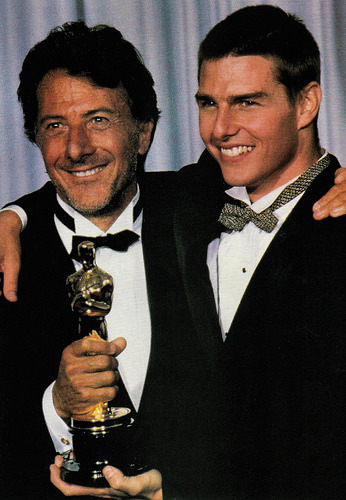
French postcard, no. SL. 4037. The Academy Awards Ceremony 1989: Dustin Hoffman wins the Best Actor Oscar for Rain Man' (Barry Levinson, 1988), with co-star Tom Cruise.
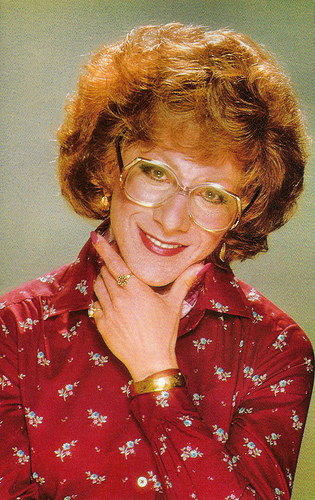
American postcard by Coral-Lee, Rancho Cordova, no. CL/Personality # 113. Photo: Greg Gorman. Publicity still for Tootsie (Sydney Pollack, 1982).
A dedicated method actor
Dustin Lee Hoffman was born in Los Angeles, California, in 1937. His parents were Lillian and Harry Hoffman. His father was a furniture salesman and prop supervisor for Columbia Pictures. Although he is Jewish, Hoffman and his brother were raised in a relatively secular household. Hoffman graduated from Los Angeles High School in 1955.
Hoffman's acting career began at age 19, when he dropped out of music studies at California’s Santa Monica City College to pursue the stage at the Pasadena Playhouse. There, Hoffman befriended another young actor, Gene Hackman. Eventually, the two would both move to New York City where they lived together with Robert Duvall, all three of them looking for work in television and off-Broadway plays.
Hoffman studied at Actors Studio and became a dedicated Method actor. To make ends meet, he took odd jobs and the occasional bit role. Frustrated by his lack of greater success, Hoffman once even left acting to teach, but in 1960 he won a role in the off-Broadway production Yes Is for a Very Young Man. After A Cook for Mr. General (1961), however, he continued to struggle, and did not reappear onstage for several years, in the meantime studying with Lee Strasberg at the Actors' Studio and becoming a dedicated Method actor.
Slowly but surely, Hoffman began building a strong reputation through smaller roles in productions of Waiting for Godot (1964) and The Dumbwaiter (1964). He won a Best Actor Obie for his work in The Journey of the Fifth Horse (1966), and a Theatre World Award and a Drama Desk Award for Eh? (1966). Word of mouth soon reached Hollywood, and Hoffman made his film debut with a tiny role in The Tiger Makes Out (Arthur Hiller, 1967), alongside Eli Wallach. A leading role in the Italian-Spanish comedy Un Dollaro per Sette Vigliachi/Madigan's Millions (Giorgio Gentili, 1968) with Elsa Martinelli , followed later that same year. He played a witless government agent sent to Italy to find the million dollars that a murdered gangster (Cesar Romero) kept hidden.
In 1966, director Mike Nichols auditioned Hoffman for a lead role in the Broadway musical The Apple Tree, but rejected him because he could not sing well enough and gave Alan Alda the part. But Nichols was so impressed with Hoffman's overall audition he cast him as Benjamin Braddock, who returns to his wealthy parents' home in California after graduating from college, in The Graduate (Mike Nichols, 1967). Hoffman was 30 years old when he played the 21-year-old Benjamin who, in a search for a meaningful future, aimlessly drifts into an affair with a married woman (Anne Bancroft) who is the age of his parents. The successful social comedy struck a nerve with young audiences disenchanted with the American establishment, and Hoffman was launched as a star.
In 1969, Hoffman struck gold again with the gritty Midnight Cowboy (John Schlesinger, 1969), in which he played the part of Ratso Rizzo, a homeless man in New York City, who develops a friendship with an unsuccessful male prostitute (Jon Voight). Grim and downbeat in its depiction of a heartless New York City, the film was another unlikely success for Hoffman. It garnered him a second Oscar nomination. Also in 1969, Hoffman co-starred with Mia Farrow in John and Mary (Peter Yates, 1969). He was nominated for a Golden Globe Award and received a 1970 BAFTA Award for his role, although the film itself received mixed reviews. In 1970, he starred in Arthur Penn's Little Big Man, delivering a superb portrayal of an Indian fighter - a role which required him to age 100 years.
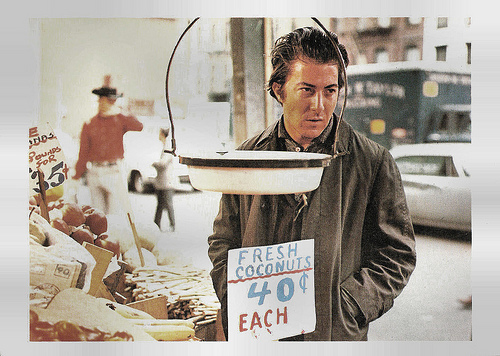
French postcard by Editions La Malibran, Paris, no. MC 9. Photo: publicity still for Midnight Cowboy (John Schlesinger, 1969).
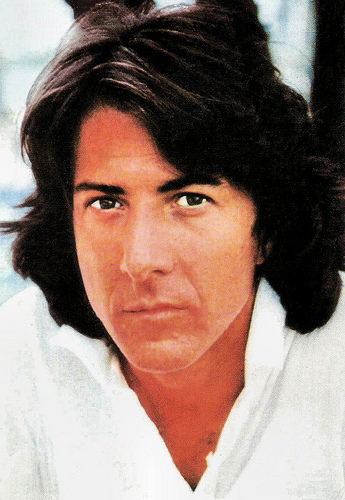
Spanish-Canadian postcard by Bergas / Photos Vedettes, Charlesbourg, 1977.
One of his most iconic performances
On a roll in the 1970s, Dustin Hoffman starred in several acclaimed films, including Straw Dogs (Sam Peckinpah, 1971) in which he played a cowardly mathematician who violently defends his home, the box office hit Papillon (Franklin J. Schaffner, 1973) as a prisoner opposite Steve McQueen, and Lenny (Bob Fosse, 1974) as the legendary, self-destructive stand-up comedian Lenny Bruce. This stunning portrayal earned him a third Academy Award nomination.
Another highlight was the political thriller All the President's Men (Alan J. Pakula, 1976) about the Watergate scandal, which starred Hoffman and Robert Redford as the real-life journalists, Carl Bernstein and Bob Woodward.
Hoffman next starred in the thriller Marathon Man (John Schlesinger, 1976), based on William Goldman's novel of the same name, opposite Laurence Olivier and Roy Scheider.
He finally won an Academy Award for his performance as a sympathetic father in Kramer vs. Kramer (Robert Benton, 1979), with co-star Meryl Streep also nabbing an Oscar. The film tells the story of a married couple's divorce and its impact on everyone involved, including the couple's young son.
In 1982, playing yet another antihero, Hoffman starred in the comedy Tootsie (Sydney Pollack, 1982) as Michael Dorsey, a down-and-out actor who must dress up as a woman to find steady employment on a daytime soap opera. Tootsie earned ten Academy Award nominations, including Hoffman's fifth nomination. The film grossed nearly $100 million during its theatrical release.
His two returns to the stage during the 1980s proved great triumphs for Hoffman. First was his much-lauded performance as Willy Loman in the Broadway revival of Arthur Miller’s Death of a Salesman (1984), which was adapted for television the following year and earned Hoffman an Emmy Award and a Golden Globe Award. Always determined to select a challenging variety of roles, he next appeared on stage in London as Shylock in Sir Peter Hall’s production of The Merchant of Venice (1989).
Then, Hoffman starred in the Hollywood smash Rain Man (Barry Levinson, 1988) alongside Tom Cruise. Hoffman's portrayal of an middle-aged autistic savant earned him a second Academy Award and remains one of his most iconic performances. Encyclopaedia Britannica : "Not unlike Hoffman’s earlier roles, Rain Man’s Raymond Babbitt is a difficult character to embrace because of his emotionless nature, but the actor elicits just the right amount of sympathy from an audience."
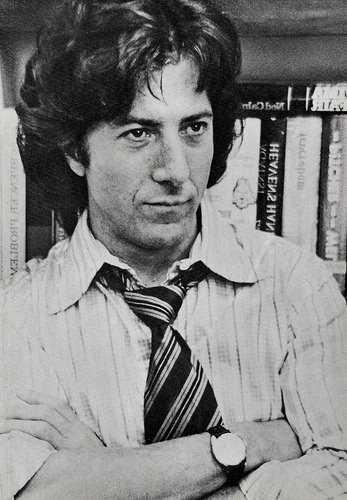
French postcard by Euro-Images, St. Jean de Vedas, no. CP 73. Photo: publicity still for All the President's Men (Alan J. Pakula, 1976).
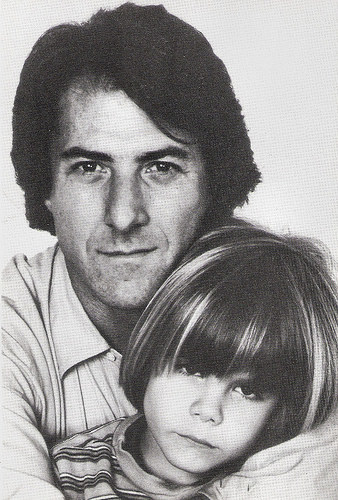
Belgian postcard by Joepie / Raider Bounty. Photo: publicity still for Kramer vs. Kramer (Robert Benton, 1979) with Justin Henry.
Sexual harassment allegations
The 1990s brought Dustin Hoffman appearances in a series of big-budget films that proved largely disappointing at the box office. He returned in the revenge drama/legal thriller Sleepers (Barry Levinson, 1996) with Robert De Niro , Brad Pitt , Jason Patric, and Kevin Bacon.
Hoffman's next critically acclaimed role was in the biting political satire Wag the Dog (Barry Levinson, 1997). He played Stanley Motss, a neurotic, fame-hungry Hollywood producer who coconspires to fool the entire world into believing that the United States is at war with Albania, and scored his seventh Oscar nomination.
In 2004, Hoffman again exhibited his comedic prowess when he starred with Lily Tomlin in an offbeat movie about a husband-and-wife detective team that helps clients solve their existential problems, I Heart Huckabees (David O'Russell, 2004). Further cementing his new direction, he went on to appear as Ben Stiller's father in the broad comedies Meet the Fockers (Jay Roach, 2004) and Little Fockers (Paul Weitz, 2010). He also played a 243 year old owner or a strangely enchanted toy store in the children's fantasy Mr. Magorium's Wonder Emporium (Zach Helm, 2007).
Hoffman continued to star in blockbuster films like Stranger than Fiction (Marc Forster, 2006) with Will Ferrell, but also lent his voice to the computer-animated films Kung Fu Panda (Mark Osborne, John Stevenson, 2008) and The Tale of Despereaux (Sam Fell, Robert Stevenhagen, 2008). In 2012, at the age of 75, Hoffman made his debut as a film director with Quartet (Dustin Hoffman, 2012), an ensemble comedy about former opera singers residing in an English retirement home, with Maggie Smith and Michael Gambon.
In 2014 he joined the ensemble cast of Jon Favreau's critically acclaimed Chef (Jon Favreau, 2014). Two years later, he won the International Emmy Award for Best Actor for his work on Roald Dahl's Esio Trot (Dearbhla Walsh, 2015), based on a children’s book about a bachelor romancing his tortoise-loving neighbour (Judi Dench). In 2017 he starred opposite Adam Sandler in The Meyerowitz Stories (New and Selected) (Noah Baumbach, 2017), playing a sculptor preparing for a retrospective of his work in New York.
In the fall of 2017, after the Harvey Weinstein sexual harassment allegations rocked Hollywood, Hoffman became one of the actors forced to account for past behaviour. Writer Anna Graham Hunter, who was 17 when she interned on the set of the TV Movie Death of a Salesman (Volker Schlöndorff, 1985), recounted the older actor asking about her sex life and groping her. In December, a new round of reports surfaced in which five women accused Hoffman of sexual assault or harassment, including accounts of the actor exposing himself and forced sexual activity. Hoffman denied.
Apart from his successful professional work, Hoffman married Anne Byrne in 1969. He adopted her daughter, Karina, from a previous marriage, and in 1970 their second daughter, Jenna, was born. After more than 10 years of marriage, Hoffman and Anne divorced in 1980. Soon after, he married attorney Lisa Gottsegen. They would go on to have four children: Jacob Edward, Rebecca Lillian, Maxwell Geoffrey and Alexandra Lydia.
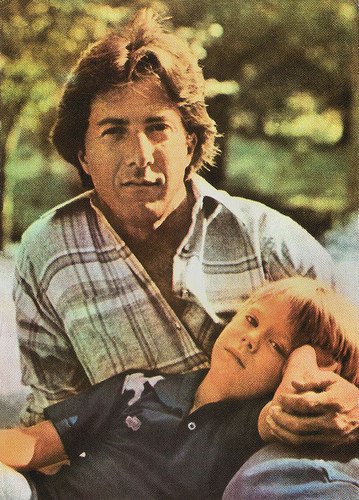
Romanian postcard by Casa Filmului Acin. Photo: publicity still for Kramer vs. Kramer (Robert Benton, 1979), with Justin Henry.
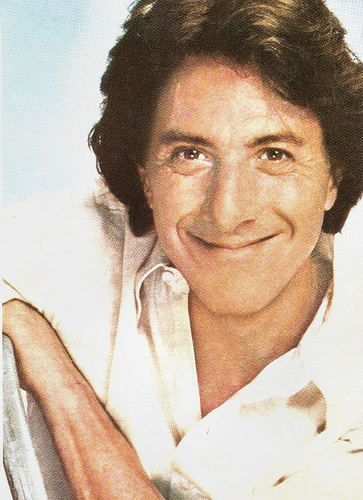
Romanian postcard by Casa Filmului Acin.
Sources: Jason Ankeny (AllMovie), Encyclopaedia Britannica, Biography.com, Wikipedia and .

French postcard, no. SL. 4037. The Academy Awards Ceremony 1989: Dustin Hoffman wins the Best Actor Oscar for Rain Man' (Barry Levinson, 1988), with co-star Tom Cruise.

American postcard by Coral-Lee, Rancho Cordova, no. CL/Personality # 113. Photo: Greg Gorman. Publicity still for Tootsie (Sydney Pollack, 1982).
A dedicated method actor
Dustin Lee Hoffman was born in Los Angeles, California, in 1937. His parents were Lillian and Harry Hoffman. His father was a furniture salesman and prop supervisor for Columbia Pictures. Although he is Jewish, Hoffman and his brother were raised in a relatively secular household. Hoffman graduated from Los Angeles High School in 1955.
Hoffman's acting career began at age 19, when he dropped out of music studies at California’s Santa Monica City College to pursue the stage at the Pasadena Playhouse. There, Hoffman befriended another young actor, Gene Hackman. Eventually, the two would both move to New York City where they lived together with Robert Duvall, all three of them looking for work in television and off-Broadway plays.
Hoffman studied at Actors Studio and became a dedicated Method actor. To make ends meet, he took odd jobs and the occasional bit role. Frustrated by his lack of greater success, Hoffman once even left acting to teach, but in 1960 he won a role in the off-Broadway production Yes Is for a Very Young Man. After A Cook for Mr. General (1961), however, he continued to struggle, and did not reappear onstage for several years, in the meantime studying with Lee Strasberg at the Actors' Studio and becoming a dedicated Method actor.
Slowly but surely, Hoffman began building a strong reputation through smaller roles in productions of Waiting for Godot (1964) and The Dumbwaiter (1964). He won a Best Actor Obie for his work in The Journey of the Fifth Horse (1966), and a Theatre World Award and a Drama Desk Award for Eh? (1966). Word of mouth soon reached Hollywood, and Hoffman made his film debut with a tiny role in The Tiger Makes Out (Arthur Hiller, 1967), alongside Eli Wallach. A leading role in the Italian-Spanish comedy Un Dollaro per Sette Vigliachi/Madigan's Millions (Giorgio Gentili, 1968) with Elsa Martinelli , followed later that same year. He played a witless government agent sent to Italy to find the million dollars that a murdered gangster (Cesar Romero) kept hidden.
In 1966, director Mike Nichols auditioned Hoffman for a lead role in the Broadway musical The Apple Tree, but rejected him because he could not sing well enough and gave Alan Alda the part. But Nichols was so impressed with Hoffman's overall audition he cast him as Benjamin Braddock, who returns to his wealthy parents' home in California after graduating from college, in The Graduate (Mike Nichols, 1967). Hoffman was 30 years old when he played the 21-year-old Benjamin who, in a search for a meaningful future, aimlessly drifts into an affair with a married woman (Anne Bancroft) who is the age of his parents. The successful social comedy struck a nerve with young audiences disenchanted with the American establishment, and Hoffman was launched as a star.
In 1969, Hoffman struck gold again with the gritty Midnight Cowboy (John Schlesinger, 1969), in which he played the part of Ratso Rizzo, a homeless man in New York City, who develops a friendship with an unsuccessful male prostitute (Jon Voight). Grim and downbeat in its depiction of a heartless New York City, the film was another unlikely success for Hoffman. It garnered him a second Oscar nomination. Also in 1969, Hoffman co-starred with Mia Farrow in John and Mary (Peter Yates, 1969). He was nominated for a Golden Globe Award and received a 1970 BAFTA Award for his role, although the film itself received mixed reviews. In 1970, he starred in Arthur Penn's Little Big Man, delivering a superb portrayal of an Indian fighter - a role which required him to age 100 years.

French postcard by Editions La Malibran, Paris, no. MC 9. Photo: publicity still for Midnight Cowboy (John Schlesinger, 1969).

Spanish-Canadian postcard by Bergas / Photos Vedettes, Charlesbourg, 1977.
One of his most iconic performances
On a roll in the 1970s, Dustin Hoffman starred in several acclaimed films, including Straw Dogs (Sam Peckinpah, 1971) in which he played a cowardly mathematician who violently defends his home, the box office hit Papillon (Franklin J. Schaffner, 1973) as a prisoner opposite Steve McQueen, and Lenny (Bob Fosse, 1974) as the legendary, self-destructive stand-up comedian Lenny Bruce. This stunning portrayal earned him a third Academy Award nomination.
Another highlight was the political thriller All the President's Men (Alan J. Pakula, 1976) about the Watergate scandal, which starred Hoffman and Robert Redford as the real-life journalists, Carl Bernstein and Bob Woodward.
Hoffman next starred in the thriller Marathon Man (John Schlesinger, 1976), based on William Goldman's novel of the same name, opposite Laurence Olivier and Roy Scheider.
He finally won an Academy Award for his performance as a sympathetic father in Kramer vs. Kramer (Robert Benton, 1979), with co-star Meryl Streep also nabbing an Oscar. The film tells the story of a married couple's divorce and its impact on everyone involved, including the couple's young son.
In 1982, playing yet another antihero, Hoffman starred in the comedy Tootsie (Sydney Pollack, 1982) as Michael Dorsey, a down-and-out actor who must dress up as a woman to find steady employment on a daytime soap opera. Tootsie earned ten Academy Award nominations, including Hoffman's fifth nomination. The film grossed nearly $100 million during its theatrical release.
His two returns to the stage during the 1980s proved great triumphs for Hoffman. First was his much-lauded performance as Willy Loman in the Broadway revival of Arthur Miller’s Death of a Salesman (1984), which was adapted for television the following year and earned Hoffman an Emmy Award and a Golden Globe Award. Always determined to select a challenging variety of roles, he next appeared on stage in London as Shylock in Sir Peter Hall’s production of The Merchant of Venice (1989).
Then, Hoffman starred in the Hollywood smash Rain Man (Barry Levinson, 1988) alongside Tom Cruise. Hoffman's portrayal of an middle-aged autistic savant earned him a second Academy Award and remains one of his most iconic performances. Encyclopaedia Britannica : "Not unlike Hoffman’s earlier roles, Rain Man’s Raymond Babbitt is a difficult character to embrace because of his emotionless nature, but the actor elicits just the right amount of sympathy from an audience."

French postcard by Euro-Images, St. Jean de Vedas, no. CP 73. Photo: publicity still for All the President's Men (Alan J. Pakula, 1976).

Belgian postcard by Joepie / Raider Bounty. Photo: publicity still for Kramer vs. Kramer (Robert Benton, 1979) with Justin Henry.
Sexual harassment allegations
The 1990s brought Dustin Hoffman appearances in a series of big-budget films that proved largely disappointing at the box office. He returned in the revenge drama/legal thriller Sleepers (Barry Levinson, 1996) with Robert De Niro , Brad Pitt , Jason Patric, and Kevin Bacon.
Hoffman's next critically acclaimed role was in the biting political satire Wag the Dog (Barry Levinson, 1997). He played Stanley Motss, a neurotic, fame-hungry Hollywood producer who coconspires to fool the entire world into believing that the United States is at war with Albania, and scored his seventh Oscar nomination.
In 2004, Hoffman again exhibited his comedic prowess when he starred with Lily Tomlin in an offbeat movie about a husband-and-wife detective team that helps clients solve their existential problems, I Heart Huckabees (David O'Russell, 2004). Further cementing his new direction, he went on to appear as Ben Stiller's father in the broad comedies Meet the Fockers (Jay Roach, 2004) and Little Fockers (Paul Weitz, 2010). He also played a 243 year old owner or a strangely enchanted toy store in the children's fantasy Mr. Magorium's Wonder Emporium (Zach Helm, 2007).
Hoffman continued to star in blockbuster films like Stranger than Fiction (Marc Forster, 2006) with Will Ferrell, but also lent his voice to the computer-animated films Kung Fu Panda (Mark Osborne, John Stevenson, 2008) and The Tale of Despereaux (Sam Fell, Robert Stevenhagen, 2008). In 2012, at the age of 75, Hoffman made his debut as a film director with Quartet (Dustin Hoffman, 2012), an ensemble comedy about former opera singers residing in an English retirement home, with Maggie Smith and Michael Gambon.
In 2014 he joined the ensemble cast of Jon Favreau's critically acclaimed Chef (Jon Favreau, 2014). Two years later, he won the International Emmy Award for Best Actor for his work on Roald Dahl's Esio Trot (Dearbhla Walsh, 2015), based on a children’s book about a bachelor romancing his tortoise-loving neighbour (Judi Dench). In 2017 he starred opposite Adam Sandler in The Meyerowitz Stories (New and Selected) (Noah Baumbach, 2017), playing a sculptor preparing for a retrospective of his work in New York.
In the fall of 2017, after the Harvey Weinstein sexual harassment allegations rocked Hollywood, Hoffman became one of the actors forced to account for past behaviour. Writer Anna Graham Hunter, who was 17 when she interned on the set of the TV Movie Death of a Salesman (Volker Schlöndorff, 1985), recounted the older actor asking about her sex life and groping her. In December, a new round of reports surfaced in which five women accused Hoffman of sexual assault or harassment, including accounts of the actor exposing himself and forced sexual activity. Hoffman denied.
Apart from his successful professional work, Hoffman married Anne Byrne in 1969. He adopted her daughter, Karina, from a previous marriage, and in 1970 their second daughter, Jenna, was born. After more than 10 years of marriage, Hoffman and Anne divorced in 1980. Soon after, he married attorney Lisa Gottsegen. They would go on to have four children: Jacob Edward, Rebecca Lillian, Maxwell Geoffrey and Alexandra Lydia.

Romanian postcard by Casa Filmului Acin. Photo: publicity still for Kramer vs. Kramer (Robert Benton, 1979), with Justin Henry.

Romanian postcard by Casa Filmului Acin.
Sources: Jason Ankeny (AllMovie), Encyclopaedia Britannica, Biography.com, Wikipedia and .
Published on December 01, 2018 22:00
November 30, 2018
Photo by Columbia
Columbia Pictures or Columbia is one of the 'Big Six' major American film studios, and was one of the 'Little Three' among the eight major film studios of Hollywood's Golden Age. Studio Mogul was the notoriously hard-driving and vulgar Harry Cohn. Initially Columbia had the worst reputation and smallest budgets, but in the late 1920s the studio began to grow, spurred by a successful association with director Frank Capra. In the 1930s, Columbia became one of the primary homes of the screwball comedy, and contract stars were Jean Arthur and Cary Grant. In the 1940s, Rita Hayworth became Columbia's premier star and Rosalind Russell, Glenn Ford, and William Holden also became major stars at the studio. Today, it has become the world's fifth largest major film studio and is a member of the Sony Pictures Motion Picture Group.
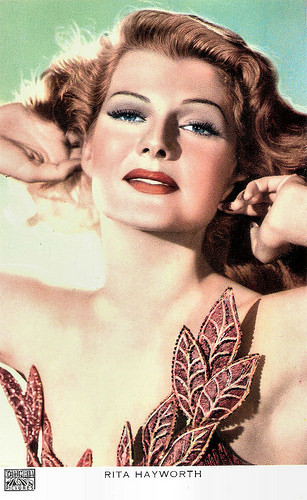
Rita Hayworth . Belgian postcard by Victoria, Brussels, no. 639. Photo: Columbia Pictures.
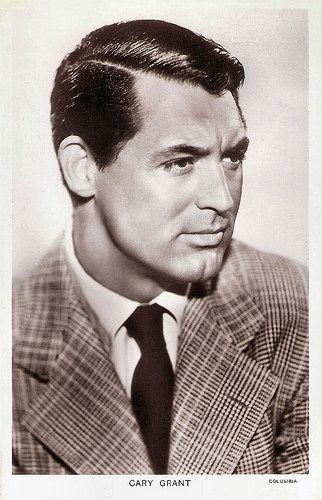
Cary Grant. British postcard in the Picturegoer Series, London, no. 735c. Photo: Columbia.
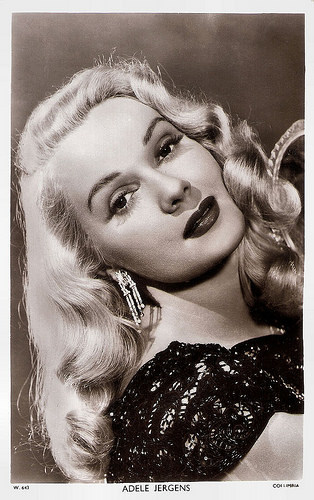
Adele Jergens. British postcard in Picturegoer Series, London, no. W 643. Photo: Columbia.
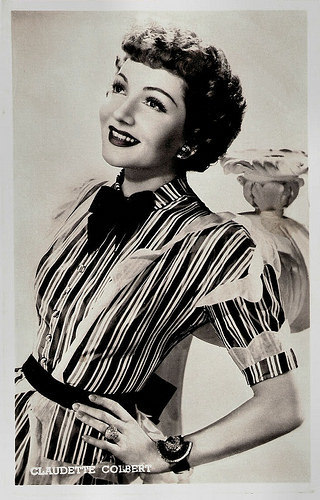
Claudette Colbert . Dutch postcard by J.S.A.. Photo: Columbia. Publicity still for Tomorrow is Forever (Irving Pichel, 1946).
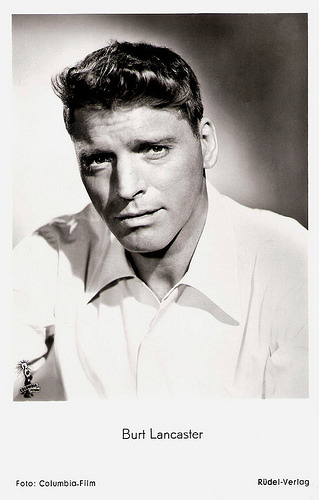
Burt Lancaster . German postcard by Franz Josef Rüdel, Filmpostkartenverlag, Hamburg-Bergedorf, no. 858. Photo: Columbia-Film. Publicity still for From Here to Eternity (Fred Zinnemann, 1953).
The Corned Beef and Cabbage Studio
Columbia was founded in June 1918 as Cohn-Brandt-Cohn (CBC) Film Sales by brothers Jack and Harry Cohn and Jack's best friend Joe Brandt. Jack had worked for Carl Laemmle at Universal, Joe had been Laemmle’s executive secretary and Jack’s younger brother Harry, had also worked at Universal.They released their first feature film in August 1922. Brandt was president of CBC Film Sales, handling sales, marketing and distribution from New York along with Jack Cohn, while Harry Cohn ran production in Hollywood.
The studio's early productions were low-budget short subjects: 'Screen Snapshots', the 'Hall Room Boys' (the vaudeville duo of Edward Flanagan and Neely Edwards), and the Chaplin imitator Billy West. The start-up CBC leased space in a Poverty Row studio on Hollywood's famously low-rent Gower Street. Among Hollywood's elite, the studio's small-time reputation led some to joke that CBC stood for 'Corned Beef and Cabbage'. Brandt eventually tired of dealing with the Cohn brothers, and he sold his one-third stake to Harry Cohn, who took over as president.
In an effort to improve its image, the Cohn brothers renamed the company Columbia Pictures Corporation in 1924. Cohn remained head of production as well, thus concentrating enormous power in his hands. He would run Columbia for the next 34 years, the second-longest tenure of any studio chief, behind only Warner Bros.' Jack L. Warner. Even in an industry rife with nepotism, Columbia was particularly notorious for having a number of Harry and Jack's relatives in high positions. Humorist Robert Benchley called it the Pine Tree Studio, "because it has so many Cohns".
Columbia's product line consisted mostly of moderately budgeted features and short subjects including comedies, sports films, various serials, and cartoons. Columbia gradually moved into the production of higher-budget fare, eventually joining the second tier of Hollywood studios along with United Artists and Universal. Like United Artists and Universal, Columbia was a horizontally integrated company. It controlled production and distribution; it did not own any theatres.
Helping Columbia's climb was the arrival of an ambitious director, Frank Capra. Between 1927 and 1939, Capra constantly pushed Cohn for better material and bigger budgets. A string of hits he directed in the early and mid 1930s solidified Columbia's status as a major studio. In particular, It Happened One Night (Frank Capra, 1934) with Clark Gable and Claudette Colbert put Columbia on the map. It won the Academy Award for Best Film of 1934.
Until then, Columbia's very existence had depended on theatre owners willing to take its films, since as mentioned above it didn't have a theatre network of its own. Other Capra-directed hits followed, including Mr. Deeds Goes to Town (Frank Capra, 1936), the original version of Lost Horizon (Frank Capra, 1937) with Ronald Colman , You Can’t Take it With You (Frank Capra, 1938), which was Capra's highest-grossing picture at Columbia, and Mr. Smith Goes to Washington (Frank Capra, 1939), which made James Stewart a major star.
Capra but also Howard Hawks and others made some of the finest screwball comedies of the 1930s for Columbia: The Awful Truth (Leo McCarey, 1937), Holiday (George Cukor, 1938), and His Girl Friday (Howard Hawks, 1940), all starring Cary Grant. After Capra’s departure in 1939, Columbia languished because leading directors were reluctant to work for the notoriously hard-driving and vulgar Cohn.
In 1938, the addition of B. B. Kahane as Vice President would produce Charles Vidor's Those High Gray Walls (Charles Vidor, 1939), and The Lady in Question (Charles Vidor, 1940), the first joint film of Rita Hayworth and Glenn Ford. Kahane would later become the President of Academy of Motion Picture Arts and Sciences in 1959, until his death a year later.
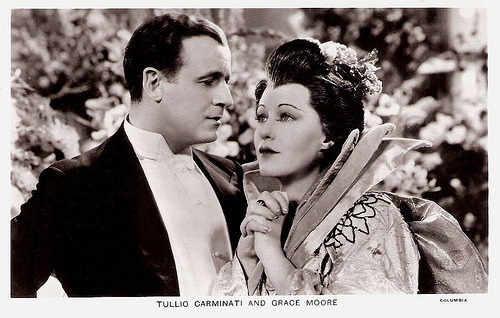
Tullio Carminati and Grace Moore. British postcard in the Film Partners Series, London, no. P 151. Photo: Columbia. Publicity still for One Night of Love (Victor Schertzinger, 1934).
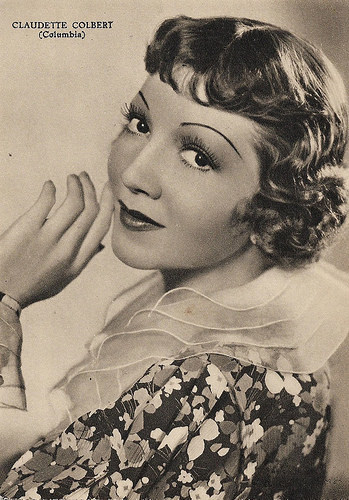
Claudette Colbert . Italian postcard by Rizzoli, Milano, 1937. Photo: Columbia.
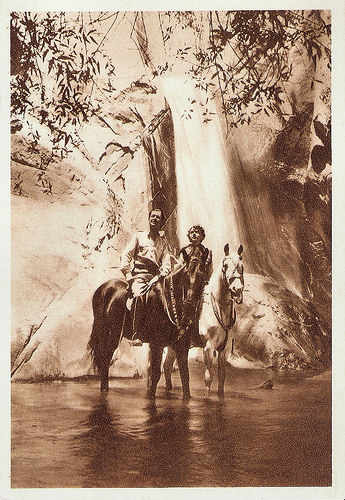
Ronald Colman and Jane Wyatt. Italian postcard by Vecchioni & Guadagno, Roma. Photo: Columbia EIA. Publicity still for Lost Horizon (Frank Capra, 1937).
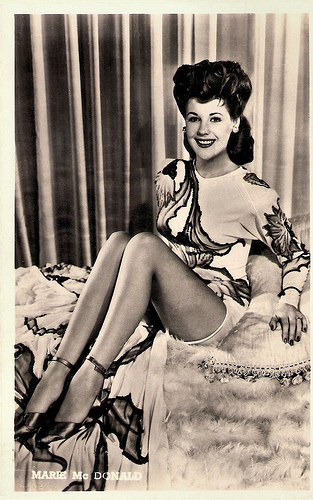
Marie McDonald. Dutch postcard by J.S.A. Photo: Columbia.
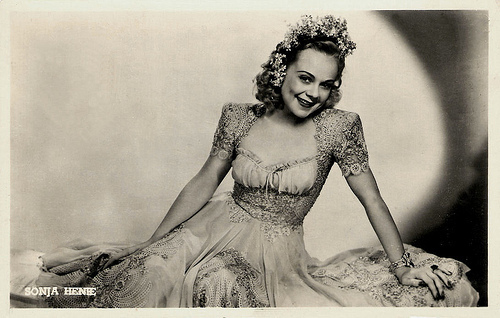
Sonja Henie . Dutch Postcard by J.S.A. Photo: Columbia F.B. / M.P.E.
Hollywood's Siberia for the less obedient stars
Columbia could not afford to keep a huge roster of contract stars, so Cohn usually borrowed them from other studios. At Metro-Goldwyn-Mayer, the industry's most prestigious studio, Columbia was nicknamed 'Siberia, as Louis B. Mayer would use the loan out to Columbia as a way to punish his less-obedient signings. In the 1930s, Columbia signed Jean Arthur to a long-term contract, and after The Whole Town's Talking (John Ford, 1935), Arthur became a major comedy star. Ann Sothern's career was launched when Columbia signed her to a contract in 1936. Cary Grant signed a contract in 1937 and soon after it was altered to a non-exclusive contract shared with RKO.
Many theatres relied on Westerns to attract big weekend audiences, and Columbia always recognised this market. Its first cowboy star was Buck Jones, who signed with Columbia in 1930 for a fraction of his former big-studio salary. Over the next two decades Columbia released scores of outdoor adventures with Jones, Tim McCoy, Ken Maynard, Robert (Tex) Allen, and Gene Autry. Columbia's most popular cowboy was Charles Starrett, who signed with Columbia in 1935 and starred in 131 western features over 17 years.
At Harry Cohn's insistence the studio signed The Three Stooges in 1934. MGM had let the Stooges go but kept straight-man Ted Healy. The Stooges made 190 shorts for Columbia between 1934 and 1957. Columbia's short-subject department employed many famous comedians, including Buster Keaton , Charley Chase, Harry Langdon, and Hugh Herbert. Almost 400 of Columbia's 529 two-reel comedies were released to television between 1958 and 1961; and have since been released to home video.
In the early 1930s, Columbia distributed Walt Disney's famous Mickey Mouse cartoons. In 1933, the studio established its own animation house, under the Screen Gems brand. Columbia's leading cartoon series were Krazy Kat, Scrappy, The Fox and the Crow, and (very briefly) Li'l Abner. In 1949, Columbia agreed to release animated shorts from United Productions of America. These new shorts were more sophisticated than Columbia's older cartoons, and many won critical praise and industry awards.
According to Bob Thomas' book King Cohn, studio chief Harry Cohn always placed a high priority on serials. Beginning in 1937, Columbia entered the lucrative serial market, and kept making these episodic adventures until 1956, after other studios had discontinued them. The most famous Columbia serials are based on comic-strip or radio characters: Mandrake the Magician, The Shadow, Terry and the Pirates, Batman, and Superman, among many others.
Columbia also produced musical shorts, sports reels (usually narrated by sportscaster Bill Stern), and travelogues. Its 'Screen Snapshots' series, showing behind-the-scenes footage of Hollywood stars, was a Columbia perennial; producer-director Ralph Staub kept this series going through 1958.
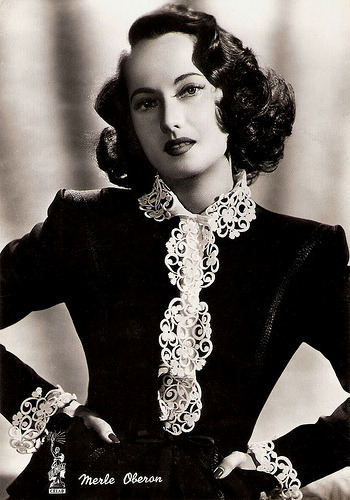
Merle Oberon . Italian postcard by Rotalfoto, Milano, no. 46. Photo: Columbia C.E.I.A.D.
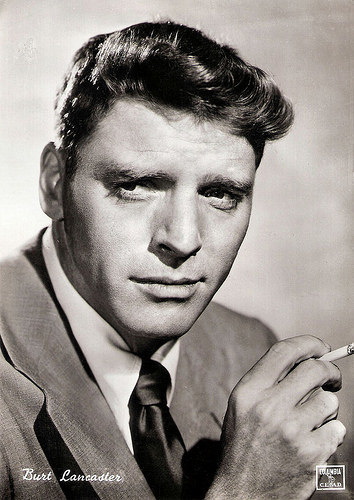
Burt Lancaster . Italian postcard by Bromofoto, no. 957. Photo: Columbia C.E.I.A.D.
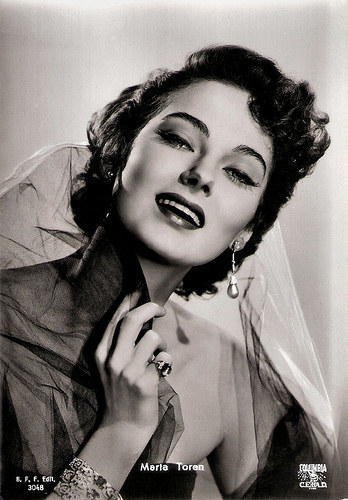
Marta Toren . Italian postcard by B.F.F. Edit., no. 3048. Photo: Columbia C.E.I.A.D.
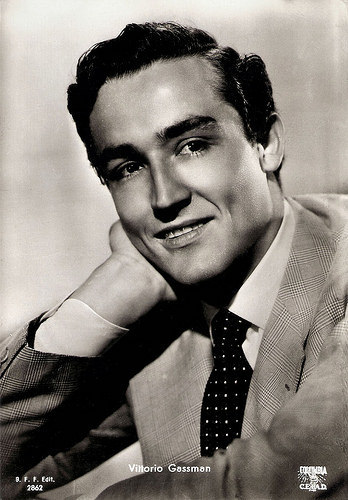
Vittorio Gassman . Italian postcard by Casa Editr. Ballerini & Fratini, Firenze (B.F.F. Edit.), no. 2962. Photo: Columbia C.E.I.A.D.
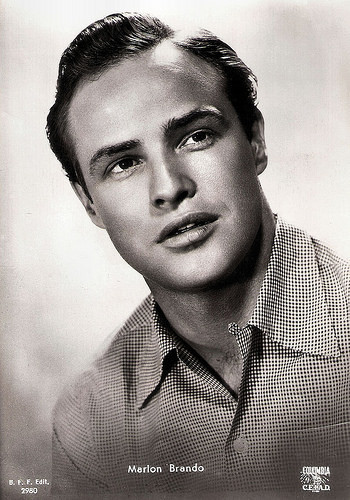
Marlon Brando . Italian postcard by B.F.F. Edit., no. 2980. Photo: Columbia C.E.I.A.D.
Columbia's efficient recycling policy
In the 1940s, Columbia propelled in part by their film's surge in audiences during the war, and also benefited from the popularity of its biggest star, Rita Hayworth . Columbia maintained a long list of contractees well into the 1950s: Glenn Ford, William Holden, Judy Holliday, The Three Stooges, Ann Miller, Jack Lemmon, Adele Jergens, Lucille Ball, Kerwin Mathews, Kim Novak , and others.
Harry Cohn monitored the budgets of his films, and the studio got the maximum use out of costly sets, costumes, and props by reusing them in other films. Many of Columbia's low-budget B-films and short subjects have an expensive look, thanks to Columbia's efficient recycling policy. Cohn was reluctant to spend lavish sums on even his most important pictures, and it was not until 1943 that he agreed to use three-strip Technicolor in a live-action feature.
Columbia's first Technicolor feature was the Western The Desperadoes, starring Randolph Scott and Glenn Ford. Cohn quickly used Technicolor again for Cover Girl (Charles Vidor, 1944), a Hayworth vehicle that instantly was a smash hit, and for the fanciful biography of Frédéric Chopin, A Song to Remember (Charles Vidor, 1945), with Cornel Wilde and Merle Oberon . Another biopic, The Jolson Story (Alfred E. Green, 1946) with Larry Parks, was started in black-and-white, but when Cohn saw how well the project was proceeding, he scrapped the footage and insisted on filming in Technicolor.
In 1948, the United States v. Paramount Pictures, Inc. anti-trust decision forced Hollywood motion picture companies to divest themselves of the theatre chains that they owned. Since Columbia did not own any theatres, it was now on equal terms with the largest studios, and soon replaced RKO on the list of the Big Five studios.
By 1950, Columbia had discontinued most of its popular series films like Boston Blackie, Blondie, The Lone Wolf, etc. Only Jungle Jim featuring Johnny Weissmuller , launched by producer Sam Katzman in 1949, kept going through 1955. Katzman contributed greatly to Columbia's success by producing dozens of topical feature films, including crime dramas, Science-Fiction stories, and Rock-'n'-Roll musicals. Columbia kept making serials until 1956 and two-reel comedies until 1957, after other studios had abandoned them.
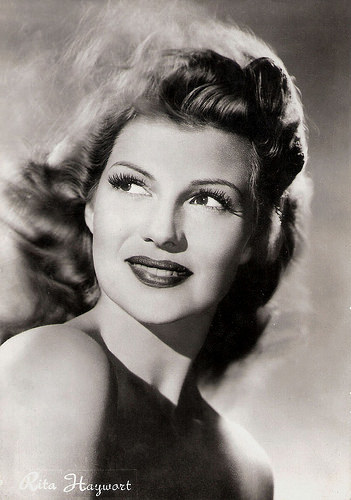
Rita Hayworth . Italian postcard by Bromofoto, no. 284.
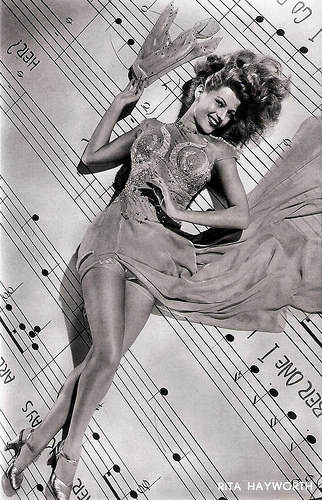
Rita Hayworth . Dutch postcard, Col. Int., no. 286. Photo: Columbia. Publicity still for Cover Girl (Charles Vidor, 1944).
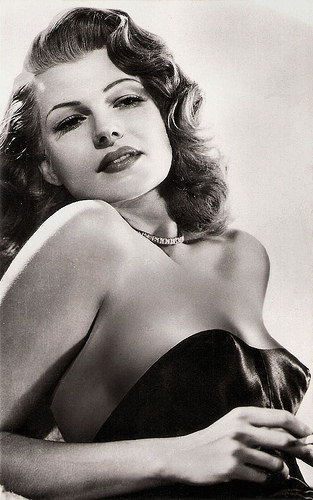
Rita Hayworth . Spanish postcard, no. 4026. Photo: Robert Coburn / Columbia Pictures. Publicity still for Gilda (Charles Vidor, 1946).
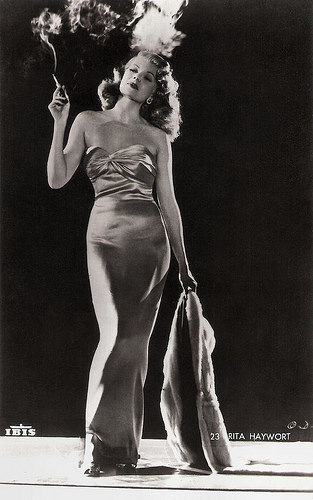
Rita Hayworth . Vintage card by IBIS, no. 23. Photo: Robert Coburn / Columbia Pictures. Publicity still for Gilda (Charles Vidor, 1946). Costume by Jean Louis.
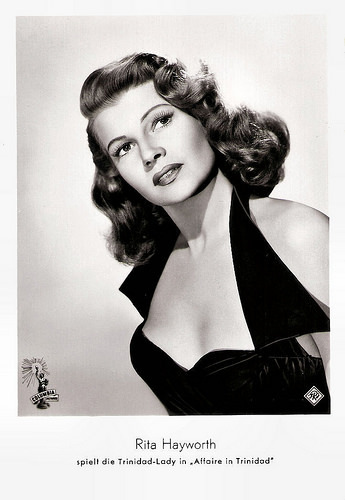
Rita Hayworth . German postcard by F.J. Rüdel Filmpostkartenverlag, Hamburg-Bergedorf, no. 423. Photo: Columbia. Publicity still for Affair in Trinidad (Vincent Sherman, 1952).
Backing independent producers and directors
As the larger studios declined in the 1950s, Columbia's position improved. This was largely because it did not suffer from the massive loss of income that the other major studios suffered from losing their theatres. Columbia backed various independent producers and directors, among them Elia Kazan, Fred Zinnemann, David Lean, Robert Rossen, Otto Preminger, and Joseph Losey.
The studio continued to produce 40-plus pictures a year, offering productions that often broke ground and kept audiences coming to cinemas such as its adaptation of the controversial James Jones novel, From Here to Eternity (Fred Zinnemann, 1953) with Burt Lancaster , On the Waterfront (Elia Kazan, 1954) with Marlon Brando , and The Bridge on the River Kwai (David Lean, 1957) with William Holden, Jack Hawkins and Alec Guinness . All three films won the Best Picture Oscar.
Columbia president Harry Cohn died of a heart attack in February 1958. By 1966, the studio was suffering from box-office failures, and takeover rumours began surfacing. After turning down releasing Albert R. Broccoli's Eon Productions James Bond films, Columbia had hired Broccoli's former partner Irving Allen to produce the Matt Helm series with Dean Martin. Columbia also produced a James Bond spoof, Casino Royale (Val Guest, a.o., 1967), in conjunction with Charles K. Feldman, which held the adaptation rights for that novel. The studio also offered old-fashioned fare like A Man for All Seasons (Fred Zinnemann, 1966) and Oliver! (Carol Reed, 1968).
Columbia came back with the more contemporary Easy Rider (Dennis Hopper, 1969) with Peter Fonda, Five Easy Pieces (Bob Rafelson, 1970) starring Jack Nicholson, and The Last Picture Show (Peter Bogdanovich, 1971). During the 1970s, the studio re-emerged with hits like Close Encounters of the Third Kind (Steven Spielberg, 1977), Tootsie (Sydney Pollack, 1982), and Gandhi (Richard Attenborough, 1982). Columbia was purchased by The Coca-Cola Company in 1982. That same year, Columbia helped launch a new motion-picture studio, Tri-Star Pictures, which was merged with Columbia in 1987 to form Columbia Pictures Entertainment, Inc. In 1989 Columbia was acquired by the Sony Corporation of Japan.
The Columbia Pictures logo, featuring a woman carrying a torch and wearing a drape (representing Columbia, a personification of the United States), has gone through five major revisions. Originally in 1924, Columbia Pictures used a logo featuring a female Roman soldier holding a shield in her left hand and a stick of wheat in her right hand. The logo changed in 1928 with the woman wearing a draped flag and torch. The woman wore the stole and carried the palla of ancient Rome, and above her were the words A Columbia Production. The current logo was created in 1992, when Scott Mednick was hired by Peter Guber to create logos for all the entertainment properties then owned by Sony Pictures. Mednick hired New Orleans artist Michael Deas, to digitally repaint the logo and return the woman to her a classic look.
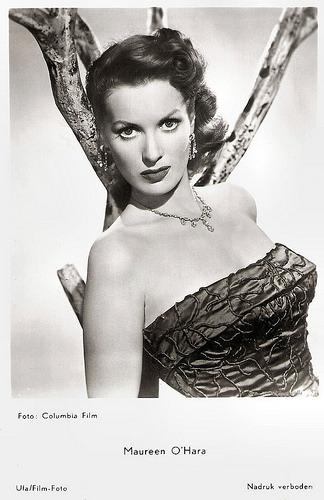
Maureen O'Hara . Dutch postcard by Gebr. Spanjersberg N.V., Rotterdam, no. 2028. Photo: Columbia Film / Ufa.
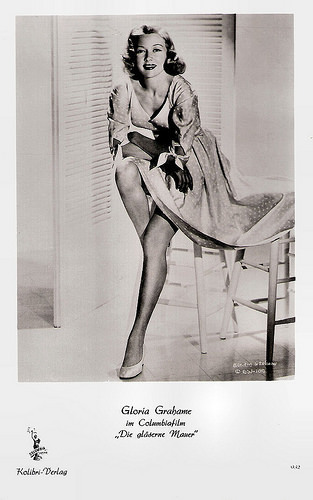
Gloria Grahame . German postcard by Kolibri-Verlag, no. 032. Photo: Columbia. Publicity still for The Glass Wall (Maxwell Shane, 1953).
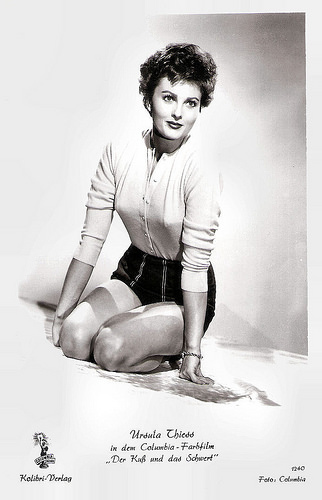
Ursula Thiess . German postcard by Kolibri-Verlag, no. 1240. Photo: Columbia. Publicity still for The Iron Glove (William Castle, 1954).
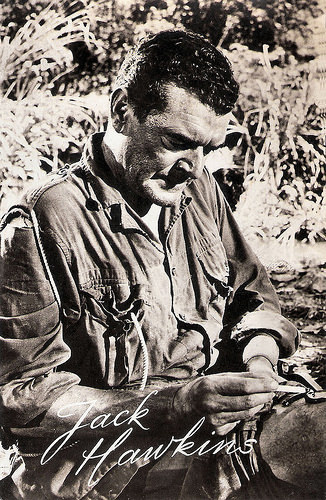
Jack Hawkins . Dutch postcard by Uitg. Takken, Utrecht, no. 8304. Photo: Columbia. Publicity still for The Bridge on the River Kwai (David Lean, 1957).

Jean Seberg . German postcard by WS-Druck, Wanne-Eickel, no. 334. Photo: Columbia / Filmpress Zürich.
Sources: Aurora (Once upon a screen), Encyclopaedia Britannica, Wikipedia and IMDb.

Rita Hayworth . Belgian postcard by Victoria, Brussels, no. 639. Photo: Columbia Pictures.

Cary Grant. British postcard in the Picturegoer Series, London, no. 735c. Photo: Columbia.

Adele Jergens. British postcard in Picturegoer Series, London, no. W 643. Photo: Columbia.

Claudette Colbert . Dutch postcard by J.S.A.. Photo: Columbia. Publicity still for Tomorrow is Forever (Irving Pichel, 1946).

Burt Lancaster . German postcard by Franz Josef Rüdel, Filmpostkartenverlag, Hamburg-Bergedorf, no. 858. Photo: Columbia-Film. Publicity still for From Here to Eternity (Fred Zinnemann, 1953).
The Corned Beef and Cabbage Studio
Columbia was founded in June 1918 as Cohn-Brandt-Cohn (CBC) Film Sales by brothers Jack and Harry Cohn and Jack's best friend Joe Brandt. Jack had worked for Carl Laemmle at Universal, Joe had been Laemmle’s executive secretary and Jack’s younger brother Harry, had also worked at Universal.They released their first feature film in August 1922. Brandt was president of CBC Film Sales, handling sales, marketing and distribution from New York along with Jack Cohn, while Harry Cohn ran production in Hollywood.
The studio's early productions were low-budget short subjects: 'Screen Snapshots', the 'Hall Room Boys' (the vaudeville duo of Edward Flanagan and Neely Edwards), and the Chaplin imitator Billy West. The start-up CBC leased space in a Poverty Row studio on Hollywood's famously low-rent Gower Street. Among Hollywood's elite, the studio's small-time reputation led some to joke that CBC stood for 'Corned Beef and Cabbage'. Brandt eventually tired of dealing with the Cohn brothers, and he sold his one-third stake to Harry Cohn, who took over as president.
In an effort to improve its image, the Cohn brothers renamed the company Columbia Pictures Corporation in 1924. Cohn remained head of production as well, thus concentrating enormous power in his hands. He would run Columbia for the next 34 years, the second-longest tenure of any studio chief, behind only Warner Bros.' Jack L. Warner. Even in an industry rife with nepotism, Columbia was particularly notorious for having a number of Harry and Jack's relatives in high positions. Humorist Robert Benchley called it the Pine Tree Studio, "because it has so many Cohns".
Columbia's product line consisted mostly of moderately budgeted features and short subjects including comedies, sports films, various serials, and cartoons. Columbia gradually moved into the production of higher-budget fare, eventually joining the second tier of Hollywood studios along with United Artists and Universal. Like United Artists and Universal, Columbia was a horizontally integrated company. It controlled production and distribution; it did not own any theatres.
Helping Columbia's climb was the arrival of an ambitious director, Frank Capra. Between 1927 and 1939, Capra constantly pushed Cohn for better material and bigger budgets. A string of hits he directed in the early and mid 1930s solidified Columbia's status as a major studio. In particular, It Happened One Night (Frank Capra, 1934) with Clark Gable and Claudette Colbert put Columbia on the map. It won the Academy Award for Best Film of 1934.
Until then, Columbia's very existence had depended on theatre owners willing to take its films, since as mentioned above it didn't have a theatre network of its own. Other Capra-directed hits followed, including Mr. Deeds Goes to Town (Frank Capra, 1936), the original version of Lost Horizon (Frank Capra, 1937) with Ronald Colman , You Can’t Take it With You (Frank Capra, 1938), which was Capra's highest-grossing picture at Columbia, and Mr. Smith Goes to Washington (Frank Capra, 1939), which made James Stewart a major star.
Capra but also Howard Hawks and others made some of the finest screwball comedies of the 1930s for Columbia: The Awful Truth (Leo McCarey, 1937), Holiday (George Cukor, 1938), and His Girl Friday (Howard Hawks, 1940), all starring Cary Grant. After Capra’s departure in 1939, Columbia languished because leading directors were reluctant to work for the notoriously hard-driving and vulgar Cohn.
In 1938, the addition of B. B. Kahane as Vice President would produce Charles Vidor's Those High Gray Walls (Charles Vidor, 1939), and The Lady in Question (Charles Vidor, 1940), the first joint film of Rita Hayworth and Glenn Ford. Kahane would later become the President of Academy of Motion Picture Arts and Sciences in 1959, until his death a year later.

Tullio Carminati and Grace Moore. British postcard in the Film Partners Series, London, no. P 151. Photo: Columbia. Publicity still for One Night of Love (Victor Schertzinger, 1934).

Claudette Colbert . Italian postcard by Rizzoli, Milano, 1937. Photo: Columbia.

Ronald Colman and Jane Wyatt. Italian postcard by Vecchioni & Guadagno, Roma. Photo: Columbia EIA. Publicity still for Lost Horizon (Frank Capra, 1937).

Marie McDonald. Dutch postcard by J.S.A. Photo: Columbia.

Sonja Henie . Dutch Postcard by J.S.A. Photo: Columbia F.B. / M.P.E.
Hollywood's Siberia for the less obedient stars
Columbia could not afford to keep a huge roster of contract stars, so Cohn usually borrowed them from other studios. At Metro-Goldwyn-Mayer, the industry's most prestigious studio, Columbia was nicknamed 'Siberia, as Louis B. Mayer would use the loan out to Columbia as a way to punish his less-obedient signings. In the 1930s, Columbia signed Jean Arthur to a long-term contract, and after The Whole Town's Talking (John Ford, 1935), Arthur became a major comedy star. Ann Sothern's career was launched when Columbia signed her to a contract in 1936. Cary Grant signed a contract in 1937 and soon after it was altered to a non-exclusive contract shared with RKO.
Many theatres relied on Westerns to attract big weekend audiences, and Columbia always recognised this market. Its first cowboy star was Buck Jones, who signed with Columbia in 1930 for a fraction of his former big-studio salary. Over the next two decades Columbia released scores of outdoor adventures with Jones, Tim McCoy, Ken Maynard, Robert (Tex) Allen, and Gene Autry. Columbia's most popular cowboy was Charles Starrett, who signed with Columbia in 1935 and starred in 131 western features over 17 years.
At Harry Cohn's insistence the studio signed The Three Stooges in 1934. MGM had let the Stooges go but kept straight-man Ted Healy. The Stooges made 190 shorts for Columbia between 1934 and 1957. Columbia's short-subject department employed many famous comedians, including Buster Keaton , Charley Chase, Harry Langdon, and Hugh Herbert. Almost 400 of Columbia's 529 two-reel comedies were released to television between 1958 and 1961; and have since been released to home video.
In the early 1930s, Columbia distributed Walt Disney's famous Mickey Mouse cartoons. In 1933, the studio established its own animation house, under the Screen Gems brand. Columbia's leading cartoon series were Krazy Kat, Scrappy, The Fox and the Crow, and (very briefly) Li'l Abner. In 1949, Columbia agreed to release animated shorts from United Productions of America. These new shorts were more sophisticated than Columbia's older cartoons, and many won critical praise and industry awards.
According to Bob Thomas' book King Cohn, studio chief Harry Cohn always placed a high priority on serials. Beginning in 1937, Columbia entered the lucrative serial market, and kept making these episodic adventures until 1956, after other studios had discontinued them. The most famous Columbia serials are based on comic-strip or radio characters: Mandrake the Magician, The Shadow, Terry and the Pirates, Batman, and Superman, among many others.
Columbia also produced musical shorts, sports reels (usually narrated by sportscaster Bill Stern), and travelogues. Its 'Screen Snapshots' series, showing behind-the-scenes footage of Hollywood stars, was a Columbia perennial; producer-director Ralph Staub kept this series going through 1958.

Merle Oberon . Italian postcard by Rotalfoto, Milano, no. 46. Photo: Columbia C.E.I.A.D.

Burt Lancaster . Italian postcard by Bromofoto, no. 957. Photo: Columbia C.E.I.A.D.

Marta Toren . Italian postcard by B.F.F. Edit., no. 3048. Photo: Columbia C.E.I.A.D.

Vittorio Gassman . Italian postcard by Casa Editr. Ballerini & Fratini, Firenze (B.F.F. Edit.), no. 2962. Photo: Columbia C.E.I.A.D.

Marlon Brando . Italian postcard by B.F.F. Edit., no. 2980. Photo: Columbia C.E.I.A.D.
Columbia's efficient recycling policy
In the 1940s, Columbia propelled in part by their film's surge in audiences during the war, and also benefited from the popularity of its biggest star, Rita Hayworth . Columbia maintained a long list of contractees well into the 1950s: Glenn Ford, William Holden, Judy Holliday, The Three Stooges, Ann Miller, Jack Lemmon, Adele Jergens, Lucille Ball, Kerwin Mathews, Kim Novak , and others.
Harry Cohn monitored the budgets of his films, and the studio got the maximum use out of costly sets, costumes, and props by reusing them in other films. Many of Columbia's low-budget B-films and short subjects have an expensive look, thanks to Columbia's efficient recycling policy. Cohn was reluctant to spend lavish sums on even his most important pictures, and it was not until 1943 that he agreed to use three-strip Technicolor in a live-action feature.
Columbia's first Technicolor feature was the Western The Desperadoes, starring Randolph Scott and Glenn Ford. Cohn quickly used Technicolor again for Cover Girl (Charles Vidor, 1944), a Hayworth vehicle that instantly was a smash hit, and for the fanciful biography of Frédéric Chopin, A Song to Remember (Charles Vidor, 1945), with Cornel Wilde and Merle Oberon . Another biopic, The Jolson Story (Alfred E. Green, 1946) with Larry Parks, was started in black-and-white, but when Cohn saw how well the project was proceeding, he scrapped the footage and insisted on filming in Technicolor.
In 1948, the United States v. Paramount Pictures, Inc. anti-trust decision forced Hollywood motion picture companies to divest themselves of the theatre chains that they owned. Since Columbia did not own any theatres, it was now on equal terms with the largest studios, and soon replaced RKO on the list of the Big Five studios.
By 1950, Columbia had discontinued most of its popular series films like Boston Blackie, Blondie, The Lone Wolf, etc. Only Jungle Jim featuring Johnny Weissmuller , launched by producer Sam Katzman in 1949, kept going through 1955. Katzman contributed greatly to Columbia's success by producing dozens of topical feature films, including crime dramas, Science-Fiction stories, and Rock-'n'-Roll musicals. Columbia kept making serials until 1956 and two-reel comedies until 1957, after other studios had abandoned them.

Rita Hayworth . Italian postcard by Bromofoto, no. 284.

Rita Hayworth . Dutch postcard, Col. Int., no. 286. Photo: Columbia. Publicity still for Cover Girl (Charles Vidor, 1944).

Rita Hayworth . Spanish postcard, no. 4026. Photo: Robert Coburn / Columbia Pictures. Publicity still for Gilda (Charles Vidor, 1946).

Rita Hayworth . Vintage card by IBIS, no. 23. Photo: Robert Coburn / Columbia Pictures. Publicity still for Gilda (Charles Vidor, 1946). Costume by Jean Louis.

Rita Hayworth . German postcard by F.J. Rüdel Filmpostkartenverlag, Hamburg-Bergedorf, no. 423. Photo: Columbia. Publicity still for Affair in Trinidad (Vincent Sherman, 1952).
Backing independent producers and directors
As the larger studios declined in the 1950s, Columbia's position improved. This was largely because it did not suffer from the massive loss of income that the other major studios suffered from losing their theatres. Columbia backed various independent producers and directors, among them Elia Kazan, Fred Zinnemann, David Lean, Robert Rossen, Otto Preminger, and Joseph Losey.
The studio continued to produce 40-plus pictures a year, offering productions that often broke ground and kept audiences coming to cinemas such as its adaptation of the controversial James Jones novel, From Here to Eternity (Fred Zinnemann, 1953) with Burt Lancaster , On the Waterfront (Elia Kazan, 1954) with Marlon Brando , and The Bridge on the River Kwai (David Lean, 1957) with William Holden, Jack Hawkins and Alec Guinness . All three films won the Best Picture Oscar.
Columbia president Harry Cohn died of a heart attack in February 1958. By 1966, the studio was suffering from box-office failures, and takeover rumours began surfacing. After turning down releasing Albert R. Broccoli's Eon Productions James Bond films, Columbia had hired Broccoli's former partner Irving Allen to produce the Matt Helm series with Dean Martin. Columbia also produced a James Bond spoof, Casino Royale (Val Guest, a.o., 1967), in conjunction with Charles K. Feldman, which held the adaptation rights for that novel. The studio also offered old-fashioned fare like A Man for All Seasons (Fred Zinnemann, 1966) and Oliver! (Carol Reed, 1968).
Columbia came back with the more contemporary Easy Rider (Dennis Hopper, 1969) with Peter Fonda, Five Easy Pieces (Bob Rafelson, 1970) starring Jack Nicholson, and The Last Picture Show (Peter Bogdanovich, 1971). During the 1970s, the studio re-emerged with hits like Close Encounters of the Third Kind (Steven Spielberg, 1977), Tootsie (Sydney Pollack, 1982), and Gandhi (Richard Attenborough, 1982). Columbia was purchased by The Coca-Cola Company in 1982. That same year, Columbia helped launch a new motion-picture studio, Tri-Star Pictures, which was merged with Columbia in 1987 to form Columbia Pictures Entertainment, Inc. In 1989 Columbia was acquired by the Sony Corporation of Japan.
The Columbia Pictures logo, featuring a woman carrying a torch and wearing a drape (representing Columbia, a personification of the United States), has gone through five major revisions. Originally in 1924, Columbia Pictures used a logo featuring a female Roman soldier holding a shield in her left hand and a stick of wheat in her right hand. The logo changed in 1928 with the woman wearing a draped flag and torch. The woman wore the stole and carried the palla of ancient Rome, and above her were the words A Columbia Production. The current logo was created in 1992, when Scott Mednick was hired by Peter Guber to create logos for all the entertainment properties then owned by Sony Pictures. Mednick hired New Orleans artist Michael Deas, to digitally repaint the logo and return the woman to her a classic look.

Maureen O'Hara . Dutch postcard by Gebr. Spanjersberg N.V., Rotterdam, no. 2028. Photo: Columbia Film / Ufa.

Gloria Grahame . German postcard by Kolibri-Verlag, no. 032. Photo: Columbia. Publicity still for The Glass Wall (Maxwell Shane, 1953).

Ursula Thiess . German postcard by Kolibri-Verlag, no. 1240. Photo: Columbia. Publicity still for The Iron Glove (William Castle, 1954).

Jack Hawkins . Dutch postcard by Uitg. Takken, Utrecht, no. 8304. Photo: Columbia. Publicity still for The Bridge on the River Kwai (David Lean, 1957).

Jean Seberg . German postcard by WS-Druck, Wanne-Eickel, no. 334. Photo: Columbia / Filmpress Zürich.
Sources: Aurora (Once upon a screen), Encyclopaedia Britannica, Wikipedia and IMDb.
Published on November 30, 2018 22:00
November 29, 2018
Judy Garland
American singer, actress, and vaudevillian Judy Garland (1922-1969) was one of the brightest, most tragic film stars of Hollywood's Golden Era. During a career that spanned 45 of her 47 years, Garland attained international stardom as an actress in musicals and dramas, with her records, and on the concert stage. She was nominated for the Oscar for Best Actress for A Star is Born (1954) and received a nomination for Best Supporting Actress for Judgment at Nuremberg (1961). With her warmth, spirit, and her rich and exuberant voice, Garland entertained devoted theatregoers with an array of musicals.
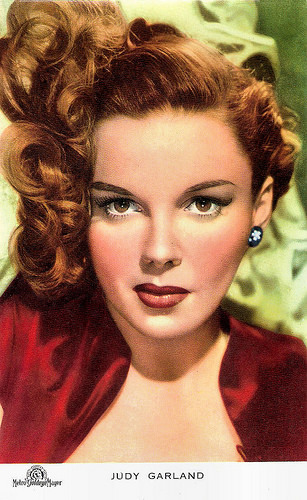
Belgian postcard by S.A. Victoria, Brussels, no. 639. Photo: Metro-Goldwyn-Mayer.
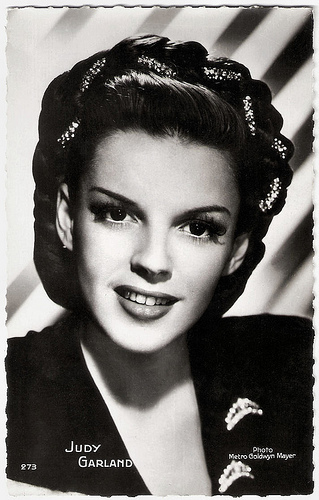
French postcard by Editions P.I., Paris, no. 273. Photo: Metro-Goldwyn-Mayer, 1950.
An orphaned girl on a farm in the dry plains of Kansas
Judy Garland was born Frances Ethel Gumm in 1922 in Grand Rapids, Minnesota, U.S. She was the youngest daughter of vaudevillians Ethel Marion (Milne) and Francis Avent Gumm. Only two, Garland began performing in vaudeville with her two older sisters Mary Jane Gumm and Virginia Gumm as 'The Gumm Sisters'.
Her family life was not a happy one, largely because of her mother's drive for her to succeed as a performer and also her father's closeted homosexuality. The Gumm family would regularly be forced to leave town owing to her father's illicit affairs with other men, and from time to time they would be reduced to living out of their automobile.
Her mother took Frances out of the The Gumm Sisters act and together they travelled across America where she would perform in nightclubs, cabarets, hotels and theatres solo. In 1935, Frances was signed by Louis B. Mayer, mogul of leading film studio MGM, after hearing her sing. It was then that her name was changed from Frances Gumm to Judy Garland, after a popular 1930s song 'Judy' and film critic Robert Garland. Tragedy followed two months later, when her father died of meningitis in November 1935.
Having been given no assignments with the exception of singing on radio, Judy faced the threat of losing her job following the arrival of Deanna Durbin. Knowing that they couldn't keep both of the teenage singers, MGM devised a short entitled Every Sunday (Felix E. Feist, 1936) which would be the girls' screen test. Judy was the outright winner and MGM kept her. Durbin moved to Universal.
Judy's film debut was in Pigskin Parade (David Butler, 1936), in which she played a teenage hillbilly. Her career did officially kick off when she sang one of her most famous songs, 'You Made Me Love You', at Clark Gable's birthday party in February 1937. Louis B. Mayer finally paid attention to the talented songstress, and MGM set to work preparing various musicals with her.
All the work on these musicals took its toll on the young teenager, and she was given numerous pills by the studio doctors in order to combat her tiredness on set. Another problem was her weight fluctuation, but she was soon given amphetamines in order to give her the desired streamlined figure. This would produce the downward spiral that resulted in her lifelong drug addiction.
In 1939, Judy shot to stardom with The Wizard of Oz (Victor Fleming, 1939), in which she portrayed Dorothy, an orphaned girl living on a farm in the dry plains of Kansas who gets whisked off into the magical world of Oz on the other end of the rainbow. Her poignant performance and sweet delivery of her signature song, 'Over The Rainbow', earned Judy a special juvenile Oscar statuette in 1940 for Best Performance by a Juvenile Actor.

British postcard in the Picturegoer Series, London,, no. 1281. Photo: Metro-Goldwyn-Mayer. Publicity still for Love Finds Andy Hardy (George B. Seitz, 1938) with Mickey Rooney, Ann Rutherford, Judy Garland and Lana Turner.
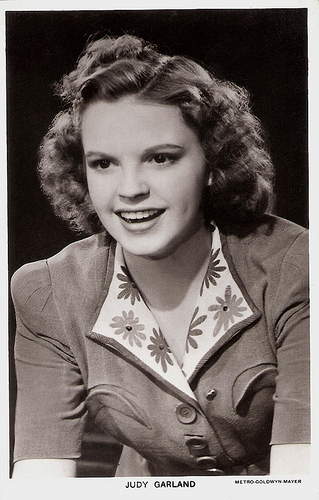
British postcard in the Picturegoer Series, London, no. 1178b. Photo: Metro-Goldwyn-Mayer.
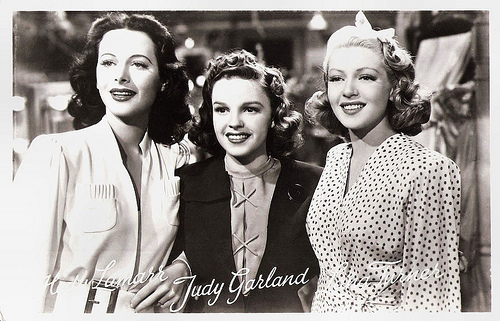
Dutch postcard, no. 3114. Photo: MGM. Publicity still for Ziegfeld Girl (Robert Z. Leonard, Busby Berkeley, 1941) with Hedy Lamarr and Lana Turner.
A love affair between director and actress
Judy Garland was now taking an interest in men. After starring in her final juvenile performance in Ziegfeld Girl (Robert Z. Leonard, Busby Berkeley, 1941) alongside glamorous beauties Lana Turner and Hedy Lamarr , Judy got engaged to bandleader David Rose in May 1941, just two months after his divorce from Martha Raye. Despite planning a big wedding, the couple eloped to Las Vegas and married with just her mother Ethel and her stepfather Will Gilmore present. However, their marriage went downhill as, after discovering that she was pregnant in November 1942, David and MGM persuaded her to abort the baby in order to keep her good-girl image up. She did so and, as a result, was haunted for the rest of her life by her 'inhumane actions'. The couple separated in January 1943.
Garland made more than two dozen films with MGM, nine of which with Mickey Rooney. She played a vaudevillian during WWI in For Me and My Gal (Busby Berkeley, 1942). A big success was Meet Me in St. Louis (Vincente Minnelli, 1944), Director Vincente Minnelli highlighted Judy's beauty for the first time on screen, having made the period musical in colour. He showed off her large brandy-brown eyes and her full, thick lips and after filming ended in April 1944, a love affair resulted between director and actress and they were soon living together.
Vincente began to mold Judy and her career, making her more beautiful and more popular with audiences worldwide. He directed her in The Clock (Vincente Minnelli, 1945), and during the filming the couple announced their engagement. On 15 June 1945 Judy and Vincente married at her mother's home with her boss Louis B. Mayer giving her away and her best friend Betty Asher serving as bridesmaid. After their honeymoon in New York, Judy discovered that she was pregnant. Her first film after marrying Vincente Minnelli was The Harvey Girls (Vincente Minnelli, 1946). Then Judy gave birth to their daughter, Liza Minnelli.
After a postnatal depression, she spent much of her time recuperating in bed. She returned to work, to film The Pirate (Vincente Minnelli, 1948) with Gene Kelly. Judy's mental health was deteriorating and she began hallucinating things and making false accusations toward people, especially her husband, making the filming a nightmare. She then teamed up with Fred Astaire for the musical Easter Parade (Charles Walters, 1948), which resulted in a successful comeback despite having Vincente fired from directing the musical.
Afterwards, Judy's health deteriorated and she began the first of several suicide attempts. In May 1949, she was checked into a rehabilitation center, which caused her much distress. After being replaced by Betty Hutton on Annie Get Your Gun (George Sidney, 1950), Judy was suspended before making her final film for MGM, Summer Stock (Charles Walters, 1950). Then Judy received her third suspension and was fired by MGM, and her second marriage was also soon dissolved.
Having taken up with ruggedly handsome and streetwise entrepreneur Sidney Luft, Judy travelled to London to star at the legendary Palladium. She was an instant success and after her divorce to Vincente Minnelli was finalised on 29 March 1951 after almost six years of marriage, Judy travelled with Sid to New York to make an appearance on Broadway. With her new found fame on stage, Judy was stopped in her tracks in February 1952 when she became pregnant by Sid Luft. At the age of 30, she made him her third husband.
Her relationship with her mother had long since been dissolved by this point, and after the birth of her second daughter, Lorna Luft, on 21 November 1952, she refused to allow her mother to see her granddaughter. Ethel then died in January 1953 of a heart attack, leaving Judy devastated and feeling guilty about not reconciling with her mother before her untimely demise.
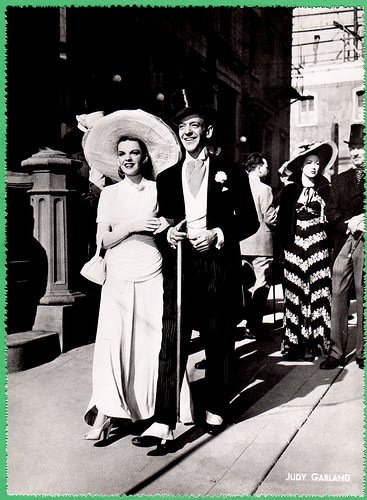
Belgian collectors card by Chocolaterie Clovis, Pepinster. Photo: Metro Goldwyn Mayer. Publicity still for Easter Parade (Charles Walters, 1948) with Fred Astaire. Collection: Amit Benyovits.
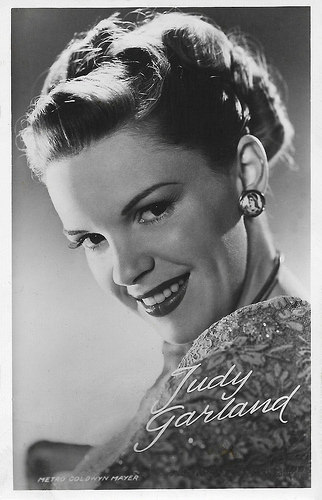
Dutch postcard, no. 3371. Photo: Metro-Goldwyn-Mayer.
A volatile, on-off relationship resulting in numerous divorce filings
Judy Garland was released from MGM in 1950, amid a series of personal struggles and erratic behaviour that had prevented her from fulfilling the terms of her contract. She signed a new film contract with Warner Bros. to star in the musical remake of A Star is Born (William A. Wellman, 1937), which had starred Janet Gaynor . After filming was complete Judy was yet again lauded as a great film star. She won a Golden Globe for her brilliant and outstanding performance as nightclub singer Esther Blodgett who turns into film star Vicki Lester. But she lost out on the Best Actress Oscar to Grace Kelly for her portrayal of the wife of an alcoholic star in The Country Girl (George Seaton, 1954).
Continuing her work on stage, Judy gave birth to son Joey Luft in 1955. She soon began to lose her millions of dollars as a result of her husband's strong gambling addiction. With hundreds of debts to pay, Judy and Sid began a volatile, on-off relationship resulting in numerous divorce filings. In 1961, at the age of 39, Judy returned to her ailing film career, this time to star in Judgment at Nuremberg (Stanley Kramer, 1961). She received an Oscar nomination for Best Supporting Actress, but this time she lost out to Rita Moreno for her role in West Side Story (Robert Wise, 1961).
Her battles with alcoholism and drugs led to Judy's making headlines in newspapers, but she soldiered on. She made record-breaking concert appearances, released eight studio albums, and hosted her own Emmy-nominated television series, The Judy Garland Show (1963–1964). In 1965, Judy and Sid finally divorced after almost 13 years of marriage. By this time, Judy, now 41, had made her final film performance alongside Dirk Bogarde in I Could Go on Singing (Ronald Neame, 1963).
She married her fourth husband, Mark Herron, in 1965 in Las Vegas. The couple separated in April 1966 after five months of marriage, owing to his homosexuality. She then settled down in London, and she began dating disk jockey Mickey Deans in December 1968. They became engaged once her divorce from Mark Herron was finalised on 9 January 1969 after three years of marriage. She married Mickey, her fifth and final husband, in Chelsea, London.
Judy Garland continued working on stage, appearing several times with her daughter Liza. It was during a concert in Chelsea, London, that Judy stumbled into her bathroom late one night and died of an accidental overdose of barbiturates, on the 22nd of June 1969 at the age of 47. The day she died, there was a tornado in Kansas.
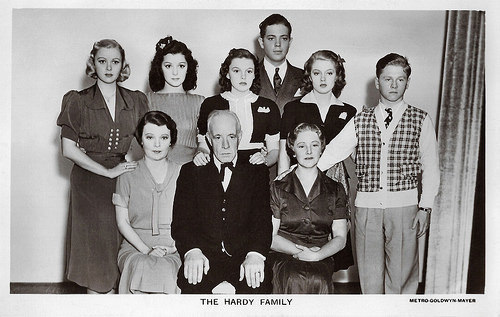
British postcard in the Picturegoer Series, London, no. 1280. Photo: Metro-Goldwyn-Mayer. Publicity still for Love Finds Andy Hardy (George B. Seitz, 1938) with (back row) Cecilia Parker, Ann Rutherford, Judy Garland, Gene Reynolds, Lana Turner and (front row) Mary Howard, Lewis Stone, Fay Holden and Mickey Rooney.
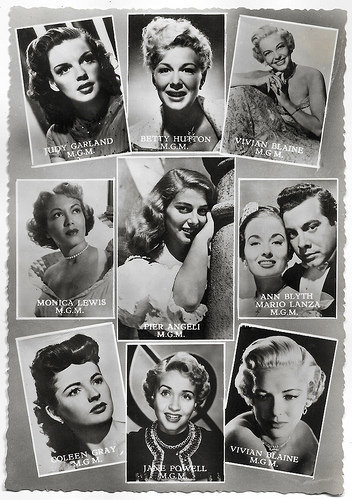
Dutch postcard by Sparo (Gebr. Spanjersberg N.V., Rotterdam). Photos: Metro-Goldwyn-Mayer. The pictures stars are Judy Garland, Betty Hutton, Vivian Blaine (twice), Monica Lewis, Pier Angeli , Ann Blyth and Mario Lanza, Coleen Gray, and Jane Powell. The postcard must date from ca. 1951, when Blyth and Lanza starred together in The Great Caruso (Richard Thorpe, 1951).
Sources: Wikipedia and .

Belgian postcard by S.A. Victoria, Brussels, no. 639. Photo: Metro-Goldwyn-Mayer.

French postcard by Editions P.I., Paris, no. 273. Photo: Metro-Goldwyn-Mayer, 1950.
An orphaned girl on a farm in the dry plains of Kansas
Judy Garland was born Frances Ethel Gumm in 1922 in Grand Rapids, Minnesota, U.S. She was the youngest daughter of vaudevillians Ethel Marion (Milne) and Francis Avent Gumm. Only two, Garland began performing in vaudeville with her two older sisters Mary Jane Gumm and Virginia Gumm as 'The Gumm Sisters'.
Her family life was not a happy one, largely because of her mother's drive for her to succeed as a performer and also her father's closeted homosexuality. The Gumm family would regularly be forced to leave town owing to her father's illicit affairs with other men, and from time to time they would be reduced to living out of their automobile.
Her mother took Frances out of the The Gumm Sisters act and together they travelled across America where she would perform in nightclubs, cabarets, hotels and theatres solo. In 1935, Frances was signed by Louis B. Mayer, mogul of leading film studio MGM, after hearing her sing. It was then that her name was changed from Frances Gumm to Judy Garland, after a popular 1930s song 'Judy' and film critic Robert Garland. Tragedy followed two months later, when her father died of meningitis in November 1935.
Having been given no assignments with the exception of singing on radio, Judy faced the threat of losing her job following the arrival of Deanna Durbin. Knowing that they couldn't keep both of the teenage singers, MGM devised a short entitled Every Sunday (Felix E. Feist, 1936) which would be the girls' screen test. Judy was the outright winner and MGM kept her. Durbin moved to Universal.
Judy's film debut was in Pigskin Parade (David Butler, 1936), in which she played a teenage hillbilly. Her career did officially kick off when she sang one of her most famous songs, 'You Made Me Love You', at Clark Gable's birthday party in February 1937. Louis B. Mayer finally paid attention to the talented songstress, and MGM set to work preparing various musicals with her.
All the work on these musicals took its toll on the young teenager, and she was given numerous pills by the studio doctors in order to combat her tiredness on set. Another problem was her weight fluctuation, but she was soon given amphetamines in order to give her the desired streamlined figure. This would produce the downward spiral that resulted in her lifelong drug addiction.
In 1939, Judy shot to stardom with The Wizard of Oz (Victor Fleming, 1939), in which she portrayed Dorothy, an orphaned girl living on a farm in the dry plains of Kansas who gets whisked off into the magical world of Oz on the other end of the rainbow. Her poignant performance and sweet delivery of her signature song, 'Over The Rainbow', earned Judy a special juvenile Oscar statuette in 1940 for Best Performance by a Juvenile Actor.

British postcard in the Picturegoer Series, London,, no. 1281. Photo: Metro-Goldwyn-Mayer. Publicity still for Love Finds Andy Hardy (George B. Seitz, 1938) with Mickey Rooney, Ann Rutherford, Judy Garland and Lana Turner.

British postcard in the Picturegoer Series, London, no. 1178b. Photo: Metro-Goldwyn-Mayer.

Dutch postcard, no. 3114. Photo: MGM. Publicity still for Ziegfeld Girl (Robert Z. Leonard, Busby Berkeley, 1941) with Hedy Lamarr and Lana Turner.
A love affair between director and actress
Judy Garland was now taking an interest in men. After starring in her final juvenile performance in Ziegfeld Girl (Robert Z. Leonard, Busby Berkeley, 1941) alongside glamorous beauties Lana Turner and Hedy Lamarr , Judy got engaged to bandleader David Rose in May 1941, just two months after his divorce from Martha Raye. Despite planning a big wedding, the couple eloped to Las Vegas and married with just her mother Ethel and her stepfather Will Gilmore present. However, their marriage went downhill as, after discovering that she was pregnant in November 1942, David and MGM persuaded her to abort the baby in order to keep her good-girl image up. She did so and, as a result, was haunted for the rest of her life by her 'inhumane actions'. The couple separated in January 1943.
Garland made more than two dozen films with MGM, nine of which with Mickey Rooney. She played a vaudevillian during WWI in For Me and My Gal (Busby Berkeley, 1942). A big success was Meet Me in St. Louis (Vincente Minnelli, 1944), Director Vincente Minnelli highlighted Judy's beauty for the first time on screen, having made the period musical in colour. He showed off her large brandy-brown eyes and her full, thick lips and after filming ended in April 1944, a love affair resulted between director and actress and they were soon living together.
Vincente began to mold Judy and her career, making her more beautiful and more popular with audiences worldwide. He directed her in The Clock (Vincente Minnelli, 1945), and during the filming the couple announced their engagement. On 15 June 1945 Judy and Vincente married at her mother's home with her boss Louis B. Mayer giving her away and her best friend Betty Asher serving as bridesmaid. After their honeymoon in New York, Judy discovered that she was pregnant. Her first film after marrying Vincente Minnelli was The Harvey Girls (Vincente Minnelli, 1946). Then Judy gave birth to their daughter, Liza Minnelli.
After a postnatal depression, she spent much of her time recuperating in bed. She returned to work, to film The Pirate (Vincente Minnelli, 1948) with Gene Kelly. Judy's mental health was deteriorating and she began hallucinating things and making false accusations toward people, especially her husband, making the filming a nightmare. She then teamed up with Fred Astaire for the musical Easter Parade (Charles Walters, 1948), which resulted in a successful comeback despite having Vincente fired from directing the musical.
Afterwards, Judy's health deteriorated and she began the first of several suicide attempts. In May 1949, she was checked into a rehabilitation center, which caused her much distress. After being replaced by Betty Hutton on Annie Get Your Gun (George Sidney, 1950), Judy was suspended before making her final film for MGM, Summer Stock (Charles Walters, 1950). Then Judy received her third suspension and was fired by MGM, and her second marriage was also soon dissolved.
Having taken up with ruggedly handsome and streetwise entrepreneur Sidney Luft, Judy travelled to London to star at the legendary Palladium. She was an instant success and after her divorce to Vincente Minnelli was finalised on 29 March 1951 after almost six years of marriage, Judy travelled with Sid to New York to make an appearance on Broadway. With her new found fame on stage, Judy was stopped in her tracks in February 1952 when she became pregnant by Sid Luft. At the age of 30, she made him her third husband.
Her relationship with her mother had long since been dissolved by this point, and after the birth of her second daughter, Lorna Luft, on 21 November 1952, she refused to allow her mother to see her granddaughter. Ethel then died in January 1953 of a heart attack, leaving Judy devastated and feeling guilty about not reconciling with her mother before her untimely demise.

Belgian collectors card by Chocolaterie Clovis, Pepinster. Photo: Metro Goldwyn Mayer. Publicity still for Easter Parade (Charles Walters, 1948) with Fred Astaire. Collection: Amit Benyovits.

Dutch postcard, no. 3371. Photo: Metro-Goldwyn-Mayer.
A volatile, on-off relationship resulting in numerous divorce filings
Judy Garland was released from MGM in 1950, amid a series of personal struggles and erratic behaviour that had prevented her from fulfilling the terms of her contract. She signed a new film contract with Warner Bros. to star in the musical remake of A Star is Born (William A. Wellman, 1937), which had starred Janet Gaynor . After filming was complete Judy was yet again lauded as a great film star. She won a Golden Globe for her brilliant and outstanding performance as nightclub singer Esther Blodgett who turns into film star Vicki Lester. But she lost out on the Best Actress Oscar to Grace Kelly for her portrayal of the wife of an alcoholic star in The Country Girl (George Seaton, 1954).
Continuing her work on stage, Judy gave birth to son Joey Luft in 1955. She soon began to lose her millions of dollars as a result of her husband's strong gambling addiction. With hundreds of debts to pay, Judy and Sid began a volatile, on-off relationship resulting in numerous divorce filings. In 1961, at the age of 39, Judy returned to her ailing film career, this time to star in Judgment at Nuremberg (Stanley Kramer, 1961). She received an Oscar nomination for Best Supporting Actress, but this time she lost out to Rita Moreno for her role in West Side Story (Robert Wise, 1961).
Her battles with alcoholism and drugs led to Judy's making headlines in newspapers, but she soldiered on. She made record-breaking concert appearances, released eight studio albums, and hosted her own Emmy-nominated television series, The Judy Garland Show (1963–1964). In 1965, Judy and Sid finally divorced after almost 13 years of marriage. By this time, Judy, now 41, had made her final film performance alongside Dirk Bogarde in I Could Go on Singing (Ronald Neame, 1963).
She married her fourth husband, Mark Herron, in 1965 in Las Vegas. The couple separated in April 1966 after five months of marriage, owing to his homosexuality. She then settled down in London, and she began dating disk jockey Mickey Deans in December 1968. They became engaged once her divorce from Mark Herron was finalised on 9 January 1969 after three years of marriage. She married Mickey, her fifth and final husband, in Chelsea, London.
Judy Garland continued working on stage, appearing several times with her daughter Liza. It was during a concert in Chelsea, London, that Judy stumbled into her bathroom late one night and died of an accidental overdose of barbiturates, on the 22nd of June 1969 at the age of 47. The day she died, there was a tornado in Kansas.

British postcard in the Picturegoer Series, London, no. 1280. Photo: Metro-Goldwyn-Mayer. Publicity still for Love Finds Andy Hardy (George B. Seitz, 1938) with (back row) Cecilia Parker, Ann Rutherford, Judy Garland, Gene Reynolds, Lana Turner and (front row) Mary Howard, Lewis Stone, Fay Holden and Mickey Rooney.

Dutch postcard by Sparo (Gebr. Spanjersberg N.V., Rotterdam). Photos: Metro-Goldwyn-Mayer. The pictures stars are Judy Garland, Betty Hutton, Vivian Blaine (twice), Monica Lewis, Pier Angeli , Ann Blyth and Mario Lanza, Coleen Gray, and Jane Powell. The postcard must date from ca. 1951, when Blyth and Lanza starred together in The Great Caruso (Richard Thorpe, 1951).
Sources: Wikipedia and .
Published on November 29, 2018 22:00
November 28, 2018
Cleopatra (1934)
After his historical epic Sign of the Cross (1932), Cecil B. DeMille directed another ancient spectacle, Cleopatra (1934). His new star Claudette Colbert, fresh from her donkey milk bath in Sign of The Cross, played the politically shrewd, man-hungry queen of Egypt. In 48 BC, Cleopatra, facing palace revolt, welcomes the arrival of Julius Caesar (Warren William) as a way of solidifying her power under Rome. When Caesar, whom she has led astray, is killed, she transfers her affections to Marc Antony (Henry Wilcoxon) and dazzles him on a lavish barge. The film got five Oscar nominations, including one for Best Picture, and Victor Milner won the award for Best Cinematography.
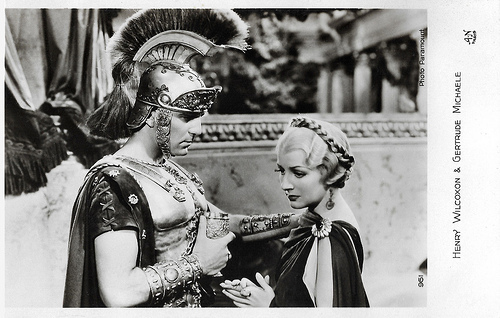
Henry Wilcoxon as Marc Anthony and Gertrude Michael as Caesar's wife Calpurnia. French postcard by A.N., Paris, no. 961. Photo: Paramount. Publicity still for Cleopatra (Cecil B. deMille, 1934).
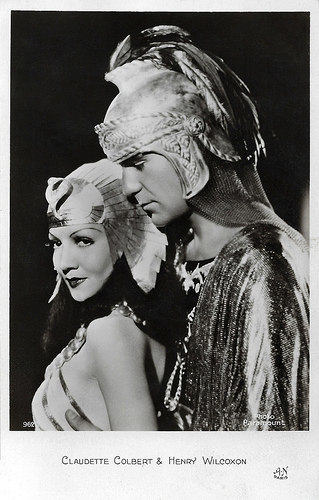
Claudette Colbert as Cleopatra and Henry Wilcoxon as Marc Anthony. French postcard by A.N., Paris, no. 962. Photo: Paramount. Publicity still for Cleopatra (Cecil B. DeMille, 1934).
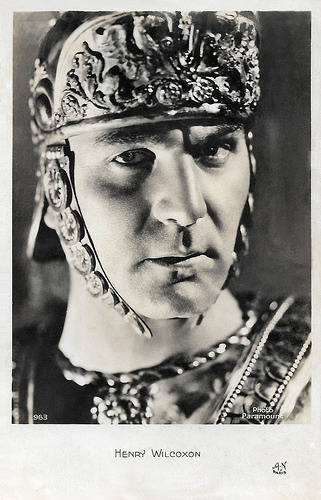
Henri Wilcoxon as Marc Anthony. French postcard by A.N., Paris, no. 963. Photo: Paramount. Publicity still for Cleopatra (Cecil B. DeMille, 1934).
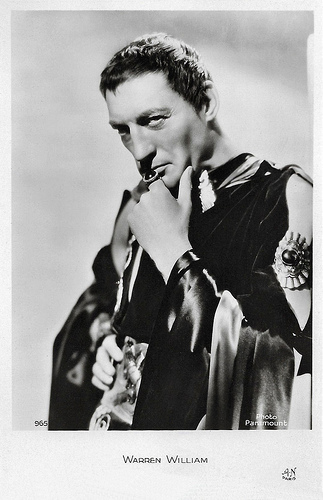
Warren William as Julius Caesar. French postcard by A.N., Paris, no. 965. Photo: Paramount. Publicity still for Cleopatra (Cecil B. DeMille, 1934).
Deadly and fascinating
Wikipedia : "On July 1, 1934, the Motion Picture Production Code began to be rigidly enforced and expanded by Joseph Breen had just taken effect. Talkie films made before that date are generally referred to as Pre-Code films. However, DeMille was able to get away with using more risque imagery than he would be able to do in his later productions. He opens the film with an apparently naked, but strategically lit slave girl holding up an incense burner in each hand as the title appears on screen."
Ron Oliver at IMDb : "Claudette Colbert is perfectly cast in the title role - deadly & fascinating, it's almost like watching a desert viper act. Exhibiting mega star wattage in arguably her best role, Colbert is one of the legendary actresses who could hold her own without being swallowed by the lavish costumes & sets which fill her every scene."
John O'Grady at IMDb : "Colbert is admittedly somewhat miscast (her face is altogether Parisienne), but she handles the part with considerable charm. Warren William, usually a very limited actor, is as good a Caesar as I have seen on film, commanding and uncomfortable by turns; while Henry Wilcoxon is the definitive Mark Antony, laughing, brawling, swaggering, crude and brooding. C. Aubrey Smith as Enobarbus, the last of the hardcore Roman republicans, is perfect. Victor Milner's cinematography is superb, if old-fashioned. There is one magnificent pullback shot aboard Cleopatra's barge, with more and more stuff entering the frame, which as pure cinema is worth more than all four hours of the Liz Taylor version for my money."
Tim Dirks at AMC Filmsite : "Unarguably, the Paramount Studios film is campy, grandiose and unreal and ludicrous historically - filled with DeMille's usual mixture of sin and sex. Sexually-suggestive costumes adorn most of the female characters."
Hal Erickson at AllMovie : "To emphasize the "contemporary" nature of the film, DeMille adds little modernistic touches throughout: The architecture of Egypt and Rome has a distinctly art-deco look; a matron at a social gathering clucks "Poor Calpurnia...well, the wife is always the last to know"; and, after Caesar's funeral, Mark Anthony is chided by an associate for "all that 'Friends, Romans, Countrymen' business!" Cleopatra's barge scene and her suicide from the bite of a snake marked two of the most memorable sequences in DeMille's career. Remarkably, for all the enormous sets and elaborate costumes, Cleopatra came in at a budget of $750,000 -- almost $40 million less than the 1963 Elizabeth Taylor remake."
Mario Gauci at IMDb : "The film features a number of great scenes: Caesar's murder (partly filmed in a POV (point of view) shot), following which is a delicious jibe at Antony's famous oratory during Caesar's funeral as envisioned by Shakespeare; the long - and justly celebrated - barge sequence, in which Antony (intent on teaching Cleopatra, whom he blames for Caesar's death, a lesson) ends up being completely won over by her wiles; Cleopatra's own death scene is simply but most effectively filmed."
Wikipedia : "The film is also memorable for the sumptuous art deco look of its sets (by Hans Dreier) and costumes (by Travis Banton), the atmospheric music composed and conducted by Rudolph George Kopp, and for DeMille's legendary set piece of Cleopatra's seduction of Antony, which takes place on Cleopatra's barge."
Robert Reynolds at IMDb : "This movie is a typical DeMille PRODUCTION, with all the strengths-gorgeous sets, costumes and a sort of grandeur to all the proceedings-as well as the weaknesses-the lavishness often comes at the expense of things like the story, acting and plot. There's no question that it's beautiful (although, interestingly enough, none of it's five nominations for Academy Awards was for Interior Decoration.)"
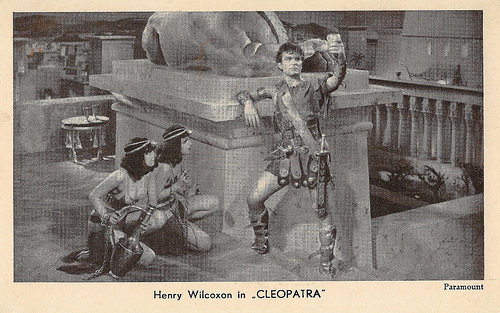
Henry Wilcoxon as Marc Anthony. Dutch postcard, promoting a visit to the American epic Cleopatra (Cecil B. DeMille, 1934). Photo: Paramount.
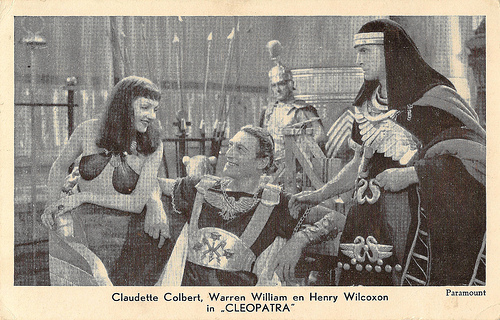
Dutch postcard, promoting a visit to the American epic Cleopatra (Cecil B. DeMille, 1934). Photo: Paramount. Credited on the card are Claudette Colbert (Cleopatra), Henry Wilcoxon (Marc Anthony) and Warren William (Julius Caesar). However, the guy on the right on this card is not Wilcoxon but Cleopatra's rival Pothinos (Leonard Mudie).
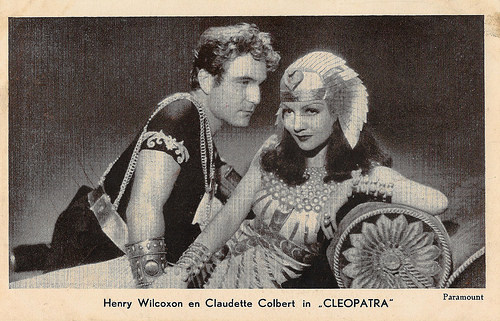
Dutch postcard. Photo: Paramount. Claudette Colbert as Cleopatra and Henry Wilcoxon as Marc Anthony in Cleopatra (Cecil B. DeMille, 1934).
Sources: Hal Erickson (AllMovie), Tim Dirks (AMC Filmsite), Wikipedia and IMDb.

Henry Wilcoxon as Marc Anthony and Gertrude Michael as Caesar's wife Calpurnia. French postcard by A.N., Paris, no. 961. Photo: Paramount. Publicity still for Cleopatra (Cecil B. deMille, 1934).

Claudette Colbert as Cleopatra and Henry Wilcoxon as Marc Anthony. French postcard by A.N., Paris, no. 962. Photo: Paramount. Publicity still for Cleopatra (Cecil B. DeMille, 1934).

Henri Wilcoxon as Marc Anthony. French postcard by A.N., Paris, no. 963. Photo: Paramount. Publicity still for Cleopatra (Cecil B. DeMille, 1934).

Warren William as Julius Caesar. French postcard by A.N., Paris, no. 965. Photo: Paramount. Publicity still for Cleopatra (Cecil B. DeMille, 1934).
Deadly and fascinating
Wikipedia : "On July 1, 1934, the Motion Picture Production Code began to be rigidly enforced and expanded by Joseph Breen had just taken effect. Talkie films made before that date are generally referred to as Pre-Code films. However, DeMille was able to get away with using more risque imagery than he would be able to do in his later productions. He opens the film with an apparently naked, but strategically lit slave girl holding up an incense burner in each hand as the title appears on screen."
Ron Oliver at IMDb : "Claudette Colbert is perfectly cast in the title role - deadly & fascinating, it's almost like watching a desert viper act. Exhibiting mega star wattage in arguably her best role, Colbert is one of the legendary actresses who could hold her own without being swallowed by the lavish costumes & sets which fill her every scene."
John O'Grady at IMDb : "Colbert is admittedly somewhat miscast (her face is altogether Parisienne), but she handles the part with considerable charm. Warren William, usually a very limited actor, is as good a Caesar as I have seen on film, commanding and uncomfortable by turns; while Henry Wilcoxon is the definitive Mark Antony, laughing, brawling, swaggering, crude and brooding. C. Aubrey Smith as Enobarbus, the last of the hardcore Roman republicans, is perfect. Victor Milner's cinematography is superb, if old-fashioned. There is one magnificent pullback shot aboard Cleopatra's barge, with more and more stuff entering the frame, which as pure cinema is worth more than all four hours of the Liz Taylor version for my money."
Tim Dirks at AMC Filmsite : "Unarguably, the Paramount Studios film is campy, grandiose and unreal and ludicrous historically - filled with DeMille's usual mixture of sin and sex. Sexually-suggestive costumes adorn most of the female characters."
Hal Erickson at AllMovie : "To emphasize the "contemporary" nature of the film, DeMille adds little modernistic touches throughout: The architecture of Egypt and Rome has a distinctly art-deco look; a matron at a social gathering clucks "Poor Calpurnia...well, the wife is always the last to know"; and, after Caesar's funeral, Mark Anthony is chided by an associate for "all that 'Friends, Romans, Countrymen' business!" Cleopatra's barge scene and her suicide from the bite of a snake marked two of the most memorable sequences in DeMille's career. Remarkably, for all the enormous sets and elaborate costumes, Cleopatra came in at a budget of $750,000 -- almost $40 million less than the 1963 Elizabeth Taylor remake."
Mario Gauci at IMDb : "The film features a number of great scenes: Caesar's murder (partly filmed in a POV (point of view) shot), following which is a delicious jibe at Antony's famous oratory during Caesar's funeral as envisioned by Shakespeare; the long - and justly celebrated - barge sequence, in which Antony (intent on teaching Cleopatra, whom he blames for Caesar's death, a lesson) ends up being completely won over by her wiles; Cleopatra's own death scene is simply but most effectively filmed."
Wikipedia : "The film is also memorable for the sumptuous art deco look of its sets (by Hans Dreier) and costumes (by Travis Banton), the atmospheric music composed and conducted by Rudolph George Kopp, and for DeMille's legendary set piece of Cleopatra's seduction of Antony, which takes place on Cleopatra's barge."
Robert Reynolds at IMDb : "This movie is a typical DeMille PRODUCTION, with all the strengths-gorgeous sets, costumes and a sort of grandeur to all the proceedings-as well as the weaknesses-the lavishness often comes at the expense of things like the story, acting and plot. There's no question that it's beautiful (although, interestingly enough, none of it's five nominations for Academy Awards was for Interior Decoration.)"

Henry Wilcoxon as Marc Anthony. Dutch postcard, promoting a visit to the American epic Cleopatra (Cecil B. DeMille, 1934). Photo: Paramount.

Dutch postcard, promoting a visit to the American epic Cleopatra (Cecil B. DeMille, 1934). Photo: Paramount. Credited on the card are Claudette Colbert (Cleopatra), Henry Wilcoxon (Marc Anthony) and Warren William (Julius Caesar). However, the guy on the right on this card is not Wilcoxon but Cleopatra's rival Pothinos (Leonard Mudie).

Dutch postcard. Photo: Paramount. Claudette Colbert as Cleopatra and Henry Wilcoxon as Marc Anthony in Cleopatra (Cecil B. DeMille, 1934).
Sources: Hal Erickson (AllMovie), Tim Dirks (AMC Filmsite), Wikipedia and IMDb.
Published on November 28, 2018 22:00
November 27, 2018
Louis Armstrong
Louis Armstrong (1901-1971) was The King of the Jazz Trumpet. Armstrong, nicknamed Satchmo, is renowned for his charismatic stage presence and voice almost as much as for his trumpet playing. He recorded hit songs for five decades and composed dozens of songs that have become jazz standards. Armstrong was one of the most important creative forces in the early development and perpetuation of Jazz. With his superb comic timing and unabashed joy of life, Louis Armstrong also appeared in more than thirty films.
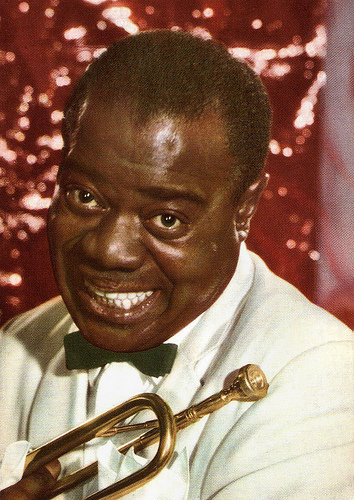
French postcard by Editions P.I., Paris, no. CK-289. Photo: Arthur Grimm / Ufa.
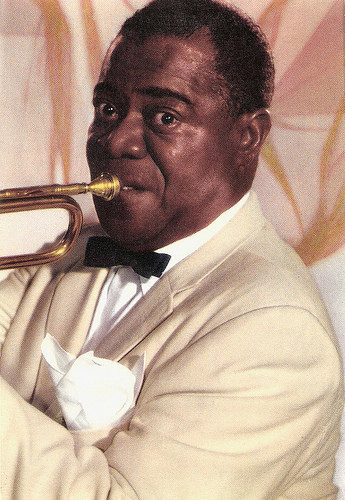
German postcard by ISV, no. H 37.
Born in the Battlefield
Louis Daniel Armstrong was born in New Orleans, Louisiana, in the Storyville District known as 'the Battlefield' in 1901. His parents were Mary Albert and William Armstrong. William abandoned the family shortly after, and Louis grew up poor in a single-parent household. He left school at the 5th grade to help support his family. He sang on street corners, sold newspapers and delivered coal.
Louis was 13 when he celebrated New Year's Eve on 31 December 1912 by running out on the street and firing a blank from a pistol that belonged to the current man in his mother's life. He was arrested and placed in the Colored Waif's Home for boys. There, he learned to play the bugle cornet and the clarinet and joined the home's brass band. Armstrong's first teacher Peter Davis taught him there to read music. After 18 months, Louis left the Home determined to become a musician.
The young Armstrong played in brass bands and riverboats in New Orleans, first on an excursion boat in September 1918. At 18, he got a job in the Kid Ory Band in New Orleans. Armstrong married Daisy Parker as his career as a musician developed. In 1922, he followed his mentor, Joe 'King' Oliver, to Chicago to play in the Creole Jazz Band. He made his first recordings with that band in 1923. While in Chicago, Armstrong networked with other jazz musicians, reconnecting with his friend, Bix Biederbecke, and made new contacts, which included Hoagy Carmichael and Lil Hardin.
Lil was a graduate of Fisk University and an excellent pianist who could read, write and arrange music. She encouraged and enhanced Louis' career, and they married in 1924. Armstrong became very popular and one of the genre's most sought after trumpeters. He travelled a great deal and spent considerable time in Chicago and New York. He first moved to the Big Apple in 1924 to join Fletcher Henderson's Orchestra. He stayed in New York for a while but moved back to Chicago in October of 1925.
Armstrong later went back to New York in 1929. Armstrong appeared on Broadway in Hot Chocolates, in which he introduced Fats Waller's Ain't Misbehavin', his first popular song hit. During that time, some of his most important and successful work was accomplished with his Hot Fives and Hot Sevens Bands. Armstrong's interpretation of Hoagy Carmichael's Stardust became one of the most successful versions of this song ever recorded, showcasing Armstrong's unique vocal sound and style and his innovative approach to singing songs that had already become standards. In 1931, Armstrong appeared in his first film, Ex-Flame. That year, Armstrong and Lil Hardin separated and later divorced in 1938.
Dale O'Connor at IMDb : "He made a tour of Europe in 1932. During a command performance for King George V, he forgot he had been told that performers were not to refer to members of the royal family while playing for them. Just before picking up his trumpet for a really hot number, he announced: 'This one's for you, Rex.'" After this Grand Tour of Europe, Satchmo became Armstrong's nickname. A London music magazine editor had written erroneously 'Satchmo' in an article (Armstrong's nickname was 'Satchelmouth') and the name stuck.
In 1937, Armstrong substituted for Rudy Vallee on the CBS radio network and became the first African American to host a sponsored, national broadcast. After his divorce, Louis married Alpha Smith in 1938. While maintaining a vigorous work schedule, as well as living and travelling back and forth to Chicago and California, Armstrong moved back to New York in the late 1930s and later married Lucille Wilson in 1942.
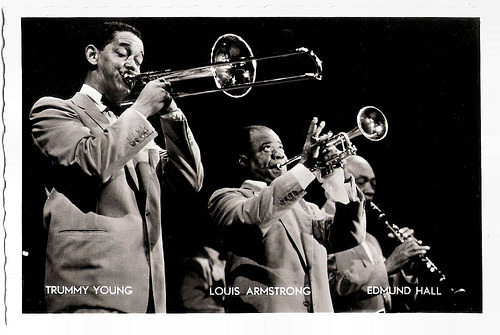
Dutch postcard by N.V. Int. Filmpers (I.F.P.), Amsterdam, no. 1035. Photo: Joel Elkins. Louis Armstrong in the 1955 version of the All Stars, with Trummy Young on trombone and vocals, and Edmond Hall on clarinet and vocals.
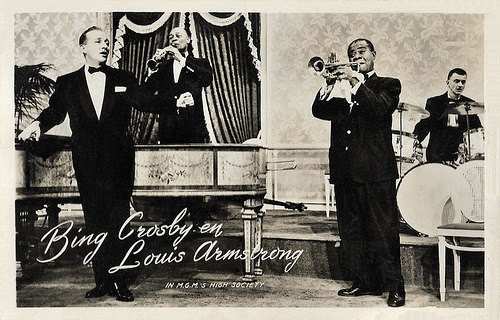
Dutch postcard by Uitg. Takken, Utrecht, no. 3024. Photo: MGM. Publicity still for High Society (Charles Walters, 1956) with Bing Crosby.
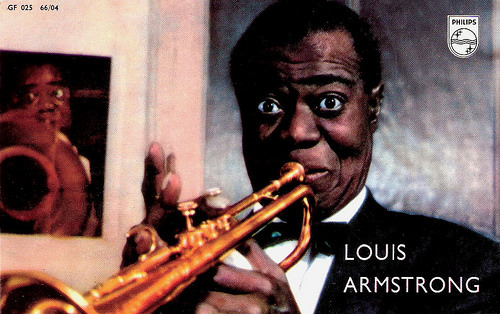
Dutch promotion card by Philips, no. GF 025 66/04.
One of the first truly popular African-American entertainers to 'cross over'
Louis Armstrong was also an influential singer, with his instantly recognisable gravelly voice. He demonstrated great mastery as an improviser, bending the lyrics and melody of a song for expressive purposes. He was also very skilled at scat singing.
Although his career as a recording artist dates back to the 1920s, when he made now-classic recordings with Joe 'King' Oliver, Bessie Smith and Jimmie Rodgers, as well as his own Hot Five and Hot Seven groups, his biggest hits as a recording artist came comparatively late in his life. Armstrong had nineteen Top Ten hits including When The Saints Go Marching In (1938), Mack the Knife (1955), Stompin' at the Savoy (1956) with Ella Fitzgerald, and What a Wonderful World (1967).
Armstrong's influence extends well beyond jazz, and by the end of his career in the 1960s, he was widely regarded as a profound influence on popular music in general. In 1964, Armstrong knocked The Beatles off the top of the Billboard Hot 100 chart with Hello, Dolly!, which gave the 63-year-old performer a U.S. record as the oldest artist to have a number one song.
Armstrong appeared in more than a dozen Hollywood films, usually playing a bandleader or musician. He appeared with Bing Crosby in the musical Pennies from Heaven (Norman Z. MacLeod, 1936), and with Mae West in Every Day's a Holiday (A. Edward Sutherland, 1937).
In the innovating musical Cabin in the Sky (Vincente Minnelli, Busby Berkeley, 1943) featuring an All Star, All Black cast, Louis played 'The Trumpeter' opposite Ethel Waters and Lena Horne. In 1947, he played himself opposite Billie Holiday in New Orleans (Arthur Lubin, 1947), which chronicled the demise of the Storyville district and the ensuing exodus of musicians from New Orleans to Chicago.
Armstrong also joined Danny Kaye and Virginia Mayo in the comedy A Song Is Born (Howard Hawks, 1948). The best parts of the film are the music scenes with Armstrong, Tommy Dorsey, Charlie Barnett, Lionel Hampton, and Benny Goodman, playing kick-arse Jazz. In The Glenn Miller Story (Anthony Mann, 1954), Armstrong jammed with Miller (James Stewart) and a few other noted musicians of the time.
His most familiar role was as the bandleader in the musical High Society (Charles Walters, 1956). He functions as a very partisan Greek Chorus , who tells you right up front who he's pulling for to win Grace Kelly and he helps musically along the way, performing a duet with Bing Crosby.
In The Five Pennies (Melville Shavelson, 1959), the story of the cornetist Red Nichols, Armstrong played himself as well as singing and playing several classic numbers. With leading actor Danny Kaye, Armstrong performed a duet of When the Saints Go Marching In, during which Kaye impersonated Armstrong.
He also appeared in several European films, including the Italian-French musical Saluti e baci/The Road to Happiness (Maurice Labro, Giorgio Simonelli, 1953) with Georges Guétary , the German musical Die Nacht vor der Premiere/The Night before the Premiere (Georg Jacoby, 1959) with Marika Rökk , and the Danish musical Kærlighedens melodi/The melody of love (Bent Christensen, 1959) with Nina and Frederik .
Armstrong was one of the first truly popular African-American entertainers to 'cross over', whose skin colour was secondary to his music in an America that was extremely racially divided at the time. He rarely publicly politicised his race, often to the dismay of fellow African Americans, but Armstrong was the only Black Jazz musician to publicly speak out against school segregation in 1957 during the Little Rock crisis. His artistry and personality allowed him access to the upper echelons of American society, then highly restricted for black men. Despite his fame, he remained a humble man and lived a simple life in a working-class neighbourhood.
Louis Armstrong remained married to Lucille Wilson until his death in 1971, a month away from what would have been his 70th birthday on 4 August. Embittered by the treatment of blacks in his hometown of New Orleans, he chose to be buried in New York City at the Flushing Cemetery, not too far from his home in Corona, Queens. He left his entire estate to his beloved wife, who died in 1983. Armstrong wrote two autobiographies. His house in Corona, where Armstrong lived for almost 28 years, was declared a National Historic Landmark in 1977. Today, it is a museum where fans can check out his residence and its belongings as a citizen of New York City.
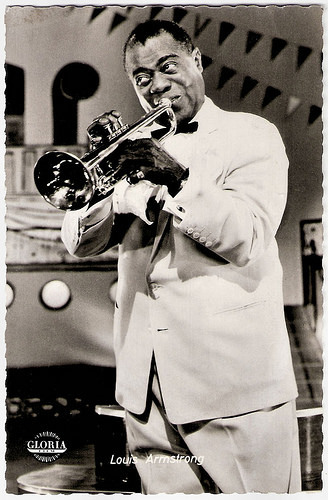
German postcard by Kolibri-Verlag, Minden/Westf., no. 765. no. CK-289. Photo: Alfa / Gloria / Kiebig. Publicity still for La Paloma (Paul Martin, 1959).
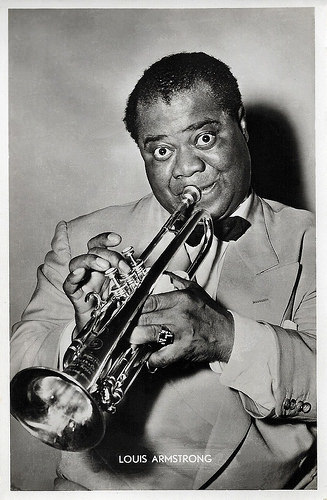
Vintage postcard, no. 111.
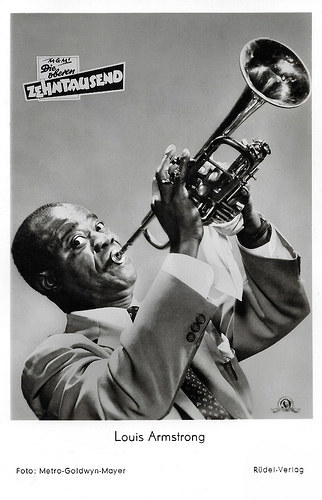
German postcard by Rüdel-Verlag, Hamburg-Bergedorf, no. 1988. Photo: MGM. Publicity still for High Society (Charles Walters, 1956). The German title of the film is Die oberen Zehntausend (The top ten thousand).
Sources: (IMDb), Louis Armstrong Educational Foundation, Wikipedia and .

French postcard by Editions P.I., Paris, no. CK-289. Photo: Arthur Grimm / Ufa.

German postcard by ISV, no. H 37.
Born in the Battlefield
Louis Daniel Armstrong was born in New Orleans, Louisiana, in the Storyville District known as 'the Battlefield' in 1901. His parents were Mary Albert and William Armstrong. William abandoned the family shortly after, and Louis grew up poor in a single-parent household. He left school at the 5th grade to help support his family. He sang on street corners, sold newspapers and delivered coal.
Louis was 13 when he celebrated New Year's Eve on 31 December 1912 by running out on the street and firing a blank from a pistol that belonged to the current man in his mother's life. He was arrested and placed in the Colored Waif's Home for boys. There, he learned to play the bugle cornet and the clarinet and joined the home's brass band. Armstrong's first teacher Peter Davis taught him there to read music. After 18 months, Louis left the Home determined to become a musician.
The young Armstrong played in brass bands and riverboats in New Orleans, first on an excursion boat in September 1918. At 18, he got a job in the Kid Ory Band in New Orleans. Armstrong married Daisy Parker as his career as a musician developed. In 1922, he followed his mentor, Joe 'King' Oliver, to Chicago to play in the Creole Jazz Band. He made his first recordings with that band in 1923. While in Chicago, Armstrong networked with other jazz musicians, reconnecting with his friend, Bix Biederbecke, and made new contacts, which included Hoagy Carmichael and Lil Hardin.
Lil was a graduate of Fisk University and an excellent pianist who could read, write and arrange music. She encouraged and enhanced Louis' career, and they married in 1924. Armstrong became very popular and one of the genre's most sought after trumpeters. He travelled a great deal and spent considerable time in Chicago and New York. He first moved to the Big Apple in 1924 to join Fletcher Henderson's Orchestra. He stayed in New York for a while but moved back to Chicago in October of 1925.
Armstrong later went back to New York in 1929. Armstrong appeared on Broadway in Hot Chocolates, in which he introduced Fats Waller's Ain't Misbehavin', his first popular song hit. During that time, some of his most important and successful work was accomplished with his Hot Fives and Hot Sevens Bands. Armstrong's interpretation of Hoagy Carmichael's Stardust became one of the most successful versions of this song ever recorded, showcasing Armstrong's unique vocal sound and style and his innovative approach to singing songs that had already become standards. In 1931, Armstrong appeared in his first film, Ex-Flame. That year, Armstrong and Lil Hardin separated and later divorced in 1938.
Dale O'Connor at IMDb : "He made a tour of Europe in 1932. During a command performance for King George V, he forgot he had been told that performers were not to refer to members of the royal family while playing for them. Just before picking up his trumpet for a really hot number, he announced: 'This one's for you, Rex.'" After this Grand Tour of Europe, Satchmo became Armstrong's nickname. A London music magazine editor had written erroneously 'Satchmo' in an article (Armstrong's nickname was 'Satchelmouth') and the name stuck.
In 1937, Armstrong substituted for Rudy Vallee on the CBS radio network and became the first African American to host a sponsored, national broadcast. After his divorce, Louis married Alpha Smith in 1938. While maintaining a vigorous work schedule, as well as living and travelling back and forth to Chicago and California, Armstrong moved back to New York in the late 1930s and later married Lucille Wilson in 1942.

Dutch postcard by N.V. Int. Filmpers (I.F.P.), Amsterdam, no. 1035. Photo: Joel Elkins. Louis Armstrong in the 1955 version of the All Stars, with Trummy Young on trombone and vocals, and Edmond Hall on clarinet and vocals.

Dutch postcard by Uitg. Takken, Utrecht, no. 3024. Photo: MGM. Publicity still for High Society (Charles Walters, 1956) with Bing Crosby.

Dutch promotion card by Philips, no. GF 025 66/04.
One of the first truly popular African-American entertainers to 'cross over'
Louis Armstrong was also an influential singer, with his instantly recognisable gravelly voice. He demonstrated great mastery as an improviser, bending the lyrics and melody of a song for expressive purposes. He was also very skilled at scat singing.
Although his career as a recording artist dates back to the 1920s, when he made now-classic recordings with Joe 'King' Oliver, Bessie Smith and Jimmie Rodgers, as well as his own Hot Five and Hot Seven groups, his biggest hits as a recording artist came comparatively late in his life. Armstrong had nineteen Top Ten hits including When The Saints Go Marching In (1938), Mack the Knife (1955), Stompin' at the Savoy (1956) with Ella Fitzgerald, and What a Wonderful World (1967).
Armstrong's influence extends well beyond jazz, and by the end of his career in the 1960s, he was widely regarded as a profound influence on popular music in general. In 1964, Armstrong knocked The Beatles off the top of the Billboard Hot 100 chart with Hello, Dolly!, which gave the 63-year-old performer a U.S. record as the oldest artist to have a number one song.
Armstrong appeared in more than a dozen Hollywood films, usually playing a bandleader or musician. He appeared with Bing Crosby in the musical Pennies from Heaven (Norman Z. MacLeod, 1936), and with Mae West in Every Day's a Holiday (A. Edward Sutherland, 1937).
In the innovating musical Cabin in the Sky (Vincente Minnelli, Busby Berkeley, 1943) featuring an All Star, All Black cast, Louis played 'The Trumpeter' opposite Ethel Waters and Lena Horne. In 1947, he played himself opposite Billie Holiday in New Orleans (Arthur Lubin, 1947), which chronicled the demise of the Storyville district and the ensuing exodus of musicians from New Orleans to Chicago.
Armstrong also joined Danny Kaye and Virginia Mayo in the comedy A Song Is Born (Howard Hawks, 1948). The best parts of the film are the music scenes with Armstrong, Tommy Dorsey, Charlie Barnett, Lionel Hampton, and Benny Goodman, playing kick-arse Jazz. In The Glenn Miller Story (Anthony Mann, 1954), Armstrong jammed with Miller (James Stewart) and a few other noted musicians of the time.
His most familiar role was as the bandleader in the musical High Society (Charles Walters, 1956). He functions as a very partisan Greek Chorus , who tells you right up front who he's pulling for to win Grace Kelly and he helps musically along the way, performing a duet with Bing Crosby.
In The Five Pennies (Melville Shavelson, 1959), the story of the cornetist Red Nichols, Armstrong played himself as well as singing and playing several classic numbers. With leading actor Danny Kaye, Armstrong performed a duet of When the Saints Go Marching In, during which Kaye impersonated Armstrong.
He also appeared in several European films, including the Italian-French musical Saluti e baci/The Road to Happiness (Maurice Labro, Giorgio Simonelli, 1953) with Georges Guétary , the German musical Die Nacht vor der Premiere/The Night before the Premiere (Georg Jacoby, 1959) with Marika Rökk , and the Danish musical Kærlighedens melodi/The melody of love (Bent Christensen, 1959) with Nina and Frederik .
Armstrong was one of the first truly popular African-American entertainers to 'cross over', whose skin colour was secondary to his music in an America that was extremely racially divided at the time. He rarely publicly politicised his race, often to the dismay of fellow African Americans, but Armstrong was the only Black Jazz musician to publicly speak out against school segregation in 1957 during the Little Rock crisis. His artistry and personality allowed him access to the upper echelons of American society, then highly restricted for black men. Despite his fame, he remained a humble man and lived a simple life in a working-class neighbourhood.
Louis Armstrong remained married to Lucille Wilson until his death in 1971, a month away from what would have been his 70th birthday on 4 August. Embittered by the treatment of blacks in his hometown of New Orleans, he chose to be buried in New York City at the Flushing Cemetery, not too far from his home in Corona, Queens. He left his entire estate to his beloved wife, who died in 1983. Armstrong wrote two autobiographies. His house in Corona, where Armstrong lived for almost 28 years, was declared a National Historic Landmark in 1977. Today, it is a museum where fans can check out his residence and its belongings as a citizen of New York City.

German postcard by Kolibri-Verlag, Minden/Westf., no. 765. no. CK-289. Photo: Alfa / Gloria / Kiebig. Publicity still for La Paloma (Paul Martin, 1959).

Vintage postcard, no. 111.

German postcard by Rüdel-Verlag, Hamburg-Bergedorf, no. 1988. Photo: MGM. Publicity still for High Society (Charles Walters, 1956). The German title of the film is Die oberen Zehntausend (The top ten thousand).
Sources: (IMDb), Louis Armstrong Educational Foundation, Wikipedia and .
Published on November 27, 2018 22:00
November 26, 2018
Mari Blanchard
Beautiful blonde American actress Mari Blanchard (1927–1970) was known for playing alluring harem girls and saloon dancers in American adventure films and Westerns of the 1950s and early 1960s. Blanchard was a B-movie queen who excelled at playing tarts, home wreckers, and other assorted villainesses.

Italian postcard by Bromofoto, no. 552. Photo: Universal International.
Running away from home to join the Circus
Mari (sometimes written as Mary) Blanchard was born in 1923, in Long Beach, California. Her father was an oil and mining tycoon; her mother, Dr. Mary Sennott, a psychotherapist.
Blanchard trained from childhood for a dancing career, but at the age of nine, she suffered from severe polio. She fought back against her illness and was walking again by age eleven. To exercise her once-paralysed limbs, she swam daily for several years afterwards.
At 17, she ran away from home to join the Cole Brothers Circus and learned how to ride elephants, perform bareback on horses and fly on the trapeze bar. Her mother found her and took her back home. She attended Santa Barbara State College, UCLA, and USC to study international law and graduated with a Bachelors Degree in International Law.
In the late 1940s, Mari joined the Conover Agency as an advertising model and was a successful model and film extra. In 1948, her beautiful blue-eyed brunette (later blonde) looks and 36-25-36 figure became the inspiration for cartoonist and writer Al Capp in creating the voluptuous Stupefyin' Jones character for his L'il Abner comics.
After she was seen by a Paramount producer in a bubble bath commercial ad for Kodak that appeared on the back of The Hollywood Reporter, she was offered a film contract. From 1951 to 1952, she took roles in a number of films at MGM, RKO, and Paramount, but was relegated to walk-ons and bit parts. I.S. Mowis at IMDb : "Ten Tall Men (1951), for example, limited her to a token stroll down a street, twirling a parasol and smiling seductively at members of the Foreign Legion."
In 1952, she was signed by Universal-International. There her fortunes improved somewhat. Her first film at the studio was Back at the Front (George Sherman, 1952) with Tom Ewell. In the romantic adventure The Veils of Bagdad (George Sherman, 1953) she co-starred with Victor Mature. One of her more memorable tongue-in-cheek exotic roles was the Venusian queen, Allura, in the comedy Abbott and Costello Go to Mars (Charles Lamont, 1953).
She starred with Audie Murphy in the Western Destry (George Marshall, 1954). I.S. Mowis at IMDb : "A remake of the classic Destry Rides Again (1939), she was cast in the Marlene Dietrich part and took great pains to affect a totally different look, darkening her hair, so as not to be compared to the great star. Even the name of her character was changed from 'Frenchy' to 'Brandy'. Destry was not all smooth sailing. There was tension between her and director George Marshall (who had also directed the original version) and Mari suffered a facial injury as the result of a fight scene. The film was critically well received." However, her contract was not renewed by Universal.
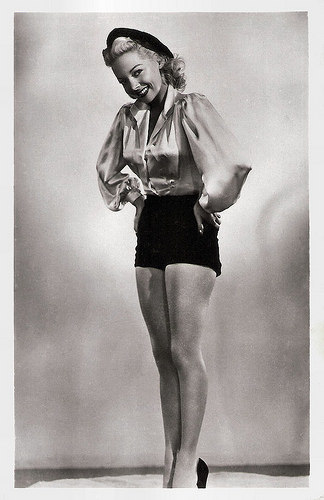
French postcard by Editions P.I., Paris, no. 609. Photo: Paramount Pictures, 1950.
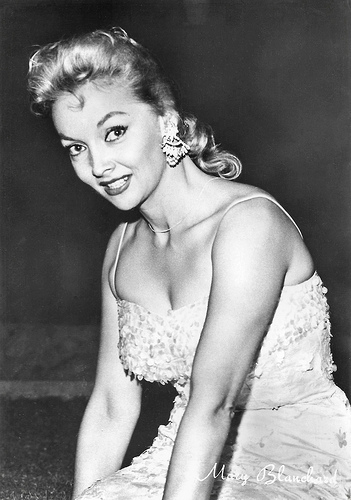
Italian postcard by Rotalfoto, Milano, no. 733.
Playing bad girls and ladies of ill-repute
Mari Blanchard worked for television and for minor studios. She continued to excel at playing bad girls and ladies of ill-repute. In Son of Sinbad (Ted Tetzlaff, 1955), she was one of the 127 women in ancient Baghdad who dazzled Dale Robertson as Sinbad - and of course the audiences.
On TV, she starred in episodes of such series as Climax! (1955) and Casablanca (1956). In the cinema, she starred as a female monster in the B-movie She Devil (Kurt Neumann, 1957). She played a TB victim injected with a serum turning her into a Mr. Hyde-like killer.
Then she was the love interest of Lex Barker in Jungle Heat (Howard W. Koch, 1957), shot on Kauai, Hawaii. A curiosity was her appearance in the Turkish film Karasu (Turgut Demirag, 1958). Following her work on these films, Blanchard began to focus increasingly on performing on television.
In the 1960–1961 television season, she starred as hotel-owner Kate O'Hara in the short lived Western series Klondike with James Coburn. She also guest-starred in episodes of Rawhide (1959-1961), 77 Sunset Strip (1961) and Perry Mason (1962).
Among her later films were the musical Don't Knock the Twist (Oscar Rudolph, 1962) with Chubby Checker and the horror film Twice-Told Tales (Sidney Salkow, 1963) starring Vincent Price. In 1963 she had a small but flamboyant role as the cheerful and likeable town madam Camille in the John Wayne Western McLintock! (Andrew V. McLaglen, 1963). It was her final film appearance.
Mari Blanchard was diagnosed with cancer. She retired, and acted only in a few TV programs when her cancer temporarily went into remission. Her last credited performance was in 1968, playing the part of Madame Gamar on the series It Takes a Thief. Following a struggle of seven years, Mari Blanchard died in 1970. She was only 43. In accordance with her wishes, her remains were cremated and scattered at sea.
Blanchard was married three times: to attorney Reese Hale Taylor, Jr. (1960-1961); George Shepard (1965-1966); and to photographer Vincent J. Conti (1967-1970). In the early to mid 1950s, she dated a string of men, including Greg Bautzer, once Joan Crawford's paramour. She dated Mel Torme before marrying photographer Vince Conti.
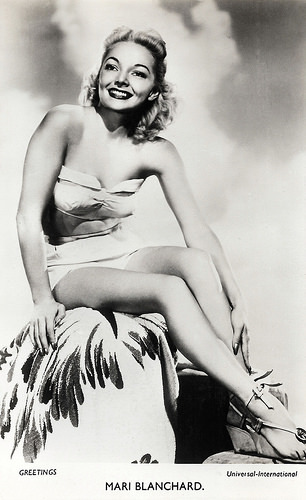
British card in the Greetings series. Photo: Universal-International.
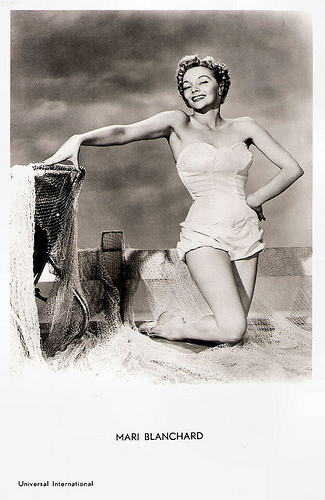
French postcard offered by Les Carbones Korès Carboplane, no. 308. Photo: Universal International.
Sources: (IMDb), Hal Erickson (AllMovie), Brian J. Walker (Brian's Drive-in Theater), William Bjornstad (Find A Grave), Glamour Girls of the Silver Screen, Wikipedia and IMDb.

Italian postcard by Bromofoto, no. 552. Photo: Universal International.
Running away from home to join the Circus
Mari (sometimes written as Mary) Blanchard was born in 1923, in Long Beach, California. Her father was an oil and mining tycoon; her mother, Dr. Mary Sennott, a psychotherapist.
Blanchard trained from childhood for a dancing career, but at the age of nine, she suffered from severe polio. She fought back against her illness and was walking again by age eleven. To exercise her once-paralysed limbs, she swam daily for several years afterwards.
At 17, she ran away from home to join the Cole Brothers Circus and learned how to ride elephants, perform bareback on horses and fly on the trapeze bar. Her mother found her and took her back home. She attended Santa Barbara State College, UCLA, and USC to study international law and graduated with a Bachelors Degree in International Law.
In the late 1940s, Mari joined the Conover Agency as an advertising model and was a successful model and film extra. In 1948, her beautiful blue-eyed brunette (later blonde) looks and 36-25-36 figure became the inspiration for cartoonist and writer Al Capp in creating the voluptuous Stupefyin' Jones character for his L'il Abner comics.
After she was seen by a Paramount producer in a bubble bath commercial ad for Kodak that appeared on the back of The Hollywood Reporter, she was offered a film contract. From 1951 to 1952, she took roles in a number of films at MGM, RKO, and Paramount, but was relegated to walk-ons and bit parts. I.S. Mowis at IMDb : "Ten Tall Men (1951), for example, limited her to a token stroll down a street, twirling a parasol and smiling seductively at members of the Foreign Legion."
In 1952, she was signed by Universal-International. There her fortunes improved somewhat. Her first film at the studio was Back at the Front (George Sherman, 1952) with Tom Ewell. In the romantic adventure The Veils of Bagdad (George Sherman, 1953) she co-starred with Victor Mature. One of her more memorable tongue-in-cheek exotic roles was the Venusian queen, Allura, in the comedy Abbott and Costello Go to Mars (Charles Lamont, 1953).
She starred with Audie Murphy in the Western Destry (George Marshall, 1954). I.S. Mowis at IMDb : "A remake of the classic Destry Rides Again (1939), she was cast in the Marlene Dietrich part and took great pains to affect a totally different look, darkening her hair, so as not to be compared to the great star. Even the name of her character was changed from 'Frenchy' to 'Brandy'. Destry was not all smooth sailing. There was tension between her and director George Marshall (who had also directed the original version) and Mari suffered a facial injury as the result of a fight scene. The film was critically well received." However, her contract was not renewed by Universal.

French postcard by Editions P.I., Paris, no. 609. Photo: Paramount Pictures, 1950.

Italian postcard by Rotalfoto, Milano, no. 733.
Playing bad girls and ladies of ill-repute
Mari Blanchard worked for television and for minor studios. She continued to excel at playing bad girls and ladies of ill-repute. In Son of Sinbad (Ted Tetzlaff, 1955), she was one of the 127 women in ancient Baghdad who dazzled Dale Robertson as Sinbad - and of course the audiences.
On TV, she starred in episodes of such series as Climax! (1955) and Casablanca (1956). In the cinema, she starred as a female monster in the B-movie She Devil (Kurt Neumann, 1957). She played a TB victim injected with a serum turning her into a Mr. Hyde-like killer.
Then she was the love interest of Lex Barker in Jungle Heat (Howard W. Koch, 1957), shot on Kauai, Hawaii. A curiosity was her appearance in the Turkish film Karasu (Turgut Demirag, 1958). Following her work on these films, Blanchard began to focus increasingly on performing on television.
In the 1960–1961 television season, she starred as hotel-owner Kate O'Hara in the short lived Western series Klondike with James Coburn. She also guest-starred in episodes of Rawhide (1959-1961), 77 Sunset Strip (1961) and Perry Mason (1962).
Among her later films were the musical Don't Knock the Twist (Oscar Rudolph, 1962) with Chubby Checker and the horror film Twice-Told Tales (Sidney Salkow, 1963) starring Vincent Price. In 1963 she had a small but flamboyant role as the cheerful and likeable town madam Camille in the John Wayne Western McLintock! (Andrew V. McLaglen, 1963). It was her final film appearance.
Mari Blanchard was diagnosed with cancer. She retired, and acted only in a few TV programs when her cancer temporarily went into remission. Her last credited performance was in 1968, playing the part of Madame Gamar on the series It Takes a Thief. Following a struggle of seven years, Mari Blanchard died in 1970. She was only 43. In accordance with her wishes, her remains were cremated and scattered at sea.
Blanchard was married three times: to attorney Reese Hale Taylor, Jr. (1960-1961); George Shepard (1965-1966); and to photographer Vincent J. Conti (1967-1970). In the early to mid 1950s, she dated a string of men, including Greg Bautzer, once Joan Crawford's paramour. She dated Mel Torme before marrying photographer Vince Conti.

British card in the Greetings series. Photo: Universal-International.

French postcard offered by Les Carbones Korès Carboplane, no. 308. Photo: Universal International.
Sources: (IMDb), Hal Erickson (AllMovie), Brian J. Walker (Brian's Drive-in Theater), William Bjornstad (Find A Grave), Glamour Girls of the Silver Screen, Wikipedia and IMDb.
Published on November 26, 2018 22:00
November 25, 2018
Jack Palance
Jack Palance (1919-2006) was an American actor and singer, who portrayed some of the most intensely despised villains witnessed in Westerns and melodramas of the 1950s. In the late 1950s, he became an international star, who often played in Spaghetti Westerns and in the Nouvelle Vague classic Le Mépris (1963) with Brigitte Bardot. He was nominated for three Academy Awards for Best Actor in a Supporting Role, winning an Oscar for his grizzled, eccentric role in City Slickers (1991).

Spanish postcard by Postalcolor, Hospitalet (Barcelona), no. 107. Photo: Warner Bros.
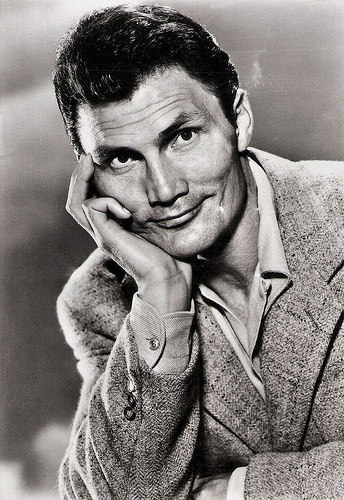
Spanish postcard by ANMAVI, no. 29.
Alan Ladd's biggest nightmare
Jack Palance was born Vladimir Ivanovich Palahniuk in Lattimer Mines, Pennsylvania, in 1919. He was one of the six children of Ukrainian immigrants, Anna (née Gramiak) and Ivan Palahniuk, an anthracite coal miner. After his father had died of black lung disease, the sensitive, artistic lad worked in coal mines before becoming a professional boxer in the late 1930s. Fighting under the name Jack Brazzo, Palance reportedly compiled a record of 15 consecutive victories with 12 knockouts before losing a close decision to future heavyweight contender Joe Baksi in a Pier-6 brawl.
With the outbreak of World War II, Palance's athletic career ended, and his military career began as a member of the United States Army Air Forces. He was honorably discharged from the United States Army Air Forces in 1944. After the war, he attended Stanford University, leaving one credit shy of graduating to pursue a career in the theatre. During his university years, he worked as a short order cook, waiter, soda jerk, lifeguard at Jones Beach State Park, and photographer's model. His new last name, Palance, was a derivative of his original name. No one could pronounce his last name and it was suggested that he be called Palanski. From that he decided just to use Palance instead.
In 1947, Palance made his Broadway debut in The Big, playing a Russian soldier, directed by Robert Montgomery. His acting break came as Marlon Brando 's understudy in A Streetcar Named Desire, and he eventually replaced Brando on stage as Stanley Kowalski. He debuted on television in 1949 and made his screen debut as a gangster in the Film Noir Panic in the Streets (Eliz Kazan, 1950). As a plague carrying fugitive, he stood out among a powerhouse cast including Richard Widmark and Paul Douglas.
The same year he made fine use of his former boxing skills and war experience for the film Halls of Montezuma (Lewis Milestone, 1951) about the United States Marines in World War II. He returned to Broadway for Darkness at Noon (1951), by Sidney Kingsley, which was a minor hit. Palance was second billed in just his third film, playing opposite Joan Crawford in the thriller Sudden Fear (David Miller, 1952). According to Gary Brumburgh at IMDb , Palance found “the right menace and intensity to pretty much steal the proceedings”, and he received an Oscar nomination for Best Supporting Actor.
He was nominated in the same category the following year as well, for his role as the hired gunfighter Jack Wilson in Shane (George Stevens, 1953). Brumburgh again: “arguably his finest villain of the decade, that of creepy, sadistic gunslinger Jack Wilson who becomes Alan Ladd's biggest nightmare (not to mention others) in the classic western Shane (1953). Their climactic showdown alone is text book.“ Shane was a huge hit and Palance was now established as a film name.
He played another villain in Second Chance (Rudolph Maté, 1953) opposite Robert Mitchum and was an Indian in Arrowhead (Charles Marquis Warren, 1953), opposite Charlton Heston. He got a chance to play a heroic role in the thriller Flight to Tangier (Charles Marquis Warren, 1953). Palance played the lead in Man in the Attic (Hugo Freegonese, 1953), a remake of The Lodger (1927), the classic silent film by Alfred Hitchcock. Palance was Attila the Hun in Sign of the Pagan (Douglas Sirk, 1954) with Jeff Chandler, and Simon Magus in the Ancient World epic The Silver Chalice (Victor Saville, 1954) with Paul Newman.
He had the star part in I Died a Thousand Times (Stuart Heisler, 1955), a remake of High Sierra and was cast by Robert Aldrich in two star parts: as a Hollywood star in the Film Noir The Big Knife (1955) based on the play by Clifford Odets; and as a tough WW II soldier in Attack (1956). He was in a Western, The Lonely Man (Henry Levin, 1957), playing the father of Anthony Perkins, and played a double role in House of Numbers (Russell Rouse, 1957). In 1957, Palance won an Emmy Award for best actor for his portrayal of Mountain McClintock in the Playhouse 90 production of Rod Serling's Requiem for a Heavyweight.
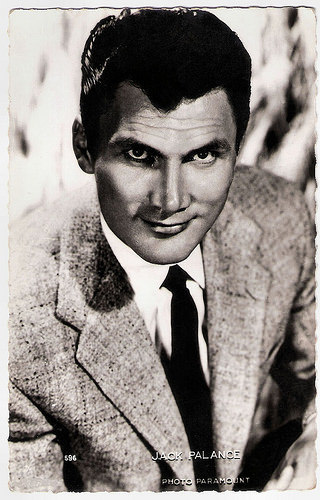
French postcard by P.I., no. 596, 1955. Photo: Paramount.
The Meanest Guy That Ever Lived
In the following years, Jack Palance became an international star. He was hired by British Warwick Films to play the hero in The Man Inside (John Gilling, 1958). He was reunited with Robert Aldrich and Jeff Chandler on Ten Seconds to Hell (1959) playing a bomb disposal expert, filmed in Germany. He made the drama Flor de Mayo/Beyond All Limits (Roberto Gavaldón, 1959), with Maria Felix , in Mexico, and Austerlitz (Abel Gance, 1960) in France.
Then he did a series of adventure films in Italy: Revak the Rebel/The Barbarians (Rudolph Maté, 1961) with Milly Vitale , Rosmunda e Alboino/Sword of the Conqueror (Carlo Campogalliani, 1961) with Eleonora Rossi-Drago , and I mongoli/The Mongols (Andre DeToth, Leopoldo Savona, 1961) opposite Anita Ekberg .
Next he appeared in the Commedia all'italiana Il giudizio universale/The Last Judgment (Vittorio De Sica, 1961) with Alberto Sordi , and the religious epic Barabbas (Richard Fleischer, 1961), starring Anthony Quinn . Jean-Luc Godard persuaded Palance to take on the role of Hollywood producer Jeremy Prokosch in the nouvelle vague movie Le Mépris/Contempt (1963) with Brigitte Bardot . Although the main dialogue was in French, Palance spoke mostly English.
Palance returned to the US to star in the TV series The Greatest Show on Earth (1963–1964). He played a gangster in Once a Thief (Ralph Thomas, 1965) with Alain Delon . He had a featured role opposite Lee Marvin and Burt Lancaster in the Western adventure The Professionals (Richard Brooks, 1966). He guest starred on The Man from UNCLE and the episodes were released as a film, The Spy in the Green Hat (1967). Palance went to England to do Torture Garden (Freddie Francis, 1967) and did Kill a Dragon (Michael D. Moore, 1968) in Hong Kong.
In 1969, Palance recorded a country music album in Nashville, released on Warner Bros. Records. It featured Palance's self-penned song The Meanest Guy That Ever Lived. His films continued to be international co-productions: They Came to Rob Las Vegas (Antonio Isasi-Isasmendi, 1968), the Zapata Western Il mercenario/The Mercenary (Sergio Corbucci, 1968) with Franco Nero , The Desperados (Henry Levin, 1969), and Justine ovvero le disavventure della virtù/Marquis de Sade: Justine (Jésus Franco, 1969), starring Klaus Kinski .
Palance had an excellent part in the Hollywood blockbuster Che! (Richard Fleischer, 1969) playing Fidel Castro opposite Omar Sharif in the title role but the film flopped. Palance went back to action films and Westerns like the Macaroni-War film La legione dei dannati/Battle of the Commandos (Umberto Lenzi, 1970), with Curd Jürgens , and the Zapata Western Companeros (Sergio Corbucci, 1970) with Franco Nero and Tomás Milián.
He had another good role in Monte Walsh (William A. Fraker, 1970), from the author of Shane, opposite Lee Marvin, but the film was a box office disappointment. So too was The Horsemen (John Frankenheimer, 1971) with Omar Sharif. Palance supported Bud Spencer in Si può fare... amigo/It Can Be Done Amigo (Maurizio Lucidi, 1972) and Charles Bronson in Chato's Land (Michael Winner, 1972) and had the lead in the Spaghetti Western Tedeum/Sting of the West (Enzo G. Castellari, 1972).
He returned to Hollywood for Oklahoma Crude (Stanley Kramer, 1973) with Faye Dunaway , and then went to England to star in Craze (Freddie Francis, 1974) opposite Diana Dors .
In the late 1970s Palance was mostly based in Italy. He supported Ursula Andress and Giuliano Gemma in Africa Express (Michele Lupo, 1976), Lee Van Cleef in Diamante Lobo/God's Gun (Gianfranco Parolini, 1976), and Thomas Milian in Squadra antiscippo/The Cop in Blue Jeans (Bruno Corbucci, 1976).
Palance was in the exploitation film Eva Nera/Black Cobra Woman (Joe D’Amato, 1976) with Laura Gemser. He travelled to Canada to make the virtual reality film Welcome to Blood City (Peter Sasdy, 1977) and the US for the slasher film Alone in the Dark (Jack Sholder, 1982).
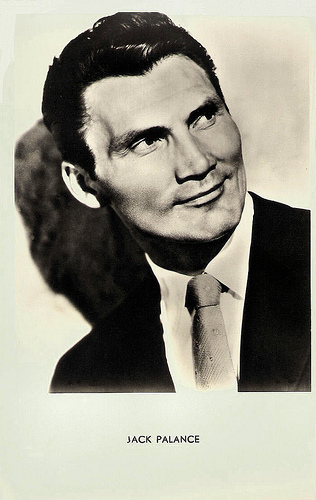
French postcard by Korès 'Carboplane', no. 328.
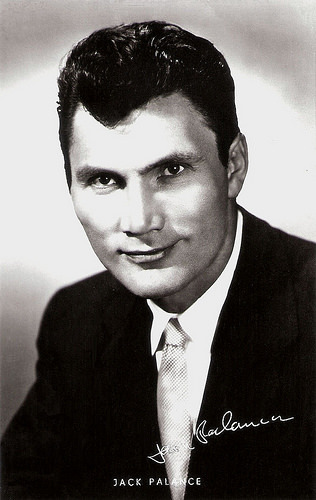
German postcard by Netter's Verlag, Berlin.
Billy Crystal... I crap bigger than him
In 1982, Jack Palance began hosting a television revival of Ripley's Believe It or Not!. The weekly series ran from 1982 to 1986 on the American ABC network. Palance had never been out of work since his career began. But his success on Ripley's Believe It or Not! and the international box-office hit of the German film Bagdad Cafe (Percy Adlon, 1987) resulted in a demand for his services in big budget Hollywood films.
He made memorable appearances as villains in Young Guns (Christopher Cain, 1988), Tango & Cash (Andrei Konchalovsky, 1989) and Batman (Tim Burton, 1989) starring Michael Keaton as Bruce Wayne/Batman and Jack Nicholson as the Joker.
In 1992, four decades after his film debut, Palance won an Academy Award for Best Supporting Actor for his performance as cowboy Curly Washburn in the comedy City Slickers (Ron Underwood, 1991). Stepping onstage to accept the award, the 6' 4" (1.93 m) actor looked down at 5' 7" (1.70 m) Oscar host Billy Crystal (also his co-star in the film), and joked, mimicking one of his lines from the film, "Billy Crystal... I crap bigger than him." He then dropped to the floor and demonstrated his ability, at age 73, to perform one-handed push-ups.
In 1993, during the opening of the Oscars, a spoof of that Oscar highlight featured Palance appearing to drag in an enormous Academy Award statuette with Crystal again hosting, riding on the rear end of it. Halfway across the stage, Palance dropped to the ground as if exhausted, but then performed several one-armed push-ups before regaining his feet and dragging the giant Oscar the rest of the way across the stage.
His later films include Cyborg 2 (Michael Schroeder, 1993) with Angelina Jolie, Cops & Robbersons (Michael Ritchie, 1994) with Chevy Chase, and City Slickers II: The Legend of Curly's Gold (Paul Weiland, 1994).
In 2003, he narrated the documentary Between Hitler and Stalin: Ukraine in World War II (Slavko Nowytski, 2003). In 2004, Palance, at the time chairman of the Hollywood Trident Foundation, walked out of a Russian Film Festival in Hollywood. After being introduced, Palance said, "I feel like I walked into the wrong room by mistake. I think that Russian film is interesting, but I have nothing to do with Russia or Russian film. My parents were born in Ukraine: I'm Ukrainian. I'm not Russian. So, excuse me, but I don't belong here."
Palance was awarded the title of ‘People's Artist’ by Vladimir Putin, president of Russia, but Palance refused the title. His final performance was in the TV film Back When We Were Grownups (Ron Underwood, 2004), opposite Blythe Danner.
Jack Palance was married to his first wife Virginia Baker from 1949 to 1968. They had three children: Holly (1950), Brooke (1952), and Cody (1955–1998). On New Year's Day 2003, Baker was struck and killed by a car in Los Angeles. Palance's daughter Brooke married Michael Wilding, son of Michael Wilding Sr. and Elizabeth Taylor ; they have three children. Cody Palance, an actor himself, appeared alongside his father in the film Young Guns. In 1987, Palance married his second wife Elaine Rogers.
In 2006, Jack Palance died of a sudden stroke at his daughter Holly's home in Montecito, California. He was 87.
Trailer Attack (1956). Source: Movieclips Classic Trailers (YouTube).
Trailer City Slickers (1991). Source: Trailer Chan (YouTube).
Sources: (IMDb), Wikipedia, and .

Spanish postcard by Postalcolor, Hospitalet (Barcelona), no. 107. Photo: Warner Bros.

Spanish postcard by ANMAVI, no. 29.
Alan Ladd's biggest nightmare
Jack Palance was born Vladimir Ivanovich Palahniuk in Lattimer Mines, Pennsylvania, in 1919. He was one of the six children of Ukrainian immigrants, Anna (née Gramiak) and Ivan Palahniuk, an anthracite coal miner. After his father had died of black lung disease, the sensitive, artistic lad worked in coal mines before becoming a professional boxer in the late 1930s. Fighting under the name Jack Brazzo, Palance reportedly compiled a record of 15 consecutive victories with 12 knockouts before losing a close decision to future heavyweight contender Joe Baksi in a Pier-6 brawl.
With the outbreak of World War II, Palance's athletic career ended, and his military career began as a member of the United States Army Air Forces. He was honorably discharged from the United States Army Air Forces in 1944. After the war, he attended Stanford University, leaving one credit shy of graduating to pursue a career in the theatre. During his university years, he worked as a short order cook, waiter, soda jerk, lifeguard at Jones Beach State Park, and photographer's model. His new last name, Palance, was a derivative of his original name. No one could pronounce his last name and it was suggested that he be called Palanski. From that he decided just to use Palance instead.
In 1947, Palance made his Broadway debut in The Big, playing a Russian soldier, directed by Robert Montgomery. His acting break came as Marlon Brando 's understudy in A Streetcar Named Desire, and he eventually replaced Brando on stage as Stanley Kowalski. He debuted on television in 1949 and made his screen debut as a gangster in the Film Noir Panic in the Streets (Eliz Kazan, 1950). As a plague carrying fugitive, he stood out among a powerhouse cast including Richard Widmark and Paul Douglas.
The same year he made fine use of his former boxing skills and war experience for the film Halls of Montezuma (Lewis Milestone, 1951) about the United States Marines in World War II. He returned to Broadway for Darkness at Noon (1951), by Sidney Kingsley, which was a minor hit. Palance was second billed in just his third film, playing opposite Joan Crawford in the thriller Sudden Fear (David Miller, 1952). According to Gary Brumburgh at IMDb , Palance found “the right menace and intensity to pretty much steal the proceedings”, and he received an Oscar nomination for Best Supporting Actor.
He was nominated in the same category the following year as well, for his role as the hired gunfighter Jack Wilson in Shane (George Stevens, 1953). Brumburgh again: “arguably his finest villain of the decade, that of creepy, sadistic gunslinger Jack Wilson who becomes Alan Ladd's biggest nightmare (not to mention others) in the classic western Shane (1953). Their climactic showdown alone is text book.“ Shane was a huge hit and Palance was now established as a film name.
He played another villain in Second Chance (Rudolph Maté, 1953) opposite Robert Mitchum and was an Indian in Arrowhead (Charles Marquis Warren, 1953), opposite Charlton Heston. He got a chance to play a heroic role in the thriller Flight to Tangier (Charles Marquis Warren, 1953). Palance played the lead in Man in the Attic (Hugo Freegonese, 1953), a remake of The Lodger (1927), the classic silent film by Alfred Hitchcock. Palance was Attila the Hun in Sign of the Pagan (Douglas Sirk, 1954) with Jeff Chandler, and Simon Magus in the Ancient World epic The Silver Chalice (Victor Saville, 1954) with Paul Newman.
He had the star part in I Died a Thousand Times (Stuart Heisler, 1955), a remake of High Sierra and was cast by Robert Aldrich in two star parts: as a Hollywood star in the Film Noir The Big Knife (1955) based on the play by Clifford Odets; and as a tough WW II soldier in Attack (1956). He was in a Western, The Lonely Man (Henry Levin, 1957), playing the father of Anthony Perkins, and played a double role in House of Numbers (Russell Rouse, 1957). In 1957, Palance won an Emmy Award for best actor for his portrayal of Mountain McClintock in the Playhouse 90 production of Rod Serling's Requiem for a Heavyweight.

French postcard by P.I., no. 596, 1955. Photo: Paramount.
The Meanest Guy That Ever Lived
In the following years, Jack Palance became an international star. He was hired by British Warwick Films to play the hero in The Man Inside (John Gilling, 1958). He was reunited with Robert Aldrich and Jeff Chandler on Ten Seconds to Hell (1959) playing a bomb disposal expert, filmed in Germany. He made the drama Flor de Mayo/Beyond All Limits (Roberto Gavaldón, 1959), with Maria Felix , in Mexico, and Austerlitz (Abel Gance, 1960) in France.
Then he did a series of adventure films in Italy: Revak the Rebel/The Barbarians (Rudolph Maté, 1961) with Milly Vitale , Rosmunda e Alboino/Sword of the Conqueror (Carlo Campogalliani, 1961) with Eleonora Rossi-Drago , and I mongoli/The Mongols (Andre DeToth, Leopoldo Savona, 1961) opposite Anita Ekberg .
Next he appeared in the Commedia all'italiana Il giudizio universale/The Last Judgment (Vittorio De Sica, 1961) with Alberto Sordi , and the religious epic Barabbas (Richard Fleischer, 1961), starring Anthony Quinn . Jean-Luc Godard persuaded Palance to take on the role of Hollywood producer Jeremy Prokosch in the nouvelle vague movie Le Mépris/Contempt (1963) with Brigitte Bardot . Although the main dialogue was in French, Palance spoke mostly English.
Palance returned to the US to star in the TV series The Greatest Show on Earth (1963–1964). He played a gangster in Once a Thief (Ralph Thomas, 1965) with Alain Delon . He had a featured role opposite Lee Marvin and Burt Lancaster in the Western adventure The Professionals (Richard Brooks, 1966). He guest starred on The Man from UNCLE and the episodes were released as a film, The Spy in the Green Hat (1967). Palance went to England to do Torture Garden (Freddie Francis, 1967) and did Kill a Dragon (Michael D. Moore, 1968) in Hong Kong.
In 1969, Palance recorded a country music album in Nashville, released on Warner Bros. Records. It featured Palance's self-penned song The Meanest Guy That Ever Lived. His films continued to be international co-productions: They Came to Rob Las Vegas (Antonio Isasi-Isasmendi, 1968), the Zapata Western Il mercenario/The Mercenary (Sergio Corbucci, 1968) with Franco Nero , The Desperados (Henry Levin, 1969), and Justine ovvero le disavventure della virtù/Marquis de Sade: Justine (Jésus Franco, 1969), starring Klaus Kinski .
Palance had an excellent part in the Hollywood blockbuster Che! (Richard Fleischer, 1969) playing Fidel Castro opposite Omar Sharif in the title role but the film flopped. Palance went back to action films and Westerns like the Macaroni-War film La legione dei dannati/Battle of the Commandos (Umberto Lenzi, 1970), with Curd Jürgens , and the Zapata Western Companeros (Sergio Corbucci, 1970) with Franco Nero and Tomás Milián.
He had another good role in Monte Walsh (William A. Fraker, 1970), from the author of Shane, opposite Lee Marvin, but the film was a box office disappointment. So too was The Horsemen (John Frankenheimer, 1971) with Omar Sharif. Palance supported Bud Spencer in Si può fare... amigo/It Can Be Done Amigo (Maurizio Lucidi, 1972) and Charles Bronson in Chato's Land (Michael Winner, 1972) and had the lead in the Spaghetti Western Tedeum/Sting of the West (Enzo G. Castellari, 1972).
He returned to Hollywood for Oklahoma Crude (Stanley Kramer, 1973) with Faye Dunaway , and then went to England to star in Craze (Freddie Francis, 1974) opposite Diana Dors .
In the late 1970s Palance was mostly based in Italy. He supported Ursula Andress and Giuliano Gemma in Africa Express (Michele Lupo, 1976), Lee Van Cleef in Diamante Lobo/God's Gun (Gianfranco Parolini, 1976), and Thomas Milian in Squadra antiscippo/The Cop in Blue Jeans (Bruno Corbucci, 1976).
Palance was in the exploitation film Eva Nera/Black Cobra Woman (Joe D’Amato, 1976) with Laura Gemser. He travelled to Canada to make the virtual reality film Welcome to Blood City (Peter Sasdy, 1977) and the US for the slasher film Alone in the Dark (Jack Sholder, 1982).

French postcard by Korès 'Carboplane', no. 328.

German postcard by Netter's Verlag, Berlin.
Billy Crystal... I crap bigger than him
In 1982, Jack Palance began hosting a television revival of Ripley's Believe It or Not!. The weekly series ran from 1982 to 1986 on the American ABC network. Palance had never been out of work since his career began. But his success on Ripley's Believe It or Not! and the international box-office hit of the German film Bagdad Cafe (Percy Adlon, 1987) resulted in a demand for his services in big budget Hollywood films.
He made memorable appearances as villains in Young Guns (Christopher Cain, 1988), Tango & Cash (Andrei Konchalovsky, 1989) and Batman (Tim Burton, 1989) starring Michael Keaton as Bruce Wayne/Batman and Jack Nicholson as the Joker.
In 1992, four decades after his film debut, Palance won an Academy Award for Best Supporting Actor for his performance as cowboy Curly Washburn in the comedy City Slickers (Ron Underwood, 1991). Stepping onstage to accept the award, the 6' 4" (1.93 m) actor looked down at 5' 7" (1.70 m) Oscar host Billy Crystal (also his co-star in the film), and joked, mimicking one of his lines from the film, "Billy Crystal... I crap bigger than him." He then dropped to the floor and demonstrated his ability, at age 73, to perform one-handed push-ups.
In 1993, during the opening of the Oscars, a spoof of that Oscar highlight featured Palance appearing to drag in an enormous Academy Award statuette with Crystal again hosting, riding on the rear end of it. Halfway across the stage, Palance dropped to the ground as if exhausted, but then performed several one-armed push-ups before regaining his feet and dragging the giant Oscar the rest of the way across the stage.
His later films include Cyborg 2 (Michael Schroeder, 1993) with Angelina Jolie, Cops & Robbersons (Michael Ritchie, 1994) with Chevy Chase, and City Slickers II: The Legend of Curly's Gold (Paul Weiland, 1994).
In 2003, he narrated the documentary Between Hitler and Stalin: Ukraine in World War II (Slavko Nowytski, 2003). In 2004, Palance, at the time chairman of the Hollywood Trident Foundation, walked out of a Russian Film Festival in Hollywood. After being introduced, Palance said, "I feel like I walked into the wrong room by mistake. I think that Russian film is interesting, but I have nothing to do with Russia or Russian film. My parents were born in Ukraine: I'm Ukrainian. I'm not Russian. So, excuse me, but I don't belong here."
Palance was awarded the title of ‘People's Artist’ by Vladimir Putin, president of Russia, but Palance refused the title. His final performance was in the TV film Back When We Were Grownups (Ron Underwood, 2004), opposite Blythe Danner.
Jack Palance was married to his first wife Virginia Baker from 1949 to 1968. They had three children: Holly (1950), Brooke (1952), and Cody (1955–1998). On New Year's Day 2003, Baker was struck and killed by a car in Los Angeles. Palance's daughter Brooke married Michael Wilding, son of Michael Wilding Sr. and Elizabeth Taylor ; they have three children. Cody Palance, an actor himself, appeared alongside his father in the film Young Guns. In 1987, Palance married his second wife Elaine Rogers.
In 2006, Jack Palance died of a sudden stroke at his daughter Holly's home in Montecito, California. He was 87.
Trailer Attack (1956). Source: Movieclips Classic Trailers (YouTube).
Trailer City Slickers (1991). Source: Trailer Chan (YouTube).
Sources: (IMDb), Wikipedia, and .
Published on November 25, 2018 22:00
November 24, 2018
Marie Prevost
Beautiful Marie Prevost (1898-1937) was an American silent screen actress. She started out as one of Mack Sennett's bathing beauties, but after signing a contract with Universal she publicly burned her bathing suit. She became a popular star with sophisticated comedies as The Beautiful and the Damned (1922) and Ernst Lubitsch's The Marriage Circle (1924), but her life ended in tragedy.
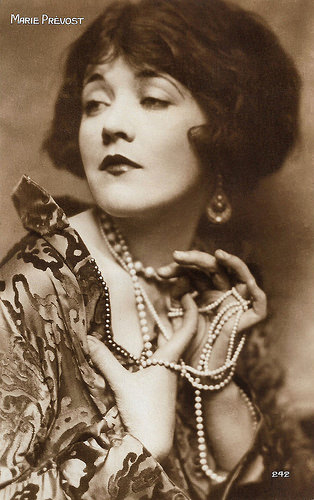
French postcard by Cinémagazine-Edition, no. 242.
A 'French' Bathing Beauty
Marie Prevost was born in 1897 in Sarnia, Ontario, Canada, as Mary Bickford Dunn. She was the daughter of Hughlina Marion (née Bickford) and Arthur 'Teddy' Dunn. Her father worked as a railroad conductor. When Mary was an infant, he was killed when gas seeped into the St. Clair Tunnel. Hughlina later married Frank Prevost. Her sister was the future actress Peggy Prevost. Both were still children when the family moved to the US. First, the family settled in Denver, Colorado, then in Los Angeles.
By 1915, Mary landed a job as a a stenographer at a law firm which represented the Keystone Film Company. While running an office errand at the Keystone Studios, Prevost was asked to appear in a bit part for the short film His Father's Footsteps (1915). Keystone's owner, Mack Sennett, also of Canadian origin, entrusted her with the role of an exotic 'French girl' and inserted her into his Bathing Beauties, with the stage name of Marie Prevost.
In 1919, Marie was secretly married to Sonny Gerke, a young man from high society, but the marriage failed after only six months, because Gerke did not have the courage to tell his mother that he had married an actress. Fearful of the bad publicity resulting from a divorce, Marie remained married until 1923, always keeping everyone unaware of her marriage.
At Keystone, Marie appeared in series of small roles as a young, innocent sexy girl. In 1919, Sennett cast Prevost in her first bigger role in Yankee Doodle in Berlin (Frank Richard Jones, 1919). The film was a hit and helped to solidify Prevost's career. Another successful film was Love, Honor, and Behave (Richard Jones, Erle Kenton, 1920), alongside another Sennett protege, George O'Hara.
In 1921, Marie signed a contract with Universal after getting the attention of Irving Thalberg. Thalberg decided to make her a star and organised a great advertising hype for her. He announced that Marie would star in two films, The Moonlight Follies (King Baggot, 1921) and Kissed (King Baggot, 1922), and sent her to Coney Island. There the actress publicly burned her bathing suit, signifying the end of her 'bathing' days.
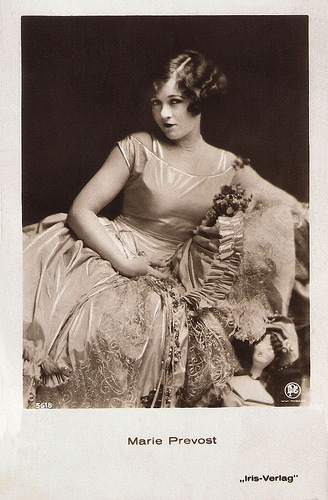
Austrian postcard by Iris-Verlag, no. 5618. Photo: PMC / Verleih Mondial.
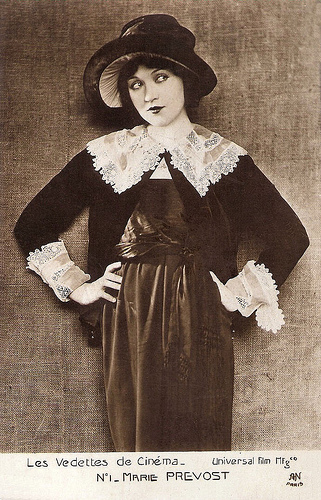
French postcard by A.N., Paris in the Les vedettes de cinéma, series, no. 1. Photo: Universal Film.
The Marriage Circle
At Universal, Marie Prevost only got light comedy roles. When the contract expired, Jack Warner had her signed for Warner Bros, recognising $ 1,500 a week. Alongside actor Kenneth Harlan as Tony, Marie played Gloria in The Beautiful and the Damned (Sidney Franklin, 1922), based on F. Scott Fitzgerald's bestseller on two idle spendthrifts who do not know how to cope with money running out.
To publicise the film, the production company announced that the actors would get married during filming on the set. The advertising launch worked and the studios were flooded with letters and gifts for the spouses. But when in the Los Angeles Mirror the story of Prevost's earlier secret marriage appeared: "Marie Prevost will become bigamist if she marries Harlan", Warner immediately took charge of the annulment of that marriage, so Harlan and Marie could marry.
Despite the bad publicity, The Beautiful and Damned was successful. By consequence, Ernst Lubitsch wanted Marie as the beautiful seductress for his film The Marriage Circle (1924), with Adolphe Menjou . Lubitsch said that Prevost was one of the few actresses in Hollywood who knew how to underplay comedy to achieve the maximum effect. He also cast her in Three Women (Ernst Lubitsch, 1924) with May McAvoy and Pauline Frederick, and Kiss Me Again (Ernst Lubitsch, 1925) with Monte Blue, and Clara Bow.
At Warner's in the mid-1920s, Prevost would star in comedies and dramas with Harrison Ford [the silent actor], Monte Blue, Matt Moore, Douglas Fairbanks jr. , and Harlan. In 1926, Warner decided not to prolong the contracts of Harlan and Marie Prevost.
Marie also lost her mother, who was travelling to Palm Beach, Florida, with actress Vera Steadman and producer Al Christie, when their car overturned. Hughina was crushed by the vehicle and died at the scene. Steadman and Christie both sustained serious injuries, but survived. Devastated by her mother's death and losing her work, Marie's marriage deteriorated, she began to drink and soon slipped into alcoholism.
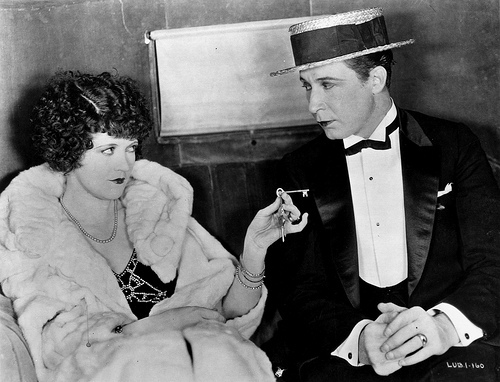
Photo of The Marriage Circle (Ernst Lubitsch, 1924) with Monte Blue. Collection: The Island of Cinema @ Flickr.
She was a winner/Who became her doggie's dinner
In 1927, Marie Prevost separated from her second husband, and despite a reconciliation in between, she divorced him altogether in 1929. To overcome the crisis, Prevost threw herself completely at work. After seeing her in The Beautiful and Damned, in 1928 Howard Hughes wanted her to star in The Racket. The two had a brief relationship but Hughes soon left her and Marie fell into a deepening depression. The Racket (Lewis Milestone, 1928) would be her last leading role in a feature film.
With the advent of sound her thick New England accent didn't lend itself well to the 'demon microphone'. Hal Erickson at AllMovie: "Talking pictures forced Prevost to alter her image; her nasal, high-pitched voice was more suited to wisecracking chorus girls or gum-chewing receptionists than pampered society wives."
In 1929, Cecil B. DeMille offered her a co-starring role in his final silent film The Godless Girl, starring Lina Basquette. Prevost received generally good reviews for her role in the film. In 1930, she appeared in Paid (Sam Wood, 1930), starring Joan Crawford. While Prevost's role was secondary, she still garnered good reviews.
At MGM, Prevost played Academy Award winner Helen Hayes' loyal friend in The Sin of Madelon Claudet (Edgar Selwyn, 1931), and was one of the three leads in the film Three Wise Girls (William Beaudine, 1932), with Jean Harlow. She began to gain weight and could no longer control either food or alcohol.
By 1934, Marie had no work at all and her financial situation deteriorated dramatically. She did a last good supporting part as Carole Lombard's manicurist chum in Hands Across the Table (1936). Her final film appearance was a bit part as a waitress in the action-drama Ten Laps to Go (Elmer Clifton, 1936-1938). To find work again, she faced drastic diets that further weakened her. In 1937, Marie Prevost died of a heart attack due to malnutrition and acute alcoholism. She was only 38.
Her body was found only two days later, due to the continuous and insistent barking of her dachshund dog. A bellhop came into the house and found her lying face down on the bed. Prevost's death was featured in Hollywood Babylon by Kenneth Anger. In the book, Anger falsely claimed Prevost's dachshund consumed her remains to survive. Musician Nick Lowe used details of her life and Anger's account of her death for his song Marie Prevost (1978) including the lyric in the chorus "She was a winner/Who became her doggie's dinner". According to IMDb however, Prevost only had some scratches on her hand where her dog had been pulling at her, probably to try to get her attention.
The funeral at the Memorial Cemetery in Hollywood was paid by Joan Crawford: in addition to Crawford, Clark Gable, Wallace Beery and Barbara Stanwyck participated. Her poor case prompted the Hollywood community to create in the early 1940s the Motion Picture & Television Country House and Hospital to provide medical care for employees of the television and motion picture industry.
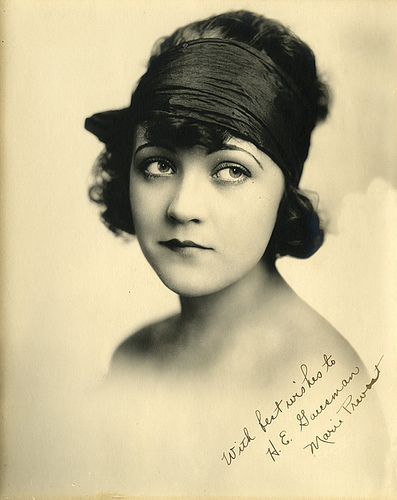
Collection: Grudnick @ Flickr.
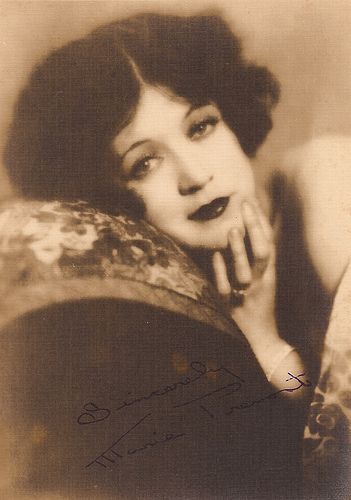
Collection: Charissa @ Flickr.
Sources: Hal Erickson (AllMovie), (IMDb), Wikipedia (Italian and English) and .

French postcard by Cinémagazine-Edition, no. 242.
A 'French' Bathing Beauty
Marie Prevost was born in 1897 in Sarnia, Ontario, Canada, as Mary Bickford Dunn. She was the daughter of Hughlina Marion (née Bickford) and Arthur 'Teddy' Dunn. Her father worked as a railroad conductor. When Mary was an infant, he was killed when gas seeped into the St. Clair Tunnel. Hughlina later married Frank Prevost. Her sister was the future actress Peggy Prevost. Both were still children when the family moved to the US. First, the family settled in Denver, Colorado, then in Los Angeles.
By 1915, Mary landed a job as a a stenographer at a law firm which represented the Keystone Film Company. While running an office errand at the Keystone Studios, Prevost was asked to appear in a bit part for the short film His Father's Footsteps (1915). Keystone's owner, Mack Sennett, also of Canadian origin, entrusted her with the role of an exotic 'French girl' and inserted her into his Bathing Beauties, with the stage name of Marie Prevost.
In 1919, Marie was secretly married to Sonny Gerke, a young man from high society, but the marriage failed after only six months, because Gerke did not have the courage to tell his mother that he had married an actress. Fearful of the bad publicity resulting from a divorce, Marie remained married until 1923, always keeping everyone unaware of her marriage.
At Keystone, Marie appeared in series of small roles as a young, innocent sexy girl. In 1919, Sennett cast Prevost in her first bigger role in Yankee Doodle in Berlin (Frank Richard Jones, 1919). The film was a hit and helped to solidify Prevost's career. Another successful film was Love, Honor, and Behave (Richard Jones, Erle Kenton, 1920), alongside another Sennett protege, George O'Hara.
In 1921, Marie signed a contract with Universal after getting the attention of Irving Thalberg. Thalberg decided to make her a star and organised a great advertising hype for her. He announced that Marie would star in two films, The Moonlight Follies (King Baggot, 1921) and Kissed (King Baggot, 1922), and sent her to Coney Island. There the actress publicly burned her bathing suit, signifying the end of her 'bathing' days.

Austrian postcard by Iris-Verlag, no. 5618. Photo: PMC / Verleih Mondial.

French postcard by A.N., Paris in the Les vedettes de cinéma, series, no. 1. Photo: Universal Film.
The Marriage Circle
At Universal, Marie Prevost only got light comedy roles. When the contract expired, Jack Warner had her signed for Warner Bros, recognising $ 1,500 a week. Alongside actor Kenneth Harlan as Tony, Marie played Gloria in The Beautiful and the Damned (Sidney Franklin, 1922), based on F. Scott Fitzgerald's bestseller on two idle spendthrifts who do not know how to cope with money running out.
To publicise the film, the production company announced that the actors would get married during filming on the set. The advertising launch worked and the studios were flooded with letters and gifts for the spouses. But when in the Los Angeles Mirror the story of Prevost's earlier secret marriage appeared: "Marie Prevost will become bigamist if she marries Harlan", Warner immediately took charge of the annulment of that marriage, so Harlan and Marie could marry.
Despite the bad publicity, The Beautiful and Damned was successful. By consequence, Ernst Lubitsch wanted Marie as the beautiful seductress for his film The Marriage Circle (1924), with Adolphe Menjou . Lubitsch said that Prevost was one of the few actresses in Hollywood who knew how to underplay comedy to achieve the maximum effect. He also cast her in Three Women (Ernst Lubitsch, 1924) with May McAvoy and Pauline Frederick, and Kiss Me Again (Ernst Lubitsch, 1925) with Monte Blue, and Clara Bow.
At Warner's in the mid-1920s, Prevost would star in comedies and dramas with Harrison Ford [the silent actor], Monte Blue, Matt Moore, Douglas Fairbanks jr. , and Harlan. In 1926, Warner decided not to prolong the contracts of Harlan and Marie Prevost.
Marie also lost her mother, who was travelling to Palm Beach, Florida, with actress Vera Steadman and producer Al Christie, when their car overturned. Hughina was crushed by the vehicle and died at the scene. Steadman and Christie both sustained serious injuries, but survived. Devastated by her mother's death and losing her work, Marie's marriage deteriorated, she began to drink and soon slipped into alcoholism.

Photo of The Marriage Circle (Ernst Lubitsch, 1924) with Monte Blue. Collection: The Island of Cinema @ Flickr.
She was a winner/Who became her doggie's dinner
In 1927, Marie Prevost separated from her second husband, and despite a reconciliation in between, she divorced him altogether in 1929. To overcome the crisis, Prevost threw herself completely at work. After seeing her in The Beautiful and Damned, in 1928 Howard Hughes wanted her to star in The Racket. The two had a brief relationship but Hughes soon left her and Marie fell into a deepening depression. The Racket (Lewis Milestone, 1928) would be her last leading role in a feature film.
With the advent of sound her thick New England accent didn't lend itself well to the 'demon microphone'. Hal Erickson at AllMovie: "Talking pictures forced Prevost to alter her image; her nasal, high-pitched voice was more suited to wisecracking chorus girls or gum-chewing receptionists than pampered society wives."
In 1929, Cecil B. DeMille offered her a co-starring role in his final silent film The Godless Girl, starring Lina Basquette. Prevost received generally good reviews for her role in the film. In 1930, she appeared in Paid (Sam Wood, 1930), starring Joan Crawford. While Prevost's role was secondary, she still garnered good reviews.
At MGM, Prevost played Academy Award winner Helen Hayes' loyal friend in The Sin of Madelon Claudet (Edgar Selwyn, 1931), and was one of the three leads in the film Three Wise Girls (William Beaudine, 1932), with Jean Harlow. She began to gain weight and could no longer control either food or alcohol.
By 1934, Marie had no work at all and her financial situation deteriorated dramatically. She did a last good supporting part as Carole Lombard's manicurist chum in Hands Across the Table (1936). Her final film appearance was a bit part as a waitress in the action-drama Ten Laps to Go (Elmer Clifton, 1936-1938). To find work again, she faced drastic diets that further weakened her. In 1937, Marie Prevost died of a heart attack due to malnutrition and acute alcoholism. She was only 38.
Her body was found only two days later, due to the continuous and insistent barking of her dachshund dog. A bellhop came into the house and found her lying face down on the bed. Prevost's death was featured in Hollywood Babylon by Kenneth Anger. In the book, Anger falsely claimed Prevost's dachshund consumed her remains to survive. Musician Nick Lowe used details of her life and Anger's account of her death for his song Marie Prevost (1978) including the lyric in the chorus "She was a winner/Who became her doggie's dinner". According to IMDb however, Prevost only had some scratches on her hand where her dog had been pulling at her, probably to try to get her attention.
The funeral at the Memorial Cemetery in Hollywood was paid by Joan Crawford: in addition to Crawford, Clark Gable, Wallace Beery and Barbara Stanwyck participated. Her poor case prompted the Hollywood community to create in the early 1940s the Motion Picture & Television Country House and Hospital to provide medical care for employees of the television and motion picture industry.

Collection: Grudnick @ Flickr.

Collection: Charissa @ Flickr.
Sources: Hal Erickson (AllMovie), (IMDb), Wikipedia (Italian and English) and .
Published on November 24, 2018 22:00
Paul van Yperen's Blog
- Paul van Yperen's profile
- 13 followers
Paul van Yperen isn't a Goodreads Author
(yet),
but they
do have a blog,
so here are some recent posts imported from
their feed.



